




Editor: Edward Rosenthal
Bloodstock Editor: Nancy Sexton Design/production: Thoroughbred Group
Editorial: 12 Forbury Road, Reading, Berkshire RG1 1SB editor@ownerbreeder.co.uk www.theownerbreeder.com
X: @TheOwnerBreeder Instagram: theownerbreeder
Advertising: Giles Anderson
UK: 01380 816777
IRE: 041 971 2000 USA: 1 888 218 4430 advertise@anderson-co.com
Subscriptions: Keely Brewer subscriptions@ownerbreeder.co.uk 01183 385 686
The Owner Breeder can be purchased by non-members at the following rates:
1 Year UK £60 Europe £90 RoW £120
The Owner Breeder is owned by the Racehorse Owners Association
Editorial views expressed in this magazine are not necessarily those of the ROA or TBA
Our monthly average readership is 20,000
Racehorse Owners Association Ltd 12 Forbury Road, Reading, Berkshire RG1 1SB Tel: 01183 385680 info@roa.co.uk • www.roa.co.uk
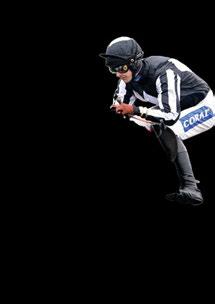
When I became Editor of Owner Breeder at the end of 2009, I knew immediately who I wanted to feature in my first issue: the Aga Khan.
I asked Julian Muscat to find out whether His Highness would be interested in talking to the magazine – Julian’s response, if I recall correctly, was somewhat downbeat, unsure if such an interview could be arranged.
As it turned out, Julian did manage to get the piece done – I seem to remember he was due to fly out to Switzerland before bad weather forced that plan to be abandoned –turning in a truly fascinating article celebrating the Aga Khan’s 50 years at the helm of his family’s bloodstock business.
One thing I was keen to discover was why he had ceased having his horses trained in Britain. The Aga Khan, who continued to have runners in the big races here, explained that there should be regular dialogue between the racing and breeding sides, something that wasn’t happening on these shores where he didn’t operate a stud.
“In France there is this [close] relationship, and we have a similar operation in Ireland,” the Aga Khan said. “There used to be a situation where the racing end and the breeding end didn’t always consult each other as much as I think was necessary. This is perhaps part of our strength at the present time.”
He continued: “The English Classics establish quality benchmarks which traditional breeders want to maintain year after year. Of all the races in Europe, they are the ones that add commercial value.”
To me, the Aga Khan’s operation, more than any other, epitomised breeding excellence – he consistently produced high-class horses that could compete in the best races, with a focus on three-year-old careers and Classic contests. In essence, he was the ultimate owner-breeder.
His passing last month aged 88 will usher in a new era for the Aga Khan Studs although his
Edward Rosenthal Editor

daughter, Princess Zahra Aga Khan, has been heavily involved in the business for some years, leading the management team in charge of running operations in France and Ireland.
There was plenty of other sad news about in February, with the tragic death of Michael O’Sullivan aged 24 hitting the sport hard on both sides of the Irish Sea.
O’Sullivan’s star blazed briefly but brightly – he made his mark in the handful of seasons he rode under Rules, displaying a rare talent and coolness in the saddle that belied his tender years.
John Hales, who has died aged 85, was one of jump racing’s best-known owners, rarely
“He produced highclass horses that could compete in the best races”
missing an opportunity to watch his runners at the races – and with the quality of horses he possessed, it’s perhaps not surprising he retained his enthusiasm for the sport well into his ninth decade.
One Man, Azertyuiop and Neptune Collonges all provided headline moments on the big stage in his familiar yellow colours, while in recent times Hales enjoyed owning in partnership with friends including Sir Alex Ferguson and Ged Mason.
O’Sullivan, Hales and Joe Saumarez Smith, the former Chair of the British Horseracing Authority who died in February aged 53 – he was a ferocious and successful punter in his pre-BHA days – are sure to be in many people’s thoughts at this month’s Cheltenham Festival.
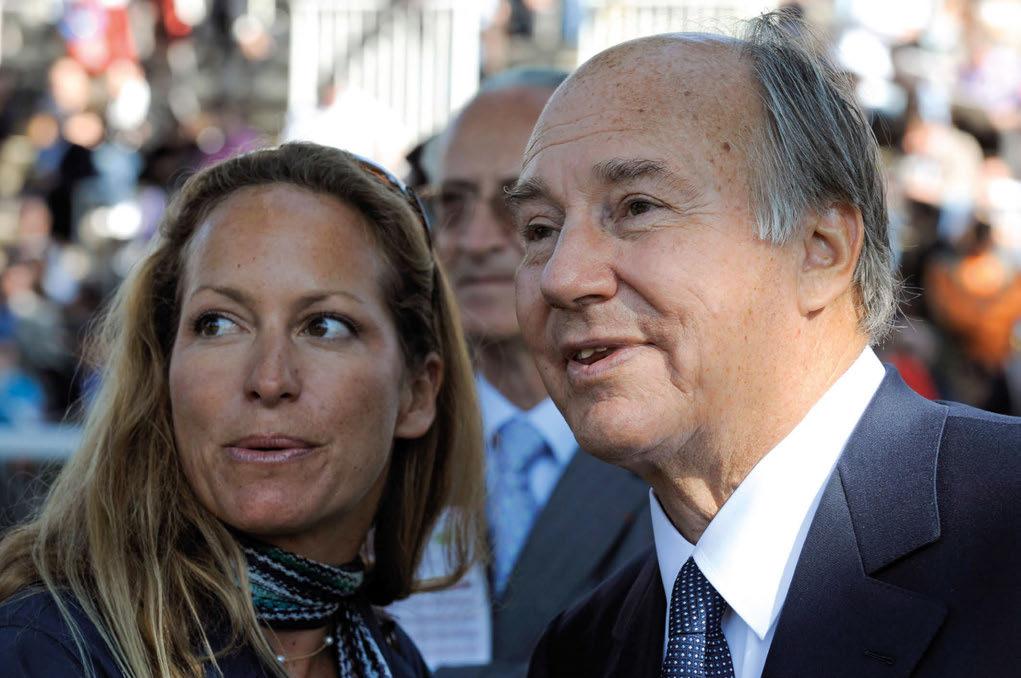
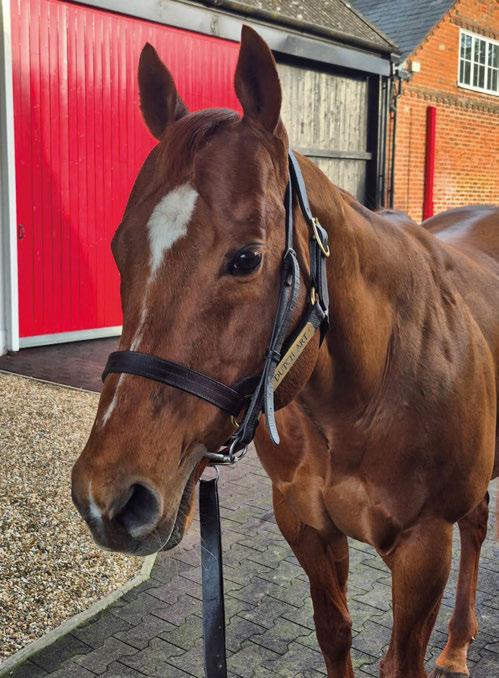
on the biggest stages, now his frst foals take the

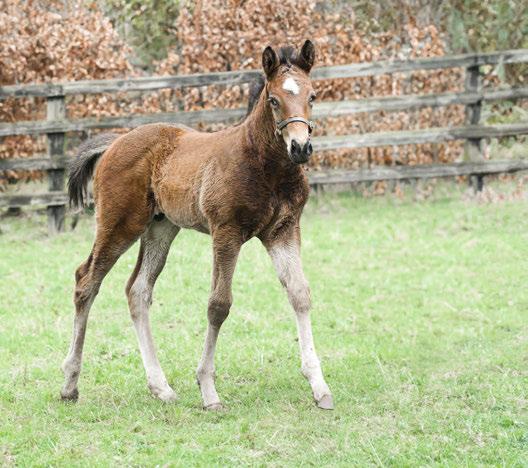
“This colt is strong, correct, athletic with good bone. I’m very happy with him and I will be sending Mostahdaf two more mares this year.”
“He is a cracking foal. A lovely, strong colt who will defnitely be one to look forward to at the foal or yearling sales. He’d be a very good advert for the stallion.”
“Shadwell have two incredibly nice colts. They both have a huge amount of quality are strong, athletic and correct as well as having great bone and depth of girth.
“ We are very happy with our colt, he is of a really good size and is correct. We think Mostahdaf is a very interesting stallion.”
Stands at Beech House Stud, UK
Contact Will Wright: +44 (0)7787 422901 nominations@shadwellstud.co.uk Frankel x Handassa
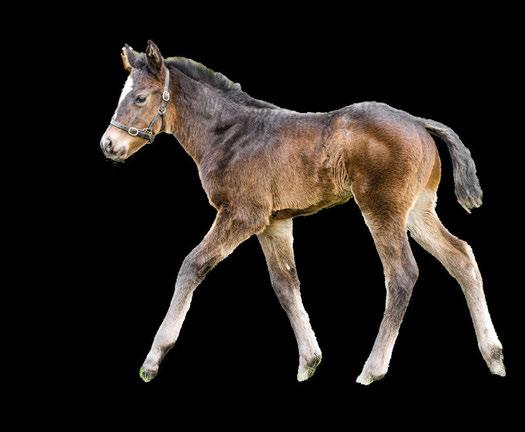

£12,500 January 1st SLF
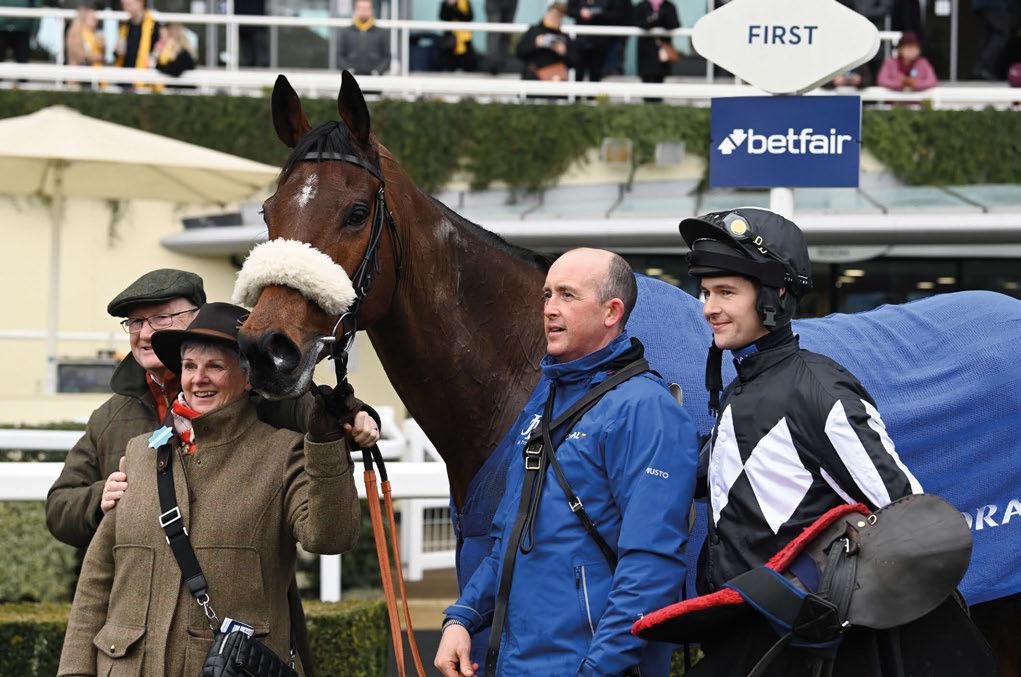



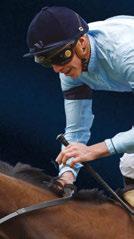
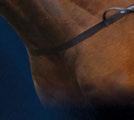
CACHET
Classic/Gr.





Classic/Gr.







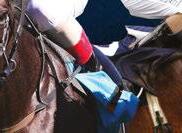









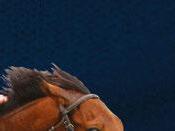



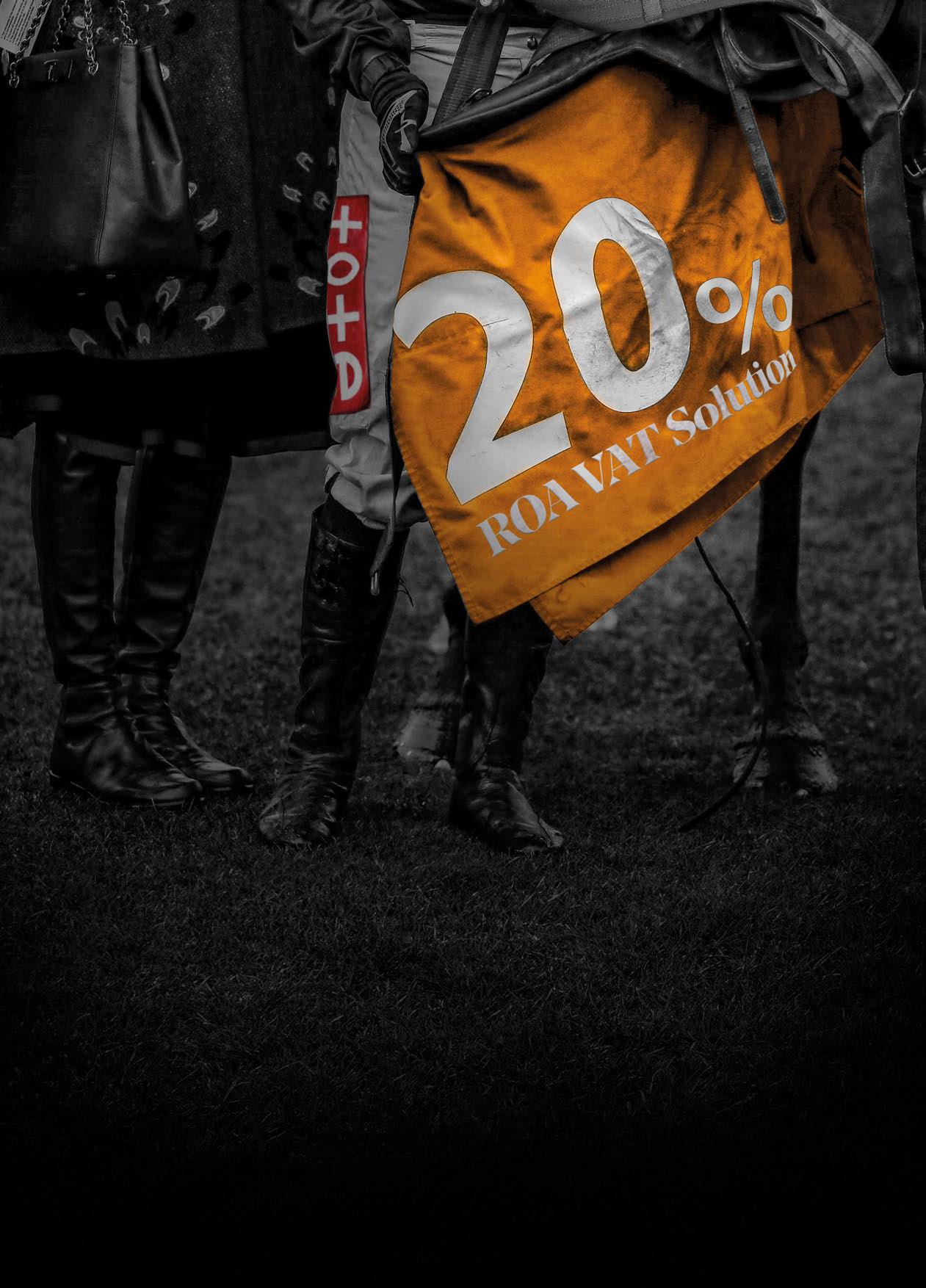
Reclaiming VAT is easier with the ROA VAT Solution.
The Racehorse Owners Association team is here to simplify the process, helping you claim back £000s on your racing expenses and giving you more time for the sport you love. Let us take care of the details and make VAT reclaim seamless. For more information contact our team on 01183 385 685 or email vat@roa.co.uk
There were many heartfelt words and comments made following the passing of Joe Saumarez Smith last month. I first met Joe when I joined the BHA Board a few years ago. We immediately hit it off, not surprising given our shared love of horseracing, betting, cycling, football (despite his love of Arsenal), and all other sports you can think of. He will be greatly missed by the industry, his many friends and obviously his family.
The BHA will also miss him as, despite the fact his time as Chair was coming to an end, we had hoped that Joe would still play an active role on the international stage where he was making such a positive impression. Joe made a fabulous contribution to the industry and we will remember him with great affection and fondness.
The recent report on black-market betting, as reported by the Racing Post, showed some shocking results. A 552% increase in visitor traffic to 22 unlicensed betting websites (between 2021 and 2024) is a clear sign that the affordability checks that the Gambling Commission have been promoting are actually making the situation worse.
It is estimated that betting turnover on racing has fallen sharply in the last two years, with the Levy Board reporting a 20% decline. Of course, there are multiple factors at play here, but the checks have to be a central reason for both the drop and the flight to the black market. There has been no evidence produced that can show how these checks have materially helped problem gambling and, on the face of it, they seem to have contributed to a significant hit to racing’s coffers.
The government white paper specifically identified that the measures proposed would directly impact the sport’s finances and made a reference to the reform of the levy to compensate for the impact. While the proposals have not been adopted, the affordability element is still being heavily used by the Gambling Commission with no reliable data to suggest it is helping – and of course we haven’t seen any levy reform to plug the gap. The industry needs to continue to campaign on affordability, pointing out the damage that has been caused and the lack of credible evidence that the measures are doing anything other than encouraging the increase in black-market betting, which of course falls outside of the levy net.
The government is pushing for a voluntary agreement between the betting firms and the industry for levy reform and whilst this may seem sensible, there is the question of why the bookmakers would voluntarily agree to pay more. We must tackle this issue from a different angle; the bookies need a healthy industry to sustain their businesses so looking at a partnership approach may be the only realistic chance of reaching a compromise.
There has been some enthusiasm around the concept of
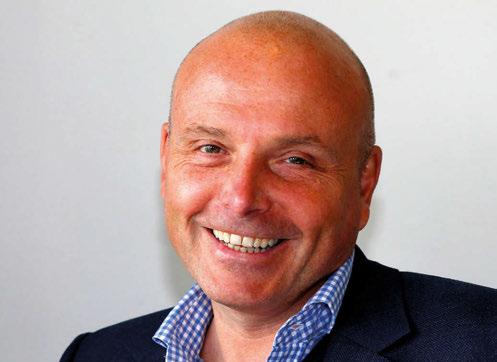
a growth fund – perhaps this idea can be developed further. However, the government’s preferred approach is that any change would not be done on a statutory basis, therefore getting agreement from all bookmakers who currently pay the levy could be very tricky.
Whilst it is still early in the year, time is ticking on the review of the various costs and deductions that are charged by the BHA to owners. This review sits alongside the delayed release of the new IT system developed by the joint venture enterprise between the BHA and Weatherbys that is Racing Digital. The new release date appears to be the end of April. The proposed changes to owners’ fees were announced several years ago – this will reduce the
“A partnership approach may be the only chance of reaching a compromise with bookmakers”
level of costs and hopefully simplify things. However, the broader review needs to identify what is being charged and why as there are already duplications both in terms of fees and services provided.
The two great festivals for National Hunt racing are almost upon us and most will agree that this is the pinnacle of jump racing. The facts surrounding prize-money in the jumps game are, however, less exhilarating. Various factors are at play, but the bare facts are that races have been cut and purses are suffering.
Whilst the industry presses ahead with Project Pace and progress is being made on commercial partnerships between horsemen and racecourses, it must remain a core output that the National Hunt game is looked after – it’s under pressure and action is needed.

Finding the right people to work with you and for you is difficult in any industry, but the thoroughbred racing and breeding industry has more challenges than most as we have recently learnt following the publication of the Horseracing Industry People Board’s Workforce Strategy.
Apart from the high-level skillsets required that seem to cover three times as much as other jobs, there are the (at times) unsociable hours and responsibilities of horsemanship, not to mention the weather. All fine and dandy on a lovely spring day with paddocks drying out and new grass starting to push through, but only three months earlier soaked to the skin, freezing cold, trying to catch that sharp yearling who you don’t trust an inch, is something most of us and the people who work with us have experienced at some stage.
How do we persuade these skilled individuals that turn up every day to keep doing so? Retention is a much more effective tool than recruitment and ensuring that the conditions an employer provides for their staff are the best achievable is a given. Not only do our teams want the right pay for the right job, but an opportunity for career progression; just because it’s a small stud or business doesn’t mean this can be ignored. Every employer has currency in developing and growing a team, be it for one or 21 people.
In my previous life, ‘growing our own’ was a philosophy that paid dividends time after time. Providing external training opportunities to get people to have another view and see a different landscape inevitably saw them come back to the business feeling energised and valued. This point cannot be underestimated – these people were important to us, and we didn’t ever hide that fact. Yes, we knew that in many cases any development helped prepare them for another role, one not always with us, but we had both the pride of seeing their progress and our gaining a reputation as somewhere positive to work.
Involving and engaging employees in understanding how a business works is invaluable. An old Chairman of mine, and the man who had the most influence upon my early career, took me aside to tell me it “wasn’t sufficient that I had all the answers, it was that those I was leading understood the question” –that was management gold dust. If everyone understands the direction of travel and the obstacles in the way, then the pace and the destination become everyone’s objective and responsibility.
The success of any business begins by getting the right people on the bus (and the wrong ones off) and then figuring out where to drive it. So, engage, involve and include your teams (even if it’s only you and one other), ensure that pay and benefits are both competitive and compelling, and then work on all the other areas
Philip Newton Chairman
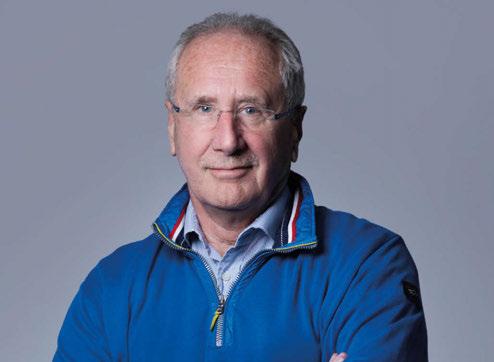
that change the philosophy of just a job to a career.
Security of income and employment is an important part of any package, and when there is an injury, it’s a real benefit to any employee to know that they will be looked after.
In this respect, the TBA has recently announced the Stud Employee Accident Benefit Scheme (SEABS), which will be live at the end of March. Developed specifically for stud employees, for a modest annual premium of just £96 per employee, cover will be provided allowing weekly benefits of up to £400 per week for any employee unable to work through a qualifying
“If everyone understands the direction of travel, the destination becomes everyone’s objective”
injury for up to 104 weeks. The payments are made to the employee via the employer less any statutory sick pay already received.
There are also capital payments in respect of permanent disability of up to £154k covering most eventualities from loss of sight through to death.
SEABS is a TBA initiative, underwritten by Howden, the international insurance broker. All employees must be included within the scheme to qualify, and riding is not an insured risk. Otherwise, it’s a Ronseal product: “It does exactly what it says on the tin”.
Full details of SEABS can be found on the TBA website and I would encourage all members who employ staff to sign up via the dedicated portal. Whilst it is an additional expense, this is a very worthwhile spend; it will help make the case for retention, and it also gives you, the employer, peace of mind knowing that you are doing the right thing.
So, you have your employees’ backs and as always, the TBA has yours.
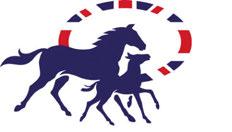
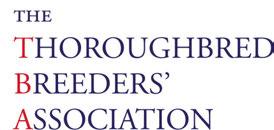

SELWYN
The Aga Khan IV, one of the most influential owner-breeders in the world and the spiritual leader of the Ismaili Muslim community, died on February 4 aged 88.
His passing, which prompted a wave of tributes from leading racing figures across the globe, brought an end to an era that started in 1960 when, aged 23, the Aga Khan took control of his family’s bloodstock operation following the death of his father Prince Aly Khan.
Many homebred champions would race in his emerald-green silks with red epaulettes over the next 65 years, none more famous than the exceptional Shergar, ten-length winner of the 1981 Derby at Epsom. The son of Great Nephew, who followed up in the Irish Derby and King George VI and Queen Elizabeth Stakes, was later kidnapped and killed by the IRA.
Shergar, trained by Sir Michael Stoute, was the first of five Derby victors for the Aga Khan, who also captured the Prix du Jockey Club (French Derby) on eight occasions and the Irish Derby six times, while brilliant mare Zarkava provided the last of his four triumphs in the Prix de l’Arc de Triomphe.
His most recent Group 1 victory came in the 2024 Oaks courtesy of the Dermot Weld-trained filly Ezeliya, now a member of the Aga Khan Studs broodmare band.

The Aga Khan leads in Harzand and Pat Smullen after victory in the 2016 Derby, the owner’s fifth success in the Epsom Classic

Born Karim Al-Husseini in December 1936 into a family that traced its routes back to Persia (later Iran), horses would become an integral part of life for all those who held the Aga Khan title.
The Aga Khan I – the 46th Imam of the Nizari Ismailis, a branch of Shia Islam –had owned racehorses in India from 1820 while the European racing and breeding operation was established in 1921 by the Aga Khan III, grandfather of the late Aga Khan IV.
In a sport dominated by members of the aristocracy and upper classes, the Aga Khan III became a prominent and successful owner-breeder, laying the foundations for the future success of his grandson’s thoroughbred empire.
Not only did the Aga Khan III enjoy 17 English Classic successes as an owner, including the Derby on five occasions, a sequence started by Blenheim in 1930, but some of his early yearling purchases, including a grey daughter of The Tetrarch named Mumtaz Mahal, went on to exert a huge influence on the breed.
When the Aga Khan III died in 1957, the Aga Khan title passed not to his son, Prince Aly Khan, but to his grandson, Karim, who was 20 at the time. Prince Aly Khan, whose second wife was Hollywood film star Rita Hayworth, assumed control of the family’s bloodstock, his brilliant filly Petite Etoile taking the 1,000 Guineas and Oaks in 1959. Tragically, he died the following year in a car crash in the Parisian suburbs.
The running of the operation then passed to the Aga Khan IV, who discussed his approach to breeding when he spoke to Julian Muscat for Owner Breeder in a
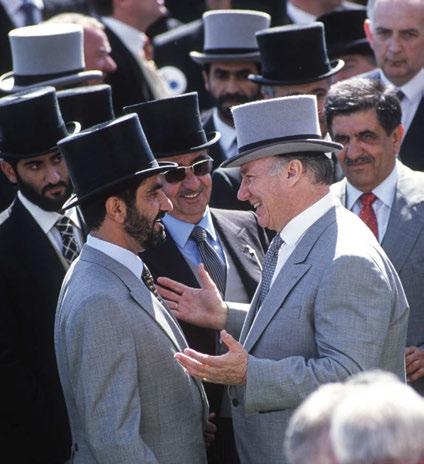
2010 article celebrating 50 years at the helm.
“People often ask me whether they should enter the industry,” he said. “If I told them the truth about how long it had taken me to learn, they wouldn’t go anywhere near it.
“Each breeder has his/her own criteria, driven by pedigree but also the economics of the industry.
“That’s where, for example, Marcel Boussac fell into a trap. His economic situation was getting more and more fragile, therefore he bred more and more of his mares to his own stallions.”
Boussac, a textile magnate and entrepreneur, was one of the leading owner-breeders in France who topped the owners’ standings on 14 occasions and was champion breeder 17 times – he also captured the 1950 Derby with Galcador –but in 1978 his business empire collapsed. He was forced to sell all his thoroughbreds, the vast majority, numbering 144 horses, bought by the Aga Khan.
It wasn’t the first time that the Aga Khan had invested in outside bloodlines –he had secured the bloodstock of Francois Dupré the previous year and would later incorporate stock from Brook Holliday (in 1987) and Jean-Luc Lagardére (in 2005) into the Aga Khan Studs fold.
The Aga Khan was crowned leading owner in France for the first time in 1960 – Alec Head and then François Mathet were his original trainers – and went on to claim the title a further 15 times, his final championship arriving in 2022, while he was the leading breeder in France on ten occasions, most recently in 2016.
He was the leading breeder in Britain five times and champion owner twice, enjoying a golden period in the 1980s when his homebreds captured the Derby three times in eight years.
Shergar, whose ten-length victory under Walter Swinburn in 1981 remains the biggest winning margin in Derby history, was syndicated for £10 million upon retirement but completed just one season at stud in Ireland before being kidnapped and destroyed by the IRA. His body has never been found.
The 1986 Derby saw Khalid Abdullah’s 2,000 Guineas victor Dancing Brave sent off a warm favourite, but he was set too much to do by Greville Starkey and the Aga Khan’s Shahrastani, ridden more prominently, took the spoils for the Stoute/ Swinburn combination. Derby number three arrived in 1988 courtesy of the Luca Cumani-trained Kahyasi.
The Aga Khan would wait another 12 years for his fourth Derby strike with Sinndar, a relentless galloper trained by

and Walter Swinburn romp home in the 1981 Derby, winning by ten lengths
John Oxx, who followed up in the Irish equivalent before finishing his career with victory in the Prix de l’Arc de Triomphe.
His final Derby victory came in 2016 with the Dermot Weld-trained Harzand, ridden by the late Pat Smullen, who also guided the son of Sea The Stars to success in the Irish Derby.
The Aga Khan’s French Classic haul stands at 27; he captured the first of eight Prix du Jockey Clubs in 1960 with Charlottesville, later a champion sire in Britain, and followed up with Top Ville (1979), Darshaan (1984), Mouktar (1985), Natroun (1987), Dalakhani (2003), Darsi (2006) and Vadeni (2022).
Blushing Groom, not a homebred but a foal purchase at Tattersalls, was perhaps the best of the Aga Khan’s seven winners of the Poule d’Essai des Poulains (French 2,000 Guineas). He was subsequently third in The Minstrel’s Derby and became a leading sire in both the US and Britain and Ireland.
The Aga Khan’s record seven winners of the Prix de Diane (French Oaks) featured the names Shemaka (1993), Vereva (1997), Zainta (1998), Daryaba (1999), Zarkava (2008), Sarafina (2010) and Valyra (2012).
Zarkava was an outstanding performer who was unbeaten in seven career starts, also taking the Poule d’Essai des Pouliches (French 1,000 Guineas) – a race her owner won five times in total – and finishing off with victory in the Prix de l’Arc de Triomphe.
At stud she has produced three blacktype performers, headed by Grand Prix de Saint-Cloud scorer Zarak, now a mainstay

of the Aga Khan Studs stallion roster and one of the most sought-after sires in France.
He stands alongside the nation’s leading stallion Siyouni – the product of a Lagardere-nurtured family – at Haras de Bonneval, while Sea The Stars, bred and raced by the Tsui family, is based at Gilltown Stud in Ireland.
The Aga Khan emulated his grandfather (Felicitation, 1934 and Umiddad, 1944) and father (Sheshoon, 1960) in winning the Gold Cup at Royal Ascot, taking the 2m4f prize with Enzeli in 1999.
Other top-class performers for the Aga Khan include Champion Stakes and Breeders’ Cup Turf hero Kalanisi, four-time Group 1 winner Sendawar, Alamshar, who defeated Dalakhani in the 2003 Irish Derby before taking the King George VI and Queen Elizabeth Stakes, a race also won by European champion older horse Azamour in 2005, and Daylami, who landed the Poule d’Essai des Poulains for his breeder before transferring to Godolphin, winning six further Group/Grade 1s for the boys in blue.
Godolphin’s founder, Sheikh Mohammed, said: “We offer our condolences to the world’s Ismaili Muslims on the death of the Aga Khan. He was not only a great leader for his people, but a true friend and an equestrian who loved and understood horses deeply.
“Above all, he stood as one of the world’s greatest philanthropists, whose life’s work was dedicated to relieving the hopelessness of poverty and promoting human development, building bridges
between communities and working tirelessly in the cause of peace.”
At the time of his death, the Aga Khan had around 160 broodmares and 220 horses in training across France and Ireland.
He had first sent horses to be trained in Britain in 1978, initially with Stoute and Fulke Johnson Houghton. His support ended in the wake of Aliysa’s disqualification from the 1989 Oaks – her
“He was a very understanding owner, always a pleasure to deal with”
post-race urine sample was found to contain traces of a prohibited substance, camphor.
The Aga Khan was unhappy with the UK’s testing procedures and challenged the Jockey Club’s ruling, hiring scientists in North America to investigate, but the decision was confirmed many months later and Aliysa’s Classic win was chalked off.
He did have horses based in Britain again, linking up with old ally Stoute, but withdrew after the 2006 season, focusing on his bloodstock interests in France and Ireland.
The association with Oxx, trainer of his top-level winners Manntari, Timarida, Ebadiyla, Edabiya, Sinndar, Enzeli, Alamshar, Azamour, Kastoria and Alandi, came to an end at the conclusion of the 2014 season.
Oxx, who retired from the training ranks in 2020, told the Racing Post: “A lot of trainers have reason to be grateful to him. He was always a pleasure to deal with and a very understanding owner.
“The Irish Derby with Alamshar is one I always remember with amusement because His Highness was first and second. Dalakhani was favourite and Alamshar beat him, so we won with the second colours and he led him in – he had his chest stuck out and was enjoying it so much.
“He was very intelligent and his life work was all-consuming. Some people think only of racing when they think of the Aga Khan, but his work was a huge enterprise and he did a lot of good.”
In keeping with tradition, the Aga Khan IV was accorded the title ‘His Highness’ by Queen Elizabeth II in 1957; in 1886 Queen Victoria had bestowed the honour upon his grandfather, then aged nine.
The Aga Khan’s focus on soundness and stamina in his breeding operation not only produced exceptional results on the racecourse but ensured his stock proved immensely popular when offered at auction.
He was a key figure in the creation of sales house Arqana, formed after the merger of bloodstock auctioneers Agence Francaise and Goffs France. He held a majority stake in both Arqana and Goffs.
The Aga Khan was an investor in the modernisation of Chantilly racecourse, which had been threatened with closure in the 1990s, backed the redevelopment of the Curragh, which reopened in 2019 with its main grandstand named The Aga Khan Stand, and instigated the creation of Longchamp’s Prix de l’Arc de Triomphe weekend together with Louis Romanet, then Director of France Galop.
A noted philanthropist, the Aga Khan Foundation was established in 1967 to tackle poverty around the world and bridge cultural divides.
Daughter Zahra Aga Khan has been actively involved in her family’s bloodstock business since the 1990s and currently leads the management team in charge of running the Aga Khan Studs in Ireland and France.
His eldest son, 53-year-old Rahim AlHusseini, has been named Aga Khan V and 50th Imam of the Ismaili Muslins.
Further tributes to the Aga Khan in Breeders’ Digest (pages 50-51) and Sexton Files (pages 62-64)

The National Hunt community was united in grief last month following the death of multiple Grade 1-winning jump jockey Michael O’Sullivan. He was 24.
O’Sullivan was riding in a handicap chase at Thurles on February 6 when his mount, Wee Charlie, fell at the final fence.
After being treated for his injuries at the track, he was taken by air ambulance to Cork University Hospital and placed in an induced coma in intensive care. He didn’t regain consciousness and passed away on February 16, five days before his 25th birthday.
A native of County Cork, O’Sullivan was born into a farming family with strong links to the jumps game.
His father, William, was a former amateur jockey who landed the 1991 Foxhunter Chase at Cheltenham aboard Lovely Citizen, trained by his brother Eugene. In 2020 Eugene repeated the feat with 66-1 shot It Came To Pass, partnered by his daughter Maxine O’Sullivan.
It was Eugene who provided his nephew with his first winner in the
point-to-point field, A Decent Excuse at Castletown-Geoghegan in 2017, and O’Sullivan went on to ride in over 300 point-to-points before graduating to racing under Rules.
His ability in the saddle was obvious from the start and he was still claiming 7lb as an amateur when leading trainer-owner Barry Connell recognised his prodigious talent.
O’Sullivan partnered Connell’s Marine Nationale to victory in a Punchestown bumper on debut in May 2022 – he turned professional later that year – and the partnership went on to claim Grade 1 honours in the Royal Bond Novice Hurdle at Punchestown and Supreme Novices’ Hurdle at the 2023 Cheltenham Festival, when the jockey also captured the Fred Winter Juvenile Handicap Hurdle on Jazzy Matty for trainer Gordon Elliott.
Further Grade 1 glory was achieved on Good Land at Leopardstown in 2023 and though the association with Connell ended in November, O’Sullivan was still getting good opportunities. He guided the Willie
Mullins-trained Embassy Gardens to success in the New Year’s Day Chase at Tramore on January 1.
Tributes flowed for O’Sullivan, who rode 95 winners in total, 90 in Ireland and five in Britain, and was undoubtedly a rising star of the weighing room.
Suzanne Eade, CEO of Horse Racing Ireland (HRI), said: “My HRI colleagues and I share in the sadness of everyone at the news of the passing of Michael O’Sullivan.
“Everyone’s thoughts are with Michael’s parents William and Bernadette, his brother Alan, his wider family and with his many friends and colleagues. To them all, we offer our sincerest condolences.
“Coming from a background steeped in racing, Michael made his start in the point-to-point field while a secondary school student and he made his name on the racecourse with a university degree under his belt.
“A champion under-21 point-to-point rider, Michael began the 2022/2023 season as a 7lb claiming amateur and ended the term as our champion conditional jockey with three Grade 1 winners to his name.
“Michael’s talent shone through for big-race success on National Hunt racing’s greatest stages. Michael was a gentleman. He was loved and respected by all who knew him, and everyone can be proud of his many achievements, both on and off the racecourse.
“Michael will be much missed and he will be widely mourned. May he rest in peace.”
Leading jumps owner John Hales, whose famous yellow silks were carried by superstars One Man and Azertyuiop, died last month at the age of 85.
Popular grey One Man, trained in Cumbria by Gordon Richards, was an outstanding chaser whose big-race wins included two King George VI Chases in 1995 (staged at Sandown in January) and 1996.
Two attempts at the Cheltenham Gold Cup proved fruitless – One Man didn’t stay the 3m2f trip on such a testing track – but dropped back to two miles in the 1998 Queen Mother
QIPCO British Champions Day at Ascot will feature a record five Group 1 races after the Long Distance Cup was upgraded by the European Pattern Committee (EPC), which also ratified the same boost for the City of York Stakes at York.
The prize fund for the two-mile Long Distance Cup, won last year by outstanding stayer Kyprios, has been increased to £500,000, matching both the Fillies & Mares and Sprint contests.
In a further development, Champions Day, staged on Saturday, October 18, will introduce a new £250,000 race for two-year-olds. The six-furlong conditions race, open to all two-year-olds and to be run without penalties, will open the card, now worth £4.35 million in total.
Rod Street, Chief Executive of British Champions Series, said: “We are delighted with the upgrade of the Long Distance Cup to Group 1 status, which has been our longstanding aspiration. We are grateful for the BHA’s consistent support.
“For QIPCO British Champions Day to stage five Group 1 races across every category for three-year-olds and upwards is a tremendous
Champion Chase, he showed his class with a thrilling four-length success over Or Royal under Brian Harding.
Tragically, One Man died on his next outing in the Melling Chase at Aintree, suffering a fatal fall at the ninth fence.
Azertyuiop, trained by Paul Nicholls, was a top-class two-mile specialist whose battles with Irish rival Moscow Flyer, trained by Jessica Harrington, were always eagerly anticipated.
With Ruby Walsh in the saddle, he won the 2003 Arkle Challenge Trophy and returned to Cheltenham a year later to take the Champion Chase by nine lengths from Flagship Uberalles, with Moscow Flyer unseating Barry Geraghty four out. Hales celebrated a third Champion Chase triumph with Politologue in 2020.
In 2012 he captured the Grand National with Neptune Collonges and the grey gelding, now 24, led the funeral procession at St Mary Magdalene’s Church in Shropshire.

achievement and further cements its status as one of the best days of racing in the world.”
The City of York Stakes becomes the first seven-furlong Group 1 race in Britain, with the FPC recognising the investment in the all-aged contest by the York racecourse executive. Its prize pot has been boosted by £100,00 to £600,000.
William Derby, Chief Executive and Clerk of the Course at York, said: “We are thrilled that all the hard work, support and investment in the Sky Bet City of York Stakes has been rewarded by its elevation to the highest level of racing, Group 1 status.
Other top performers for Hales included Supreme Novices’ Hurdle winners Noland (2006) and Al Ferof (2011).
In recent years he had enjoyed owning in partnership with friends Sir Alex Ferguson and Ged Mason and daughter Lisa, sharing the pleasure of Protektorat’s 2024 Ryanair Chase win.
Hales was the co-founder and Chairman of Golden Bear Toys, established in 1979 and based in Telford. The company manufactured, amongst other soft toys, Teletubbies and Twirlywoos.
He was delighted to have received a lifetime achievement award from the British Toy & Hobby Association in recognition of his work in the industry.
In an interview with Owner Breeder in 2015, Hales revealed how anxious he would get before watching his runners in action.
“I used to get very nervous and het up before a race,” he said. “But the
I am delighted to confirm that Britain’s only all-age Group 1 over seven furlongs will be run for a record prize fund of £600,000.
“The York Race Committee has repeatedly demonstrated its commitment to high-quality racing, so we are thrilled to have a fourth Group 1 at the Sky Bet Ebor Festival for everyone to enjoy.”
Two permanent black-type race transfers have also been approved by the FPC for 2025, with the Group 3 Criterion Stakes and Listed Fred Archer Stakes switching from Newmarket to York and Beverley respectively.

experience of ownership has helped calm me down and I’m much better than I used to be.
“During a race I want to be on my own; I don’t even want the family near me.”
Fulke Johnson Houghton, a leading trainer of his day who handled Classic winners Ribocco and Ribero, died last month at the age of 84.
Johnson Houghton was rising just 21 when he joined the training ranks in 1961 at his family’s Woodway Stables in Blewbury. His place as one of the youngest among his profession was more by circumstance in that it followed the death of his father Gordon in a hunting accident in 1952.
Women were still barred at the time from holding a training licence, which prevented his widow Helen, the twin sister of leading trainer Fulke Walywn, from taking on the yard under her own name. As such, the horses were officially trained by Colonel Poole and then by head lad Charles Jerdein, even if in reality it was otherwise.
Despite his age, Fulke Johnson Houghton took over the licence having accumulated plenty of experience, including in France under Major John Goldsmith and Jacko Cunningham.
By the end of the decade the young trainer had already tasted Classic success. Major American owner Charles Engelhard, whose colours will forever be associated with Triple Crown winner Nijinsky, selected Blewbury as the main base for his British stock and was rewarded when Johnson Houghton saddled Romulus to win the 1962 Sussex Stakes and Queen Elizabeth II Stakes.
Romulus was emblematic of Engelhard’s penchant for the progeny of the Kentucky-based Ribot and the strategy paid off further in later years in the top-class brothers Ribocco and Ribero, trained by Johnson Houghton to land the Irish Derby and St Leger double in 1967 and 1968, and 1968 Dewhurst Stakes winner Ribofilio.
The Engelhard association also included Habitat, a top-class miler who won the 1969 Lockinge Stakes and Prix du Moulin prior to an extremely successful stallion career at Airlie Stud, and during the 1970s by Rose Bowl, who won back-to-back runnings of the

Queen Elizabeth II Stakes in 1975 and 1976 as well as the 1975 Champion Stakes for Engelhard’s widow Jane.
Johnson Houghton also came close to winning the Derby in 1977 with Lord Leverhulme’s Hot Grove, who had gone clear halfway up the straight under Willie Carson only to be run down and narrowly denied by The Minstrel and Lester Piggott.
The decade closed with two different but equally important horses in Ile De Bourbon, winner of the Coronation Cup, and Double Form, whose accomplished sprint career took in wins in the King’s Stand Stakes and Prix de l’Abbaye. It was around this time that Blewbury also welcomed its first intake of yearlings from the Aga Khan;
the best arising out of that association turned out to be Baynoun, second in the 1984 St Leger.
Good horses were harder to come by in later years but there was a further reminder of his capability as a trainer in Tout Seul. Unearthed for just Ir12,500gns as a yearling in 2001, the Ali-Royal colt won the following year’s Dewhurst Stakes.
Johnson Houghton retired at the end of 2006. Daughter Eve took over at Blewbury and continues to do the name proud, one of her most accomplished horses being the family’s homebred Accidental Agent, who carried Gaie Johnson Houghton’s colours to success in the 2018 Queen Anne Stakes at Royal Ascot.
Joe Saumarez Smith, one of the British racing’s most senior leaders who was greatly respected and admired throughout the industry, died on February 11 after losing his battle against lung cancer. He was 53.
A talented journalist in his younger days, writing for The Sunday Telegraph and Sunday Express, he became a skilled poker player and punter, executing a series of audacious coups, before seeing the future potential in the online sector.
Saumarez Smith, who founded management consultancy Sports Gaming in 2001, bought up hundreds of internet domain names and sold them on at a huge profit, becoming a well-known expert in the gambling and gaming world.
He joined the British Horseracing Authority (BHA) in 2014 as a Non-executive Director and in March 2022 was appointed BHA Chair, his term subsequently extended until June 2025.
Personable and approachable – not to mention always well turned out – Saumarez Smith used his experience to try and bring the racing and betting industries closer together in the search for common ground over levy reform, also proving a skilled diplomat in his role as a global ambassador for British racing.
He oversaw both the restructuring of the sport’s governing system with the introduction of a Commercial Committee and the launch of Premier fixtures, designed to promote the best of British horseracing.
Saumarez Smith took an increasingly proactive approach to equine welfare, the latest manifestation of which was evidenced in the BHA’s HorsePWR campaign.
He was diagnosed with inoperable lung cancer in June

2023 yet was determined to continue in his BHA role, even accepting an additional duty to escort the King and Queen at Ascot.
Brant Dunshea, the BHA’s acting Chief Executive, said: “It has been a great privilege to have known and worked with Joe, always providing wise counsel and tremendous support to the BHA team and to me personally, and for that we will be forever grateful.
“His commitment to advocating Britain’s interests on the global stage was unwavering, and for that British racing owes him a huge debt of gratitude. We will miss him terribly.”
Saumarez Smith, a big fan of cycling and Arsenal, is survived by wife Wanda, who he met while reading politics at Bristol University, and children Matilda and Oliver.
A new online calculator that makes parasite risk assessment simple has been launched.
The assessment can be completed in under five minutes by answering key questions about your horse’s management and recent test results.
The calculator then provides an easy-to-understand output that classifies a horse’s risk level and gives practical solutions on the next steps to improve any worm control plan.
Worm infections, including small redworms and tapeworms, are common in horses and can lead to health issues if not properly managed.
By conducting a risk assessment, actions can be taken to reduce worm risks and disease.
Risk varies according to individual factors, season, management, and test results, necessitating assessments every three months for high-risk horses, every
Worm infections are common in horses

six months for moderate risk, and annually for low-risk horses. Management and testing frequency should also be adjusted if and when
circumstances change.
The free tool can be used to assess risk based on nine key questions. Visit whatsyourwormrisk.com.

French jockey has first rides since May 2021 at Al Rayyan racecourse having been granted an emergency temporary licence by Qatar’s racing authorities.
Amy Murphy
32-year-old will move her entire training operation from Newmarket to Chantilly due to the better prize-money and premiums available in France.
Jonathan Mullin
Moves from Ripon to take up the role of Chief Executive and Clerk of the Course at Pontefract from March 17, succeeding Richard Hammill.
Tim Husbands
Leaves role as Chief Executive of Leopardstown racecourse after five years. His tenure saw an increase in attendances at the track.
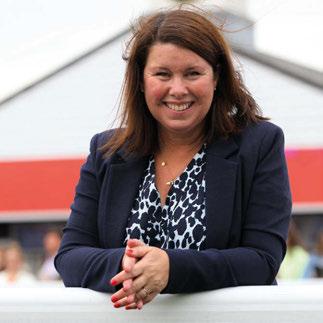
Julie Harrington
Former Chief Executive of the BHA takes up new role as Non-Executive Director of Chester Race Company, succeeding Charles Barnett.
Richard Kingscote
Derby-winning jockey is granted a shortterm licence to ride in Hong Kong until April 2, along with former Irish champion jockey Declan McDonogh.
Sheikh Mansour
Vice-President of the UAE who owns Manchester City purchases Haras de Fresnay-le-Buffard, formerly the base of Marcel Boussac and Stavros Niarchos.
Conor McNamara
Jockey suspended for 40 days after his ride on chasing debutant Mount Ferns – trained by father Eric, who was fined €6,000 – at Clonmel in February.
Prince Sultan bin Mishal Al Saud
Saudi royal is placed on the BHA’s forfeit list due to unpaid training fees totalling £320,000 owed to Richard Hannon.
Thomas Huet
Former jockey joins the Arqana bloodstock team in Chantilly on a permanent basis, specialising in horses in training.

Michael Halford
Group 1-winning trainer who sent out 1,200 winners under both codes announces retirement having held a joint-licence with Tracey Collins since 2023.
Pat Murphy
Trainer retires aged 67; he sent out over 200 winners and enjoyed Grade 2 glory with Shooting Light and Welsh National success with Supreme Glory.

Colic claims the life of Gigginstown’s three-time Cheltenham Festival victor, also winner of five Grade 1s and runner-up in the 2024 Grand National.
Love Divine 28
Lordship Stud’s Oaks heroine went on to produce St Leger victor Sixties Icon, subsequently a successful stallion for Norman Court Stud.
Miss Macy Sue 22
Stakes winner excelled in the breeding shed, producing leading sires Not This Time and Liam’s Map, the latter successful twice at Grade 1 level.
100 2YO’S in training with

Ralph Beckett, John Gosden, Jane Chapple-Hyam, Richard Fahey, Richard Hannon, Eve Johnson Houghton, Hugo Palmer, Kevin Ryan, Archie Watson, etc.
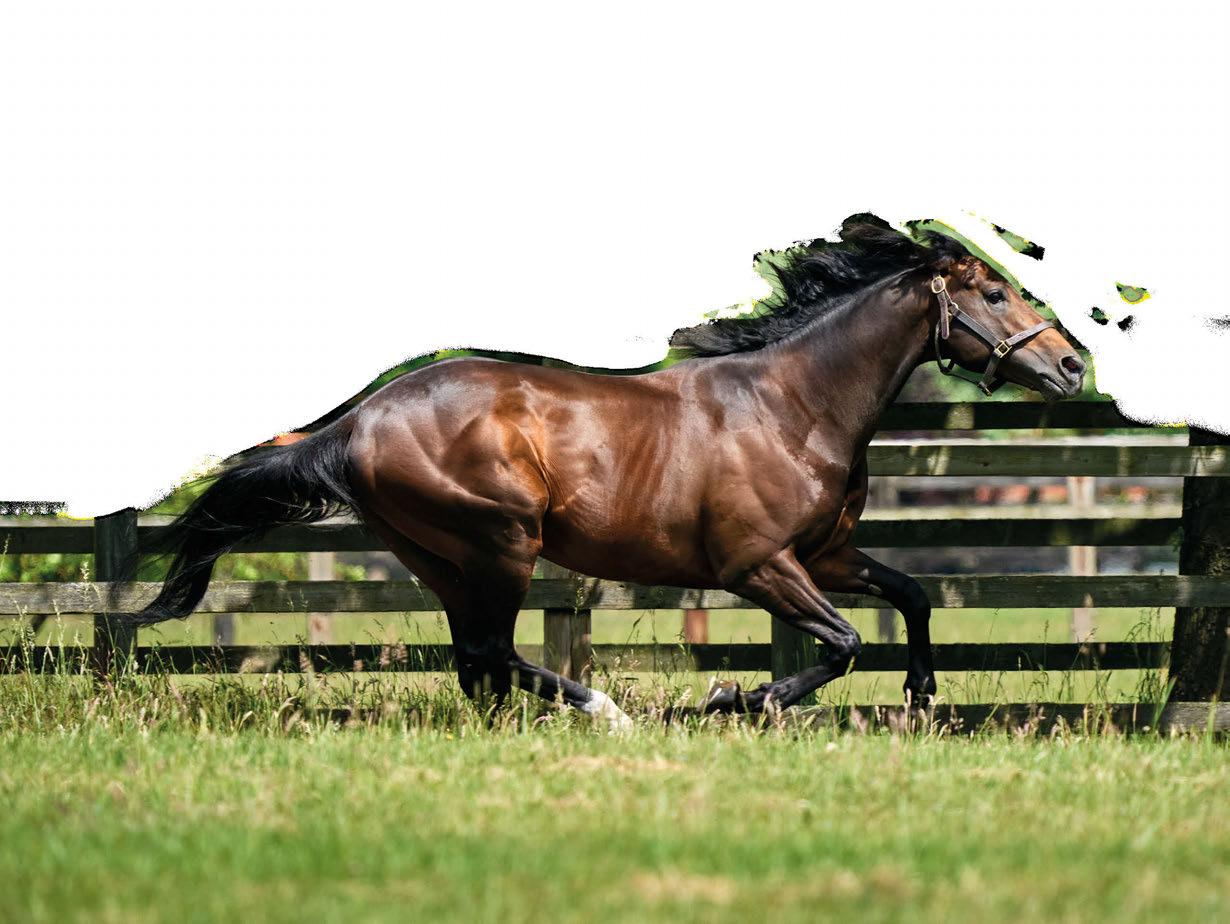
I am very happy with how our Lope Y Fernandez colt is progressing, he is a lovely big horse who looks precocious and will be aimed at an early Maiden.
PAUL & OLIVER COLE
Joe Bradley Joe.bradley@nationalstud.co.uk
Jamie Jackson Jamie.jackson@nationalstud.co.uk
Edward Preece Edward.preece@nationalstud.co.uk 01638 675929


The Aga Khan 88
Owner-breeder whose famous emerald green silks were carried with distinction by outstanding performers such as Shergar, Azamour and Zarkava.
Son of More Than Ready who won the 2024 Breeders’ Cup Mile at Del Mar will shuttle to Australia this year to join Yulong’s stallion roster in Victoria.
Cold Case
Son of Showcasing who won a Group 3 sprint at Ascot will begin his stud career at Haras des Granges in France. His firstyear fee is set at €2,500.
Ambiente Friendly
The Gredley Family’s four-year-old colt, runner-up to City Of Troy in last year’s Derby, moves stables in Newmarket, switching from James Fanshawe to James Owen.
Mogul
Dual Group 1-winning son of Galileo moves from Coolmore’s The Beeches Stud to Willow Wood Farm in Cheshire. His stud fee is set at £2,500.
King’s Gambit
Talented four-year-old son of Saxon Warrior is bought by Wathnan Racing having shown high-class form over middles distances for Mohammed Jaber.
John Hales 85
Leading NH owner captured the Grand National with Neptune Collonges and enjoyed big-race success with the likes of One Man and Azertyuiop.
Fulke Johnson Houghton 84
Multiple Classic-winning trainer sent out more than 1,200 winners in 46 years, including top-class Ile De Bourbon, winner of the 1978 King George VI and Queen Elizabeth Stakes.
Joe Saumarez Smith 53
Former Chair of the British Horseracing Authority created a management consultancy in the sports sector and invested in a number of start-ups.
Michael O’Sullivan 24
Irish jump jockey who enjoyed Grade 1 success with Marine Nationale and Good Land failed to recover from head injuries sustained in a fall at Thurles.
Ken Cunningham-Brown 93
Dual-purpose trainer based at Danebury Stables won the William Hill Trophy with Bold Effort and Future Champion Chase with Dancing Paddy.
John Douglas 90
British Lion and Scottish rugby international was also a district boxing champion, fine golfer and co-owned Rubstic, winner of the 1979 Grand National.
in his first two seasons at stud including breeders such as...
Ben Sangster, Ringfort Stud, Dermot Cantillon, Elwick Stud, AppleTree Stud, Stetchworth Stud, Emma Balding, Meon Valley Stud, Mount Coote Stud, etc.

As a 7-time Group 1 winner Stradivarius is incredible value at 10k. Based of the result of the frst foal we had by him, we sent Lola Paige in his second season who is the dam of an exciting Too Darn Hot flly we sold for 600,000gns last October.
CHOC THORNTON
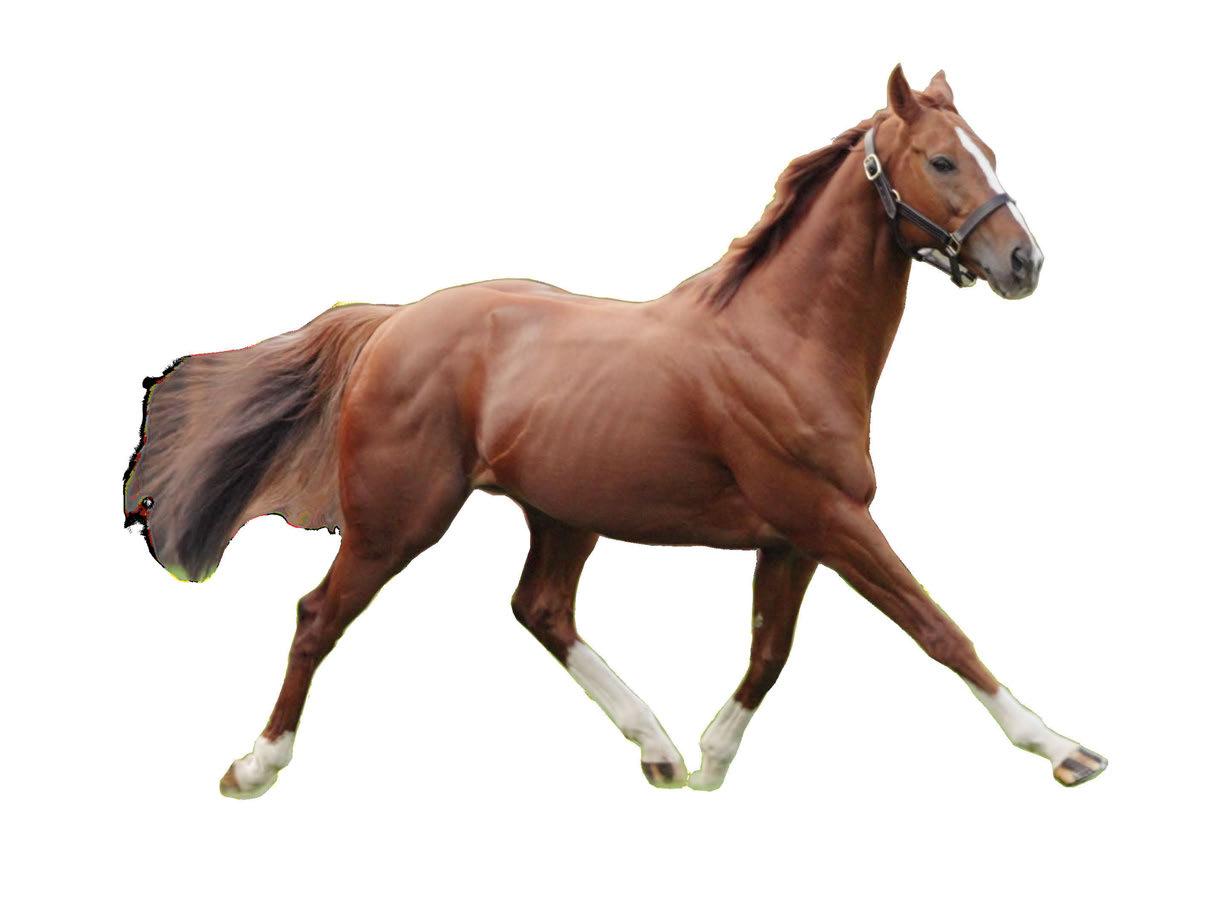






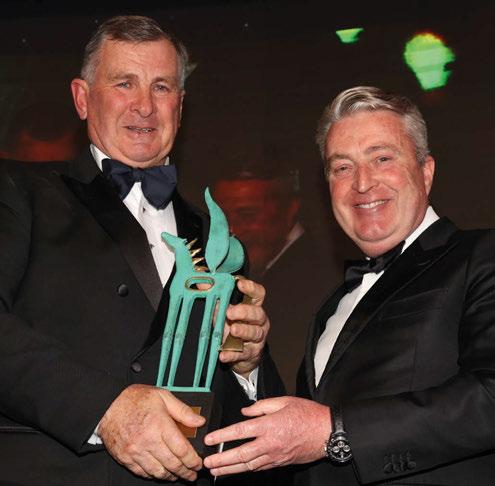
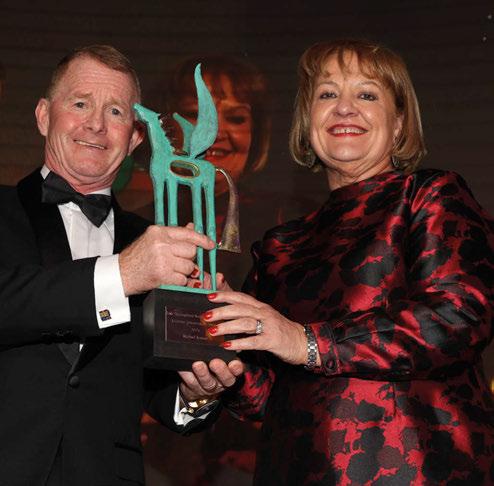



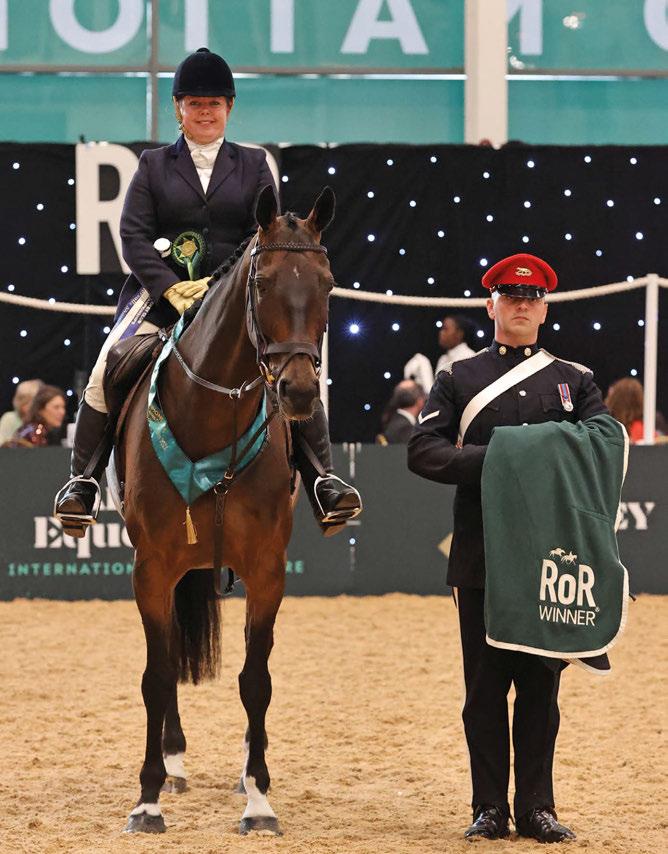
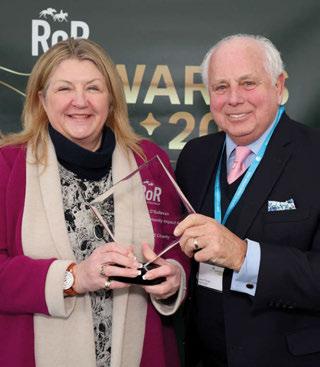


Neither are these breeders sending mares to Aesop’s Fables in 2025…



Tom Blain, Barton Stud
Tony Elliott, Rogues Gallery Racing
William Pilkington, Oak Leaf Stud





Tim & Gill Bostwick, Biddestone Stud
Billy Jackson-Stops, JS Bloodstock Consultancy


Dermot Cantillon & Meta Osborne, Tinnakill House Stud
Peter McCutcheon, Springfort Park Stud
Gary Aspell (Killartery Stud), Richard Auld (Northern Bloodstock), Ronnie Boland (Piercetown Stud), Liam Brennan (Skehanagh Bloodstock), Ciara Eglington (Collegelands Stud), Gerry Flannery (Esker Lodge Stud), Ickworth Stud, Stoneyhill Stud, Tirnaskea Stud, Paul Turner (White Horse Stables), Triermore Stud, etc.




There is a moment just before dawn, as the world stirs but hasn’t yet fully woken, when the gallops become a realm of quiet magic. The early light catches the mist, horses move as if born of the morning fog, and the rhythmic pounding of hooves echoes through the still air. For those lucky enough to stand at the rail with a steaming mug of tea and a well-wrapped scarf, this is the closest thing to heaven racing has to offer.
And yet, for owners and breeders, the journey to that moment is neither serene nor simple. Racing, as an industry, is a delicate dance between logic and lunacy. For every shimmering morning on the gallops, there are nights spent agonising over vet bills, bloodline decisions, and the nagging doubt that the horse you’ve pinned your hopes on might not even make it to the track. It’s a world where highs are stratospheric, lows are gut-wrenching, and certainty is as rare as an untroubled colt.
So, why do we do it? Why do otherwise rational individuals – business titans, farmers, pensioners, and princes – invest so much time, money, and emotion into a pursuit where the odds are rarely in their favour? To understand this, we turn to two frameworks: the psychological triad of achievement, affiliation, and status, and the elemental drivers of like, want, and need. Together, they help unpack the unique alchemy of motivations that sustains this extraordinary industry.
Achievement: the pursuit of glory
In racing, achievement takes many forms. For some, it’s about the thrill of winning – the heady moment when your silks flash past
Owning thoroughbreds is about so much more than a day at the races

the post and the world erupts in a blur of cheers and champagne corks. For others, it’s about the quieter, deeper satisfaction of building something enduring: a bloodline, a stud, or a reputation as a breeder or owner of note.
For the informed breeder, the pursuit of achievement is as much about craft as it is about luck. The selection of sires and dams, the balancing of speed with stamina, soundness with spirit – it’s a painstaking process that requires both science of stride lengths and art of pedigree optimisation.
This is no mere matchmaking exercise; it’s a calculated gamble based on a lifetime of learning. And when it works – when the foal grows into a horse that dominates the sales ring or streaks to victory on the track – it’s not just a financial windfall. It’s a vindication of everything the breeder stands for.
Owners, meanwhile, find achievement in the choices they make about a horse’s career. The decision to entrust their horse to a particular trainer, the tactical placement in races, the careful management of a horse’s development – all of these become part of a narrative that culminates in success. For them, the horse is not just a competitor but an extension of their own ambition, intellect, and hope.
And yet, racing’s greatest charm is its refusal to bow to anyone’s plans. The billionaire’s blue-blooded colt can be outpaced by a modest homebred, the meticulously plotted campaign can be undone by a bad draw or an unexpected downpour. Achievement, in racing, is as much about resilience as it is about results.
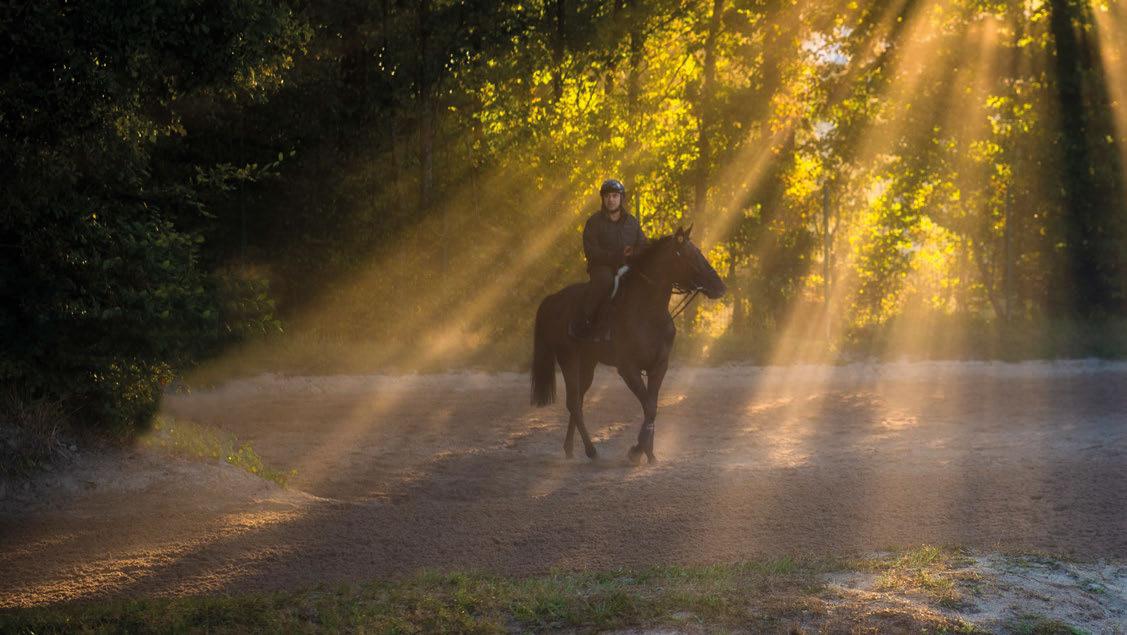
Affiliation: the bonds that bind us to the sport Racing is a sport of individuals, but it is sustained by community. For many owners and breeders, the sense of belonging – to a yard, a syndicate, or the broader racing world – is as rewarding as any victory.
On race day, this communal spirit comes alive. The paddock hums with nervous energy as trainers and owners discuss tactics, while syndicate members crowd around their horse, snapping photos and exchanging jokes. In the stands, friendships are forged and rivalries played out, all with an undercurrent of shared passion.
For breeders, affiliation takes a different form. Sales rings at Tattersalls, Goffs, or Keeneland become not just marketplaces but meeting grounds for like-minded enthusiasts. The handshake that seals a deal carries with it a respect for the craft, an acknowledgment of the hard work and expertise that goes into producing a horse worthy of the hammer.
Syndicates, too, have revolutionised the sport’s sense of affiliation. By lowering the barriers to entry, they’ve created a model of shared ownership that brings together enthusiasts from all walks of life. Whether you own a hoof or the whole horse, the experience is no less thrilling when your horse thunders down the home straight.
Status: the prestige of ownership and breeding Racing has always been a sport that carries an air of prestige. From the grandstands of Ascot to the private boxes of Longchamp, it exudes a sense of history, tradition, and exclusivity. Owning and breeding racehorses taps into this aura, offering participants a unique form of status.
For some, the act of ownership itself is enough, a quiet nod to success achieved, a life well-lived. A racehorse is a statement, a testament to one’s ability to engage in something as beautiful and unpredictable as this sport.
But for others, status is tied to success. The breeder whose
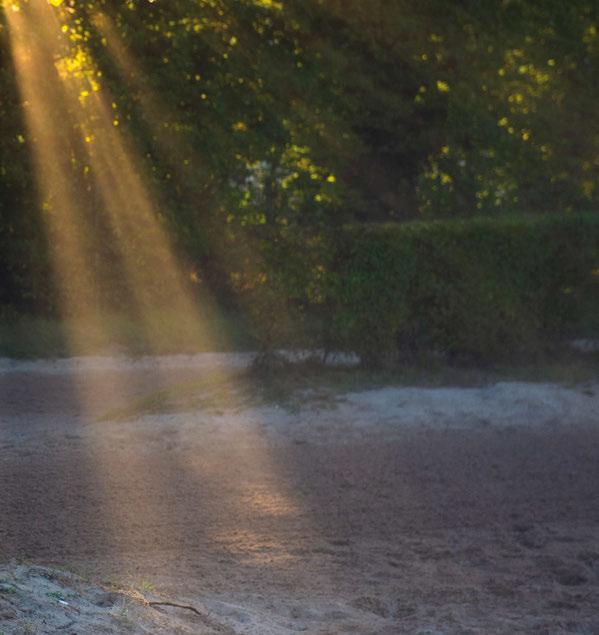
GEORGE SELWYN
yearling fetches a million guineas at auction, the owner whose horse dominates the Derby – they become figures of admiration within the racing community. It’s not just about wealth; it’s about contributing to a legacy, about leaving a mark that endures long after the horse has retired or the silks have been folded away.
Like: the love of the horse
At its core, racing begins and ends with the horse. For owners and breeders, the thoroughbred is a living, breathing masterpiece, a creature of extraordinary beauty, power, and spirit. There is joy in simply watching them: the elegance of their stride, the intelligence in their eyes, the sheer majesty of their presence.
For breeders, the connection runs even deeper. Each foal represents the culmination of years of planning, care, and hope.
“In racing, the highs are stratospheric, the lows are devastating, and the middle ground barely exists”
Watching it grow, develop, and eventually take its place in the world of racing is a privilege few can describe but all understand.
Want: the adrenaline of the race
Raceday is the theatre of the sport, and every owner and breeder craves a front-row seat. The tension of the stalls, the roar of the crowd, the heart-stopping moment when your horse surges forward – it’s a sensory overload that defies comparison.
For some, this is the ultimate reward. The adrenaline rush, the sense of being part of something larger than life – it’s what keeps them coming back, race after race. It’s a spiritual experience for many.
Need: purpose and legacy
For others, the motivation is deeper. Horses provide structure, meaning, and a connection to something timeless. Breeding, in particular, satisfies a need to create, to contribute, to leave a mark on the sport’s rich history.
Producing a champion, or even a horse that wins modestly but races with heart, is a legacy that endures. For the breeder, every name in the pedigree is a thread in a story, a testament to their place in the tapestry of the thoroughbred.
Conclusion: racing’s irresistible madness
In racing, the highs are stratospheric, the lows are devastating, and the middle ground barely exists. Yet it is precisely this volatility that makes the sport so addictive.
Because every so often, the dream comes true. Your horse crosses the line first, your silks are carried to glory, and for one shining moment, the world seems perfectly aligned. And in that moment, you realise why you do it.
Racing is a sport of heart, hope, and endless unpredictability. It defies logic and reason, but for those who love it, it is life itself. Whether you stand in the winner’s enclosure or lean on the rail at dawn, you are part of something extraordinary.
And that is worth every penny, every heartbreak, and every dream yet to come.
*The models above are copyright of Sensory Systems Ltd Glasgow. Ed Grimshaw is a behavioural modeller and performance consultant – cuttingcomment.com.
BY MARCUS TOWNEND
The racing landscape in the Middle East is evolving rapidly with significant developments in Bahrain, Saudi Arabia and Qatar on the international stage.
However, despite the increased competition and financial power of its neighbours, Dubai is, for now at least, maintaining its position as the centre of racing in the Gulf region.
The investment put into the sport and the vision of Dubai’s ruler, Sheikh Mohammed Al Maktoum, has given it a head start and, rather than being defensive, the decision has been made to work positively with rival racing jurisdictions.
Erwan Charpy, Racing Operations and International Liaisons Manager for the Dubai Racing Club, said: ‘‘You had two ways at looking at the development of racing in the region. Fight it or embrace it. We decided to embrace it and make the most of it.
‘‘People are used to Dubai for the quality of its facilities. We have had international racing for over 30 years.
‘‘We are used to receiving international people. I think people recognise that and the other thing not against us is that we have nice prize-money.’’
The fruits of that symbiotic relationship are already there to see, according to Sam Shinsky, Head of Integrity and Regulation at the Emirates Racing Authority, and it extends to sharing expertise.
Australian Shinsky, who has been resident in Dubai since 2013 having previously worked for Racing Victoria, said: ‘‘Racing is struggling in a lot of countries whereas over here it is growing. There is consolidation amongst the Gulf group to make that even better. It is not competition; we can work together to get better horses.
‘‘Because Dubai is well established, it has become a middle hub. You can see that this season with Hong Kong’s Romantic Warrior. He is using it as a base to jump over to Saudi and then come back to Dubai.
‘‘You also see quite a few horses based here intending to run at the Qatar Emir Sword meeting. Dubai is an excellent
middle base because we have good quarantine standards, which allow horses to travel.
‘‘I think you will see more co-operation, particularly between Saudi, UAE, Qatar and Bahrain plus Oman and Kuwait to try to bring them up to speed.
‘‘We try to help them because we have a lot more expertise. Bahrain reached out to the UAE to help them set up the turf series they have.
‘‘We are working together to improve the region. It is not just looking after ourselves. We want racing in the region to be strong.’’
You must go back to the early 1980s for the origins of racing in Dubai, but it was formalised in 1992 with the creation of the
Dubai Racing Club.
Nad Al Sheba racecourse, which had been opened six years earlier, was the initial venue for the feature Dubai World Cup with US ace Cigar winning the $4 million inaugural running in 1996.
It remained the race’s venue until being demolished after the 2009 race when it was replaced by the futuristic Meydan.
That is now one of five racecourses in Dubai – Abu Dhabi, Al Ain, Jebel Ali and Sharjah are the others – which are served by a population of around 600 thoroughbreds and 1,200 Purebred Arabians.
The Dubai World Cup, won by the likes of Animal Kingdom, Arrogate, California Chrome, Curlin, Dubai Millennium and Invasor, remains the jewel in the crown.
This year, the ten-furlong dirt race will be run on April 6 – the same day as the Grand National – and total prize-money of $30.5m will be on offer for a card that also features four other Group 1 prizes, namely the Al Quoz Sprint, Golden Shaheen, Dubai Turf and Sheema Classic, plus the UAE Derby.
Ahead of the grand finale, a new racing structure was implemented last season


with an extended International Carnival to encourage more owners and trainers to winter their horses in Dubai.
With two additional racedays this season, the Carnival, which used to start in January, now runs from November 8 to March 14 and consists of 16 fixtures. Feature meetings also include Festive Friday (December 20), Fashion Friday (January 24) and Super Saturday (March 1).
Travel incentives are not as generous as they used to be, but they are available to older horsed rated 105 and higher and former trainer Charpy, who has been based in the Gulf since 1994, training over 500 winners including 11 at the top level, says 109 international horses have boosted the local population this winter.
They include horses from France, South Korea, Spain, Sweden and the US.
Trainers can opt to have resident status. They must obtain a visa and set up a business in the UAE, but they are then allowed to run their horses at any Dubai track. This season they include Lucie Botti, wife of Newmarket-based Marco, 13-times Norwegian champion Niels Petersen and Julio Olascoaga from Uruguay, as well as Godolphin’s Charlie Appleby and Saeed bin Suroor.
Most UK-based visitors choose to operate as visiting trainers from the international barns, which means in Dubai their horses are largely restricted to running at Meydan.
That is how Jamie Osborne works it. The Lambourn-based trainer has been a long-time supporter of Dubai racing but has embraced it more than ever with eight horses there this winter.
They include older horses bought specifically for the job, like veteran sprinter Emaraaty Ana, but also, for the first time, horses with dirt pedigrees that Osborne bought as yearlings or two-year-olds with Dubai in mind.
Topping that group is Heart Of Honor, a son of Honor A.P. bought for €160,000 at the Arqana May Breeze-Up Sale for owners Jim and Claire Bryce.
He has won twice at Meydan and developed into a UAE Derby possible after his second in the UAE 2,000 Guineas.
Osborne, who won the UAE Derby in 2014 with Toast Of New York, said: ‘‘It was a different angle to attempt. One thing we must accept when we go to Dubai is that on the turf we are going to run into Charlie Appleby, who is obviously very strong out there at every level. I could only do it with the backing of Jim and Claire Bryce.
‘‘It is not cheap. If you are going to attempt a project like this, you need good people out there. They must be housed,

Lambourn
have a car and we must [pay to] get them there. The whole thing adds up but against that they are racing for good money, although it only becomes really good money if you have a very good horse.
‘‘Over and above that, if you have a client who really enjoys it, wants to do it and accepts that it is going to be more expensive having a horse there than at home, it is a very enjoyable thing to do.
‘‘Meydan put on a very good show and look after us very well. The spectacle of the event on a Friday night is phenomenal.
“We want to try to get more stable facilities built – we are chock-a-block”
‘‘People who haven’t experienced it are shocked when they do because it is something special. I have yet to meet an owner who has experienced it who doesn’t want more of it.’’
Encouragingly for the Dubai authorities, racecourse attendances have increased this season.
Charpy said: ‘‘Dubai has quite a lot to offer as entertainment, but we have still had good attendances when the racing has clashed with another big event like a concert. That tells us we are on the right track. We have poured a lot into it. One of the criticisms about Meydan in the past was that it was very compartmentalised.
‘‘We have tried to open up and enhance
the experience, with areas where people can meet each other and be closer to the action.
‘’When you see the quality of the racing that we have I know that a few international jurisdictions envy us. The minimum number of runners of 12 or 13 per race is quite healthy.’’
Looking to the next few years, Charpy added: ‘Right now, one plan would be to try to get more stable facilities built because we are chock-a-block.
‘‘We have a few Carnival people who have expressed a desire to come back as a permanent trainer for next season. We will need facilities for them.’’
There is one seismic question that hangs over racing in Dubai – the possibility of legalised betting being introduced.
Being a Muslim country, it is a hugely sensitive subject. Any decision will ultimately be made at state level, but some believe the decision to open the first casino in the UAE in 2027 has shifted the dial.
The $3.9 billion development is at the Wynn Al Marjan Island resort in Ras Al Khaimah, one of the UAE’s seven emirates.
The General Commercial and Gaming Regulatory Authority has been created to regulate the emerging gaming industry, which it is estimated could be worth between $3b to $5b a year as high-rollers make their way to the Las Vegas of the Middle East.
Realistically, if racing is going to remain sustainable in the region long-term, some feel sports betting, including on horseracing, has to come in, but gauging the current mood is tricky. Views differ between Emirates and no decision is expected soon.
The ramifications of the new casino are likely to be closely studied and could ultimately be influential in what is decided in Dubai.

John Waterworth’s passion for jump racing has seen him invest in 19 horses with Joe Tizzard –could one of them deliver Cheltenham Festival glory to him and wife Susan this month?
Words: James Burn • Photos: Bill Selwyn
Timing in racing, as in life generally, is everything so it’s the perfect time to catch up with John Waterworth.
“This is our most successful season and Saturday would be the best day we’ve had in the sport,” says the owner, speaking not long after a memorable double at Ascot courtesy of Reynoldstown Novices’ Chase winner
The Changing Man and his Joe Tizzardtrained stablemate First Confession, who followed up in a novice hurdle on the card.
“I backed them,” he responds when asked about his expectations beforehand. “I’m not a huge punter and still bet in the same way I did before I owned horses, but we kind of fancied them. The Changing Man had performed

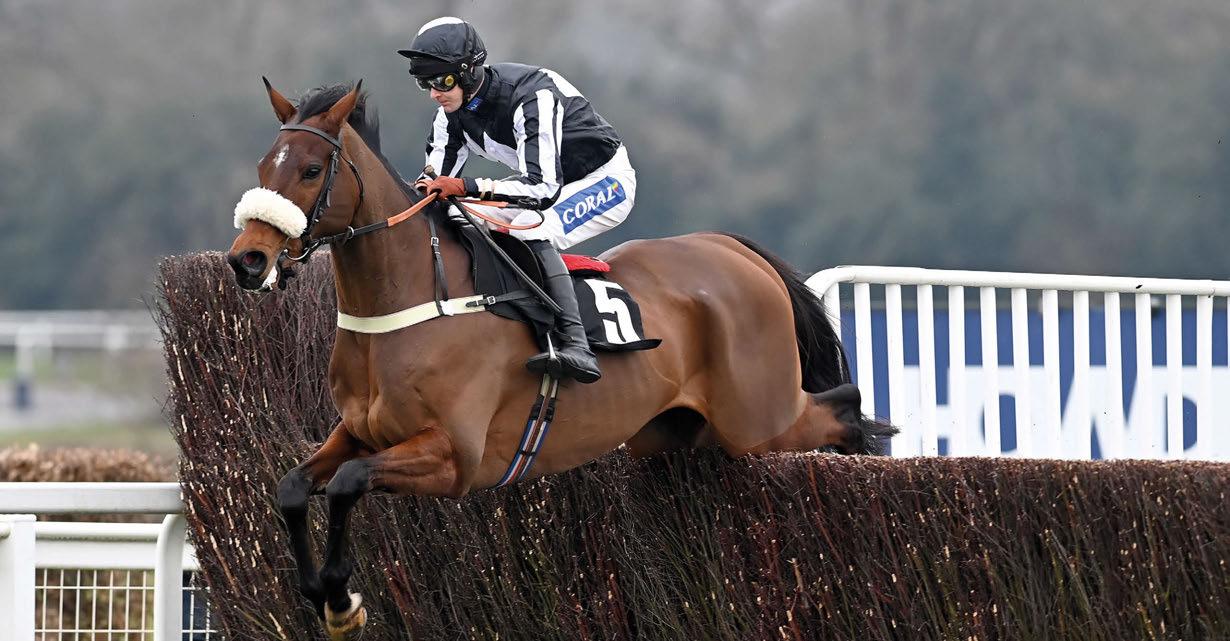


well against experienced horses in big handicaps, while First Confession didn’t turn up at Newbury in the Challow but had been in great form at home.
“There were a couple of glasses of bubbly and we were well looked after at Ascot, but that’s the same everywhere to be honest.”
Waterworth would know about that given he has owned horses since 2017 and has visited 49 of Britain’s tracks.
Ticking the remainder off the list is an ambition for him and wife Susan, who is “just as big a part of this” and was a “happy hacker” with her own horses when the pair met in Suffolk.
By then, the Northumberland native was a keen follower of the sport who jokes he probably “thinks about it too much” these days.
“My granddad Tommie had a real passion for horseracing and it was
always on at his house on a Saturday afternoon when we went there,” he says. “That’s where my passion came from and I continued it, mainly over the jumps, although we have owned and still do own Flat horses.
“The passion was jump racing, though; in the winter, all the family in a room watching it. I’ve fond memories of watching the Grand National like that and also when The Thinker won the Gold Cup after that snowstorm. I’m not sure it’s quite like that these days. When racing was on two of the three channels back in the day, it was always there for people, unless it was diving from Acapulco on World of Sport because the racing had been cancelled!
“I’d do a patent or Lucky 15 on a Saturday and take advantage of a day off in the week to go racing, and I remember going to Yarmouth a lot when

I worked down there. I always thought getting involved in ownership was something I’d do when I retired, and we had the time to enjoy it.”
Having built a successful holiday business, which in its pomp had 73 caravan parks in the UK, Waterworth was true to his word, albeit with racehorse ownership preceding retirement.
“I had a friend in Bristol who’d done a lot of advising for us and our business over the last 30 years and he said he was buying a horse and he knew I had an interest,” explains the 61-year-old.
“We bought a piece of My Lady Grey, our first horse who happened to be at Colin Tizzard’s. Because a lot of our business was in the south-west, I was going past the yard quite regularly and it suited us to have the horse there. That was in 2017 and I retired two years later. We then had War Lord, who did very well, winning six and being placed in a couple of Grade 1s.”
The son of parents who ran a taxi firm, Waterworth and his wife have accelerated their interest in racing in recent years, linking up with other owners to expand their string, which, at times, carry the owner’s black and white silks – a nod to his beloved Newcastle United.
“We have found it enjoyable,” he adds. “When you get more horses,
there’s more involvement and planning. We’ve got 19 horses at the Tizzard yard in various ownership guises. The majority are owned in conjunction with somebody else and we’ve found, as we’ve got further into it, you can have a wider portfolio if you’ve other people sharing half a horse or whatever it is.
“What we’re trying to do is create our own amazing memories”
“You’re sharing the reward, but also the risk as well. Some are people I’ve known previously – through work or friends – and, in the case of Ilovethenightlife, I met Geoff [Nicholas] through the yard.”
In full flow, the catering management graduate of what is now Sheffield Hallam University lays bare why this term has been so fruitful.
“Six of our eight novice hurdlers have won and both of our novice chasers
have won as well, while we’ve some youngsters coming through too,” he continues. “It’s quite a long game and patience isn’t one of my virtues, but you have to have it! We have progressed to buying a few more point-to-pointers now because, as you get older, it shortens the time between acquiring the horse and getting to the track.
“I didn’t think we’d have this many when we started, maybe half a dozen or eight, but, as we’ve got going and shared the burden, we’ve ended up with more and we’ve five, including First Confession, with Kevan Leggett now, for instance.”
Tizzard talent scout Ross Doyle is namechecked as a key component in the process of securing new purchases at the sales and he was responsible for helping source The Changing Man for £135,000 in 2020.
“I think we’re lucky we’ve done well in business, but you kind of have to write off the purchase price when you buy a horse, which is unfortunate,” replies the measured, down-to-earth Waterworth when the outlay versus income from prize-money is put to him.
“That said, if you can get a horse rated 115/120+ then you can cover your training costs and you can pick your way around races, too. We’ve won quite a bit of prize-money at Plumpton recently and sometimes the prize-money at a Plumpton or Taunton can be better in the week than some more premium tracks at the weekend.
“Racing isn’t something you go into to make money, but we love and enjoy it, and it doesn’t matter if you’re going to Hexham or Catterick or Taunton. You go to those smaller tracks and the crowd is knowledgeable, and it’s a big day out for the local area. You get a good atmosphere as people are there for the racing and not something else. War Lord took us to some big meetings, which we also enjoy, and hopefully some of the novices now can get us back there.”
Meetings, as Waterworth is well aware, do not come much bigger than this month’s Cheltenham Festival, which might be on the promising First Confession’s agenda, but will certainly be next for The Changing Man, who is a 40-1 shot for the Brown Advisory Novices’ Chase, but around 12-1 for the National Hunt Chase and challenging for favouritism in the Ultima.
“I’d love a winner at Cheltenham,” he says, not for one moment getting carried away at that thought but definitely letting a flicker of excitement be heard in his voice.
“Whether The Changing Man can get his head in front in one of the races he’s entered in is another matter, but he’s going to go there with a chance – a Festival winner would be phenomenal.
“He’d been a long way clear of the third when he’s been second in his races, and I think he’s learned a lot. It’s similar to when he was a novice hurdler; he got his head in front at Stratford after an indifferent season and then completed a hat-trick, which might have been a four-timer but for a loose shoe on his next start. He seems to have grown in confidence. We aimed him quite high as a novice chaser last season and I think he was unlucky at times, but his jumping has improved this year.”
It might need to again in the face of likely strong opposition from Ireland, although Waterworth is relaxed when questioned about the recent dominance of the raiding party.
“It’s not really crossed my mind, competing with them,” the owner goes on. “What we’re trying to do is create our own amazing memories. Going to Cheltenham is like going to the Olympics. The best jumpers in the world go there, but it looks like it could be more balanced this year. We won’t know for a few weeks and maybe it will swing back to Britain.”
The underlying reasons and causes for Irish success at Cheltenham have been pored over, but Waterworth is an enthusiastic, glass-half-full individual who acknowledges British racing isn’t perfect, yet prefers to extol what he views as the positives, rather than put the boot in like so many can be prone to do.
“Everyone is working hard to get it right and, for example, that jockeys’ championship on ITV is something I
John Waterworth
John Waterworth freely admits jumping occupies a bigger place in his heart than Flat racing, although he would love to capture one of the latter’s signature handicaps.
“I’ve been going to the Northumberland Plate for years and it would be extremely special to win that,” he says. “We’ve been in the Never Say Die syndicate, which [bloodstock agent] Richard Brown ran, and were involved with Onesmoothoperator, who won the race last year after being sold.
“We’ve got horses with Charlie Johnston on the Flat and before that with [his father] Mark, and we’ve done quite well. We were second in the Chesham with March Law and had various other bits and pieces. Pons Aelius won six and the Flat works where it is, but we’ve this shared ownership over jumps now, and Susan and I haven’t bought a horse outright for maybe three years. Everything purchased since has been with someone else as we like that approach.
“We enjoy the Flat but have just found like-minded people to share the jumpers with and we haven’t got that position on the Flat.
“We’re at a stage in life now where there are other things we want to do in the summer – travelling and holidays that might clash with Flat racing – and being able to attend meetings is why we have a lower number of horses on the Flat.”
quite like,” he outlines. “I think you’ve got to recognise the jockeys can be in a dangerous situation, which we’ve sadly seen recently, and they’re the personalities the public can latch on to.
“I think that’s the same way people latched on to Red Rum, Desert Orchid, Kauto Star, or Cue Card and Native River at the Tizzards’; they saw them regularly.
“Racing has to remember it’s an entertainment industry and is competing with everything else, which is why I think it’s also vital it remains on ITV. The job they do is fantastic and I love how they’ve extended coverage at tracks such as Exeter and I’m delighted Hexham is going to be covered later this year. ITV is our shop window, so the more of that, the better.”
In Colin and Joe Tizzard, Waterworth has found trainers he admires for their up-front honesty – “they tell it how it is”
– and discovered an unflinching, grass-roots affection for horses, which has left a lasting impression.
“I’m not sure people in general appreciate the love and passion everyone who works in racing has for the animal,” he says.
“There is so much passion for it and it doesn’t matter what yard you’re in. We love having horses with Joe and Colin before him. It works for us and it’s a team effort, but it would be the same if you went to another trainer. It’s different with other sports and I think the horses thrive off that devotion. Take the other day, The Changing Man and First Confession came in with their ears pricked at Ascot; they’d enjoyed themselves big time.”
Expect that to be the same for the Waterworths should either oblige at Cheltenham.

With new recruits such as Eldar Eldarov, Kew Gardens and Mogul joining a host of proven options, there is plenty to choose from within the British National Hunt stallion ranks
Words: James Thomas
Breeding has never been a pursuit for the faint hearted. And given rising costs, a polarised marketplace and a trend towards imports from France, National Hunt operators in Britain have
found the challenge that bit greater in recent times.
However, by the same token, breeders rarely lack resolve or optimism. And if your glass is half full then you tend to feel

the ends justify the means. So given the rewards on offer are as highly coveted as ever, be that on the racecourse or in the sales ring, plenty will be looking to pull some smart moves this breeding season.
Those scanning the ranks of British
Batsford Stud’s four-strong roster features two National Hunt names, including a promising newcomer in Kew Gardens
The well-bred son of Galileo is best remembered for running out a decisive winner of the 2018 St Leger, in which he got the better of the likes of Lah Ti Dar, Dee Ex Bee and Old Persian.
That was not his only Group 1 triumph though, as he also landed the Grand Prix de Paris earlier that season. And if those efforts highlighted Kew Gardens’ class, his final race showed he had the toughness to go with it.
His racecourse swansong came in the Group 2 Long Distance Cup, in which he bowed out with a defeat of no less an adversary than Stradivarius. The pair engaged in a tooth and nail battle inside the final furlong, and Kew Gardens achieved what few others could by outbattling the supreme stayer for a hardfought victory.
Although Kew Gardens showed plenty of tenacity on the track, his custodians at Batsford report the new recruit to be a
perfect gentleman in his new role.
“He arrived in October and he settled straight into the routine,” says the stud’s Tim Varey. “He’s such a nice-mannered horse that he settled straight into how we do things here. He’s very cool, calm and collected and feels like part of the furniture already. He’s a very well put together horse; he has a really good shoulder, nice hind limbs and stacks of bone. He stands at 16.2, so he’s a good size, and he’s certainly got the temperament to match.”
Kew Gardens retired to Coolmore’s Castlehyde roster in 2021, meaning his oldest crop are three this year. With the vast majority of his offspring still being at least a year away from hitting the racecourse, he remains firmly in the ‘could be anything’ category.
“The reception has been very, very good,” says Varey. “Everyone who’s come to inspect him has been really pleased with what they’ve seen. Obviously people have seen the videos of his walk, but to actually see him in the flesh is another
thing. He’s such a nice stamp of a horse that I don’t think photos and videos really do him justice. It doesn’t matter how good they are, it’s only once you’ve seen the horse in the flesh that you really get a sense of how good he is.”
Explaining how the deal was done to stand the promising young sire, Varey says: “We spoke to Coolmore and said we’d like to throw our cap in the ring if they were thinking of doing any stallion movements. First they said they’d consider us, then we got another call saying we would be getting a stallion but they hadn’t quite decided what they were doing in terms of new recruits. Then we got a very surprising phone call that they’d like us to stand Kew Gardens for them. That was the kind of offer you can’t refuse.”
Kew Gardens covered a three-figure number of mares in his first two seasons at stud, including a debut book that stood at 198. This gives him plenty of ammunition with which to make his mark over the coming years.

jumps sires have the best part of 40 names to conjure with in 2025. These range from new retirees to proven producers, there are budget options, blue-chip operators and one or two that continue to fly under the radar. To help navigate the crucial mating
“We’ve seen a few of his progeny and what we’ve seen we’ve liked,” says Varey. “And we’ve had good reports from Ireland from breeders who’ve got his stock too. He’s still a young horse, he’s a very nicely bred son of Galileo, and he’s got the conformation to go with it, so it’ll be really exciting to see his youngsters run in another 12 months or so. He’s been well received here and we’re happy with the amount of mares he’s already got booked in. It’s fantastic to have him.”
Kew Gardens is joined by the redoubtable Passing Glance, for whom this will be a 20th season on stallion duty. The son of Polar Falcon has compiled a stud record that would be the envy of many stallions who have covered bigger books at flashier fees.
His three Grade 1 scorers are headed by the popular veteran Dashel Drasher, a prolific winner whose Ascot Chase victory in 2021 contributed a tidy sum to career prize-money earnings of over £450,000. Passing Glance also sired the Manifesto Novices’ Chase victor Millers Bank and Olly Murphy’s Liverpool Hurdle winner Strong Leader.
Batsford’s social media accounts recently shared a video of Passing
plans process, we profile the full roster below.
Grace Skelton’s Alne Park Stud in the heart of Warwickshire is home to four stallions in 2025, including Dink (£3,000). The 21-year-old is the only son of major jumps influence Poliglote standing at stud, and is best known as the sire of Dan Skelton’s high-class two-mile chaser Nube Negra.
The upcoming breeding season will be Dink’s fifth in Britain after he moved from Haras de la Bareliere in France. Although he has had an incredibly limited amount of racecourse representation in Britain and Ireland, that is set to improve over the coming years having covered a combined total of over 100 mares in the four seasons since arriving from across the Channel.
The other proven name on the Alne Park roster is Ocovango, who made the switch from The Beeches Stud in 2023. The son of Monsun is the only British-based sire inside the top ten of the current jumps sires’ table, primarily on account of Sara Bradstock’s progressive stayer Mr Vango landing the London National and Peter Marsh Chase. Ocovango tops the Alne Park roster at a fee of £4,500.
The stud welcomed newcomers in both
Glance showing off his well being with an acrobatic display in the stud’s lunge ring.
“The old boy is 26 but he still thinks he’s a two-year-old!” says Varey. “He’s still so athletic and can still pull some real shapes. He’s extremely well, he’s in even better condition than he was last year. We keep him very fit because of his age and because of the job we’re asking him to do, and he takes it so well. He really thrives on
2023 and 2024, with Midnights Legacy, the only son of Midnight Legend at stud, first to join the ranks, followed by Gold Cup hero Subjectivist 12 months later. Midnights Legacy, who stands for £3,000, has covered select books in his first two seasons, while Weatherbys records Subjectivisit, who is standing at £4,000, as serving a debut book of 33 mares.
The roster at Roisin Close’s Chapel Stud has been boosted by the arrival of St Leger hero Eldar Eldarov. The well-bred son of Dubawi hails from the same prolific Kirsten Rausing family as Arc heroine Alpinista, and cost owners KHK Racing £480,000 when purchased by Oliver St Lawrence from Norman Williamson as a breeze-up two-year-old.
Trained by Roger Varian, Eldar Eldarov won his first start at two and his first two starts at three, including the Group 2 Queen’s Vase at Royal Ascot. He tasted Classic glory later that season when running out a two-length winner of the St Leger. He further highlighted his talents at four when he dismissed champion stayer Kyprios by no less than three and a half lengths in the Irish St Leger.
He was set to resume racing in 2024
the job.
“Understandably breeders might back off him a little because of his age, but you just have to come and have a look at him and see how well he looks. He was still very fertile last year so we’ll just keep going with him for as long as we can. He’s still producing some really nice winners.”
Both Kew Gardens and Passing Glance will stand at a fee of £3,000.

›› but those plans were scratched in cruel circumstances when he suffered a lifethreatening neck injury after rearing and striking his head in the gates after a rival kicked his stall in the moments before the Dubai Gold Cup. He underwent surgery and showed the same toughness he displayed on the racecourse to make a full recovery. He is being introduced at £5,000 and will cover a limited debut book.
Eldar Eldarov is standing alongside Bangkok, the tough Group 2-winning son of Australia who is standing a fourth consecutive term at £3,000. The line-up is completed by Planteur, available at a fee of £4,000. The son of Danehill Dancer is best known as the sire of Group 1-winning Trueshan, but he has also produced an elite winner over jumps too in the shape of Grand Steeplechase de Paris scorer Gran Diose.
Wells Farhh Go relocates to Nunstainton
A stone’s throw from Sedgefield
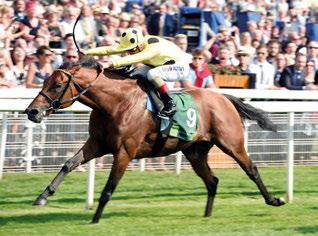
Postponed: Group 1 winner is already showing promise in a dual-purpose role
racecourse sits the Dawson family’s Nunstainton Stud, which is home to Cannock Chase, Dragon Dancer, Kingston Hill and new recruit Wells Farhh Go.
Cannock Chase was a notably highclass racehorse. He continued a family tradition by winning at Royal Ascot, and his Tercentenary Stakes success was followed by an even bigger victory in the Grade 1 Canadian International. Despite limited opportunities in his relatively short stud
career he has already come up with one classy performer in Cannock Park, who finished third to Jango Baie in the 2023 Tolworth Hurdle.
Dragon Dancer is well remembered for finishing a short-head second to Sir Percy in the 2006 Derby. He retired to stud in France, where he sired the likes of Rebecca Curtis’s useful performers Haiti Couleurs. Cannock Chase and Dragon Dancer both stand at £2,000, while headline act Kingston Hill is available at £3,000.
The grey son of Mastercraftsman certainly had an affinity with the north during his time on the track as he won two Group 1s at Doncaster, namely the Racing Post Trophy at two and the St Leger at three. Kingston Hill began his second career under the Coolmore banner, with his second crop containing Grade 2-winning hurdler No Looking Back. He has come in for his share of support since relocating to Nunstainton in 2022, having covered over 170 mares in the last three years.
Wells Farhh Go has joined the roster for
Willow Wood Farm has doubled its number of stallions for the 2025 season, with the well-credentialled Mogul recruited from The Beeches Stud in Ireland. The son of Galileo hails from a superb family, being out of Newsells Park Stud’s blue hen Shastye.
This means he is a full-sibling to four black-type performers, including Juddmonte International hero Japan. Their sister Secret Gesture not only won the Group 2 Middleton Stakes herself, but has helped the pedigree progress at a rate of knots having bred four stakes performers from her first five foals, including the starcrossed Chester Vase scorer Hidden Law. Mogul is also bred on the famed Galileo-Danehill cross that has yielded the likes of Frankel, Galiway, Highland Reel, Kyprios and Teofilo, to name but a few.
This top-class pedigree, allied to some stunning looks, helped Mogul realise 3,400,000gns to the bid of Coolmore’s MV Magnier when he changed hands at the 2018 renewal of Book 1 of the Tattersalls October Yearling Sale.
It was a case of blood will out once Mogul went into training with Aidan O’Brien as he developed into an elite performer over the course of three seasons in training. The most notable of his five victories came in the Group
1 Grand Prix de Paris, in which he beat In Swoop by two and a half lengths, before he showcased his talent on the international stage by running out a commanding winner of the Hong Kong Vase.
Mogul has been introduced to British breeders at £2,500, and will stand alongside Irish Derby and St Leger hero Capri, who is available at the same fee.
Taking up the story of how Mogul came to stand at Willow Wood Farm, the stud’s Stuart Ross says: “I saw Robert McCarthy [of The Beeches Stud] up at Doncaster when I was selling a mare and was chatting to him and Albert Sherwood, and they asked how I was going with Capri. A week or so later Robert phoned me up and said a deal for Mogul to go to France had fallen through and would I be interested.
“I said I’d have a think about it and get back to him. The only thing I really had to consider was standing two sons of Galileo, because when you only have two stallions it’s a bit like putting all your eggs in one basket. However, when I sat down and thought about it, I thought Coolmore have just asked me if I would like a two-time Group 1 winner who cost 3,400,000gns as a yearling, and had rave reviews as a racehorse and when he first went to
stud. The more I thought about it, the more I couldn’t talk myself out of it.”
After winning two Group 1s on the track, Mogul retired to The Beeches Stud in 2022 and duly covered 168 mares, a number that increased to 202 the following year, according to Weatherbys records. Ross acknowledges that the prices Mogul’s foals achieved at the sales could have been stronger, but not unreasonably suggests this may say more about the state of the National Hunt market at present, rather than the horse himself.
“I know his sales results have been a little disappointing, but hasn’t every National Hunt stallion been in the same boat, with the exception of about four of the big boys?” he says. “When he had his first foals selling I had a look at those and I certainly didn’t see anything to put me off. I also saw some of his stock when I was at The Beeches, they showed me a couple, and they were great looking. Once I’d agreed the contracts got sorted very quickly and I went over and picked him up myself. Robert McCarthy and the lads who’d handled the horse couldn’t have been more helpful.”
Mogul has been at his new residence since early February and has reportedly made himself right at home.
“I think he would settle anywhere,”
2025, taking the place of Falco, who has been sold to Turkey. The son of Farhh won two Group 3s during his time on the track, namely the Acomb Stakes at two and the Bahrain Trophy at three, and was backed by his trainer Tim Easterby during his two seasons at Norton Grove Stud.
Overbury Stud has long been a seat of National Hunt power. The Gloucestershire farm was home to Kayf Tara, a leading light of the British jumps breeding scene responsible for stars such as Carruthers, Edwardstone, Special Tiara and Thistlecrack. That mantle appears to have been taken up by the new golden boy of the British National Hunt ranks, Golden Horn
It is perhaps a sign of the times that jumps breeders have access to Golden Horn at all, as the Derby and Arc hero has proved particularly adept at siring classy Flat talents. His record features 53 Flat


says Ross. “He’s got one care in the world, and that’s have I got enough food! I’ve walked him around a yard full of mares and he’s very well mannered, he stands up tall and proud but he doesn’t shout and scream. But when the feed cart goes around in the morning, that’s when he screams and shouts!”
Asked to describe Mogul’s looks, Ross chuckles and says: “I’ll quote Robert McCarthy when I asked him. I said ‘I haven’t seen him in the flesh, is he good-looking?’ And Robert said ‘He cost 3,400,000gns as a yearling.’
So I said ‘But is he good-looking?’ and Robert said ‘I’ll repeat, he was 3,400,000gns as a yearling!’ At that
point the penny dropped.
“He’s absolutely stunning. He’s a really strong horse; it’s that mixture of strength from Danehill but the class of Galileo. When he stands up in the yard, it’s hard to see what anyone could ever pick fault with. To me, he’s really got that x-factor.”
Ross’s excitement at Mogul’s arrival is palpable, and he hopes breeders will share in his enthusiasm for the horse.
“If you’d have said to me three years ago that I’d be standing two stallions of this calibre, one dual Classic winner and one dual Group 1 winner, both with impeccable pedigrees and great models, I wouldn’t have believed it,” he says.
stakes performers, including the Long Distance Cup scorer and Gold Cup runnerup Trawlerman, Queen’s Vase winner Gregory, and Italian Derby victor Goldenas. But the toughness of his stock has also been highlighted by a burgeoning roll of honour over jumps, which includes the dual Grade 2-winning juvenile hurdler East India Dock, Grade 2 novice chase scorer Mark Of Gold and Golden Ace. The latter got the better of Brighterdaysahead to win the Dawn Run Mares’ Novices’ Hurdle at last year’s Cheltenham Festival, and added this year’s Kingwell Hurdle to her tally of victories.
All this augurs well for what lies in store once more of his jumps-bred stock come on stream. It is worth noting that his 2024 book of mares included the dam of none other than Constitution Hill, as well as the dams of other significant talents such as Burrows Saint, Guard Your Dreams, Le Milos, Navajo Pass, Santini and The New Lion. Among the classy racemares in his latest book were Annie Mc, Buildmeupbuttercup, Casablanca Mix, Dolcita, Echoes In Rain, Happy Diva, L’Unique, Misty Whisky, Pilaster and Urban Artist.
At £10,000, Golden Horn is the most expensive sire on this list. But when you see the likes of Willie Mullins paying up to 330,000gns for his progeny, and given the immense potential highlighted by his early racecourse results, it is hard not to conclude a bright future makes such a fee seem entirely justified.
There is also growing momentum behind another Overbury resident in
Jack Hobbs (£4,000). The son of Halling’s first crop may have only just turned six but he has already sired a healthy number of winners on the track and between the flags.
The esteem buyers hold Jack Hobbs in is illustrated by his offspring fetching a slew of chunky prices. His most expensive sales graduate is Intense Approach, a £210,000 purchase by John McConnell who has now won six times under Rules, as well as finishing runner-up in the Persian War Novices’ Hurdle. He has enjoyed notable support from within the point-topoint sector, including some of the major Irish operations such as Warren Ewing and the Doyle family of Monbeg Stables. And with sizeable crops in the pipeline, there is every reason to believe he can maintain his upwardly-mobile profile.
The elder stateman of the roster is the ever-reliable Schiaparelli. The 22-year-old son of Monsun has now won four consecutive Horse & Hound Cups at the TBA National Hunt Awards for being the leading British-based stallion of steeplechase winners. His leading performers include the high-class Ronald Pump, Cheltenham Festival scorer Indefatigable and dual Listed winner Marsh Wren. This season he has been represented by the progressive Wyenot, winner of the Listed Doncaster Mares’ Hurdle. Schiaparelli is again standing at £2,000.
The Overbury line-up is completed by Frontiersman, the son of Dubawi and Ouija Board, and therefore a half-brother to Derby hero turned Group 1 sire Australia. With his first crop still only five we are yet to see what Frontiersman is fully capable of as a National Hunt sire, although there are encouraging signs as he has already thrown the Grade 3-placed juvenile hurdler Dodger Long as well as the 104-rated Flat performer Asian Daze, who was sold on to Gai Waterhouse and Adrian Bott for £200,000. He also has some fair-sized crops in the pipeline, all of which could make a £2,000 fee look like money well spent in the years to come.
Another Classic-winning racehorse whose offspring have been the subject of positive whispers is Shade Oak Stud’s Logician, a son of Frankel from a typically deep Juddmonte pedigree.
Logician more than upheld family honour during a racing career that was cut short by illness. He won his first six starts, including the Great Voltigeur Stakes and, more importantly, the St Leger. He not only won the season’s oldest Classic, but set a new course record in the process.
That profile has not gone unnoticed, as his first three seasons at stud have resulted in books numbering 183, 169 and 112 mares, figures that are underpinned by a high percentage of quality names to boot.
Although the Logician foals that have hit the sales have recorded some perfectly reasonable results, the softening of the market means the exact sums involved probably underplay the respect he is being afforded. Instead, it is perhaps more illustrative that renowned judges such as the Bleahen brothers have been just about his strongest supporter in the sales ring, while the likes of Gerry Hogan, John O’Connor and Peel Bloodstock have also purchased youngstock by the stallion. Those names alone could prove a powerful set of allies for anyone thinking of using Logician at a reduced fee of £3,500.
The other stallion on the Shade Oak roster is Dartmouth (£2,500), who carried the Queen’s colours to victory in the 2016 Hardwicke Stakes and the following year’s
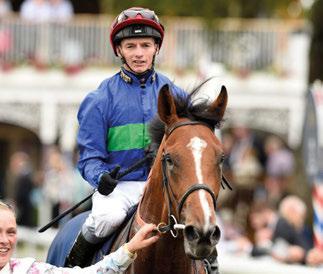
The well-bred son of Dubawi received royal support in his second career as the late Queen Elizabeth II bred Naval College, a Flat novice winner for Dartmouth’s trainer Sir Michael Stoute who went on to land a brace of Listed contests having transferred to Australia. With his first crop having just turned six, there is still time for Dartmouth to come up with similar talents over obstacles.
Yorton Farm’s four-strong line-up is led by Postponed, who is entering into his second season at the Welshpool stud at an upgraded fee of £6,000. The two-time European champion has come up with the Group 2-placed Night Sparkle on the level, and has impressed with the limited number of runners he has fielded over obstacles.
His jumpers include Familiar Dreams, a 4,000gns horses-in-training buy who
realised €310,000 after winning a Grade 3 bumper at Punchestown, and other useful types such as Majestic Jameela and Zestful. Although it is still early days, a National Hunt black-type performers to runners ratio of 14 per cent catches the eye in a major way.
Pether’s Moon may not have the flashy profile of Postponed, but the son of Dylan Thomas has posted some similarly taking statistics. His 20 winners in the 2023-24 season came at a clip of 39 per cent, which puts him very much in the top bracket of stallions by winners to runners. He has already surpassed that tally of winners and is maintaining a similarly high strike-rate in the current season too.
Admittedly he lacks the kind of headline performer that stallions need to really put their name in lights, but having gone about his business with proficiency, and with reasonable numbers in the pipeline, a fee of £3,000 looks fair value.
Ito makes obvious appeal on pedigree being a son of Adlerflug out of the German Oaks winner Iota, making him a full-brother to German Derby hero and Beeches Stud stallion In Swoop.
Ito also won a Group 1, claiming the Grosser Preis von Bayern, and duly began covering Flat mares in his native Germany, where he sired the Group 2-placed Theodora, among others. He joined the Yorton ranks in 2023, meaning we are yet to see his stock really test their mettle over jumps. But if he can convert his paper credentials into racecourse performance, he looks a name to note at a fee of £3,000.
The Yorton stallion with the deepest stud record is Gentlewave (private fee), the 22-year-old son of Monsun who initially retired to Haras du Thenney back in 2007. His Graded winners include Charlie Hall Chase scorer Gentlemansgame and Kerry National victor Poker Party. Gentlewave also hit the headlines in recent years as the sire of Easysland, a runaway winner of the Cross Country Chase at the Cheltenham Festival.
Yorton is also involved in the ownership of Arrigo (£2,000), the Shirocco halfbrother to Adlerflug who is spending his second season at Bullbrook Farm in Somerset under a lease agreement with Chloe Roddick.
Breeders on a budget could do a lot worse than Yorgunnabelucky, who is standing at Mickley Stud at a fee of £2,500. The brother to Shamardal has come up with some big results from relatively limited opportunities, including the high-class two-mile chaser Libberty Hunter, a winner
Galileo x Chelsea Rose (Desert King) New to the UK in 2025

Tough Dual Group 1 Classic Winner by GALILEO Out of Group 1 winner CHELSEA ROSE His first crop of 108 will be three-year-olds in 2025
Polar Falcon x Spurned (Robellino)












›› at Cheltenham and runner-up in the Game Spirit Chase, as well as the progressive Newbury novice hurdle winner Rubber Ball. Fans of King George hero Hewick have access to his sire Virtual, who stands at Etheridge Farm and Stud in Dorset at a fee of £750. Langaller Farm sits on the edge of Dartmoor National Park and is home to Forever Now (£600), a Listed-winning Galileo brother to black type trio Gan Amhras, Shantaram and To Eternity.
Vauterhill Stud is in a similar neck of the woods and offers breeders three value options in 2025, namely German Derby winner Nutan, Sans Frontieres, sire of the classy Jason The Militant, and Top Trip, whose flag has been flown this season by Willie Mullins’ upwardly mobile chaser Sa Majeste. Fees are available upon application.
March Hare Stud is home to the LM Stallions roster, which features Teofilo’s
Stallion movements across the Irish Sea have gone both ways in 2025, with Group 1-winning Dubai Mile swapping Marlborough’s Manton Park for Coolagown Stud in County Cork. He is best remembered for his gutsy win in the Criterium de Saint-Cloud, in which he got the better of Boardsmill Stud recruit Arrest.
And the five-year-old boasts pedigree as well as performance, as he is the highest-achieving offspring of the star-crossed Roaring Lion, whose loss has been brought into sharp focus by the exploits of high-class runners such as Middle Earth, Queen Of The Pride and Running Lion. In turn, Roaring Lion is a son of Kitten’s Joy, whose stock as a sire of sires has risen in no uncertain terms thanks to the exploits of leading freshman Kameko.
Dubai Mile’s damside holds just as much appeal, as he is out of Beach Bunny, who won the Listed Dance Design Stakes and came within a shorthead of denying the brilliant Dar Re Mi in the Group 1 Pretty Polly Stakes.
Beach Bunny has proved similarly adept at the paddocks as Dubai Mile is one of three black-type performers she has bred, along with stakes winners Naadirr and Beach Belle. It is also worth noting that Beach Bunny is a daughter of High Chaparral, a fixture in pedigrees of top-class performers under both codes, including the likes of Altior and Penhill over jumps.
Given this profile, it stands to reason that Dubai Mile would be on the radar of both Flat and jumps breeders.
“We’re standing him as a dualpurpose horse and he’s already attracted some very nice mares,” says Coolagown’s David Stack.
“We’ve over 100 mares already booked, and the funny thing is almost half his book are British-based mares
that are following him over.
“There’s a huge appetite for him because he’s something a bit different in terms of pedigree. He was a topclass racehorse himself, as was his sire, Roaring Lion. There’s High Chaparral high up in his pedigree, he’s getting big winners left, right and centre. Kitten’s Joy is in there as well. He’s got a huge mix in his family and his damline is one of the best in the book, going back to a Classic winner in Miss France. There’s class right the way through his pedigree.”
Dubai Mile has been at Coolagown since last year and is already up-andrunning for the 2025 covering season. “He arrived over with us in September and has settled in and has really let down into a lovely stamp of a horse,” Stack reports. “He was very popular during the Irish Stallion Trail. If anyone wasn’t sure what to expect from him, I’d say they were won over when they saw him then. He’s 16.1, a very strong, imposing individual with super movement who really fills the eye.”
Breeders considering sending a mare to Dubai Mile can do so safe in the knowledge that connections are firmly behind the horse. Plenty of Coolagown’s own mares will be visiting Dubai Mile, who can also call upon the support of former joint trainer Mark Johnston and, more significantly, his owner Ahmad Al Shaikh.
“Ahmad Al Shaikh is sending all his mares to Dubai Mile, so he’s going to be very strongly supported,” said the owner’s bloodstock agent Federico Barberini, who went on to highlight some of the notable names among the 2025 book. “There’s a Listed winner by Iffraaj called Blhadawa, she’s already foaled to him and is going back this year. There’s a Group winner and Group 1 second called Zghorta Dance, she’s carrying to him and will go back also. Princess Salamah bred
dual Group 2-winning son Diplomat (£1,500), also a winner over jumps.
Groomsbridge Stud is also standing a son of Teofilo, with the seven-time winner and multiple Group-placed Mildenberger available at £1,000.
Withyslade Farm in the Nadder Valley is home to Eastern Anthem, the blueblooded son of Singspiel who won the Dubai Sheema Classic. He is standing for £1,250.

the Group 3 winner Al Shabab Storm with her first foal. She’s already foaled a lovely filly by Dubai Mile and is another going back this year.”
It is not just at stud that Al Shaikh will be behind Dubai Mile. Barberini continues: “He’s looking to buy foals by him too when the time comes, which means his stock will be going into very good yards when they go into training. He really wants to give the horse the best chance possible because he really believes in him.
“He went out and bought mares last year to support him, and that support is going to continue this year, especially because we’re so happy with the foals we’re seeing. He’s had three foals so far and all three are out of black-type mares.
“We’re treating him as a Flat horse, but given his profile, and given that he stayed so well, he will inevitably attract National Hunt mares as well, which are more than welcome. It’s all about giving him a good start with a good number of quality foals and good support.”
Dubai Mile is standing at a fee of €4,000 with filly concessions. He is joined on the Coolagown roster by Kenway, the only son of Galiway standing in Britain or Ireland, the up-andcoming Storm The Stars and Way To Paris, a Group 1-winning son of Champs Elysees.
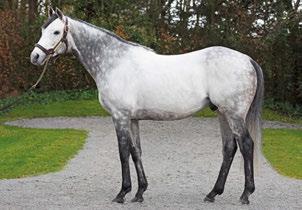
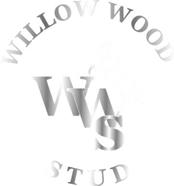
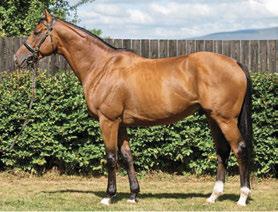
CHAMPION 3YO Stayer in Europe 2017 A 3.4 million Guineas Yearling
- Group 3 Winner at 2
- Dual CLASSIC Winner at 3
- Group 3 Winner at 4
- Defeated the best colts of his generation
- Group 2 Winner at 2
- Winner of the Grand Prix De Paris Group 1
- Winner of Hong Kong Vase Group 1
- Winner of The Gordon Stakes Group 3
Contact: Stuart Ross

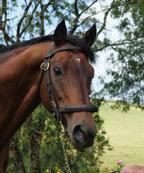

By Mastercraftsman ex. Audacieuse
l Unbeaten Group 1 winning 2yo.
l Classic Winner & Champion Stayer in Europe at 3.
l 7th leading ‘young’ sire in Europe 2024-25 by winners.
l Winners include recent Listed bumper winner Kingston Queen, King Ulanda, Irish Hill and King Arise
l 3yo stores made up to £50k
By Lemon Drop Kid ex. Lynwood Chase
l Group Winner over 10/12f, incl. Canadian International.
l 50% runners to winners over hurdles.
l Already the sire of Gr.1 placed Cannock Park, the promising To Chase A Dream (or 129) and recent winner Foster’s Fortune
l GB point winners recently also with The Yellow Mini and Wottinger

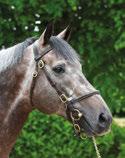

By Sadler’s
Wells ex. Alakananda
l Consistent Group-Level Performer over 12f, incl. beaten a short head in the 2006 Derby.
l Sire of Winners under Both Codes.
l Top class pedigree, looks, confirmation and temperament.
l 60% winner to runners over fences.
l Winners include the Cheltenham Festival hope Haiti Couleurs, bumper winner Romeo Foxtrot and hurdles winner Double Dragon
By Farhh ex. Mowazana
l Unbeaten at 2yrs incl. Gr.3 Acomb Stakes.
l Also won the Gr.3 Bahrain Trophy at 3yrs and the Listed Fred Archer Stakes at 4yrs.
l Oldest crop are now yearlings.
l His trainer Tim Easterby says ‘We have 14 yearlings by Wells Farrh Go that are showing tremendous promise. They are strong, forward types with brilliant temperaments. We couldn’t be more pleased with them and look forward to seeing them on the racecourse’
New
transport regulations currently being discussed within
the European Union will have far-reaching ramifications for the bloodstock industry should they be passed through
Words: Nancy Sexton
Plans by the European Union (EU) to review its regulations for the transport of animals was borne out of well-meaning intentions. Around 1.8 billion animals are destined for slaughter each year in the EU, some of them transported in abominable conditions. The European Commission’s (EC) announcement of a new Farm To Fork strategy in 2020 was designed to tackle those issues head on and hopefully improve the wellbeing of such animals in the process.
Unfortunately the European bloodstock industry now finds itself embroiled in the issue. For while racehorses and other elite equestrian disciplines have been granted an exemption from the proposed regulations, Thoroughbred bloodstock has not despite being a high-health breed
registered within a stud book.
The bottom line is that should these revisions be passed without the bloodstock industry receiving a derogation, then breeders will be forced to rethink how they operate.
Why? The new proposals include the following:
• A seven-day residency requirement for monitoring following travelling or journeys of eight hours or more, meaning that any horse coming into a sales complex anywhere in the EU will have to remain resident at that property for seven days.
• The prohibition of the transport of mares once they have passed the 80 per cent point of gestation.
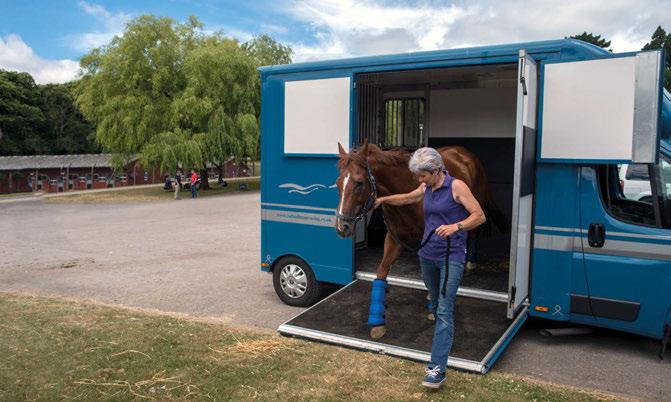
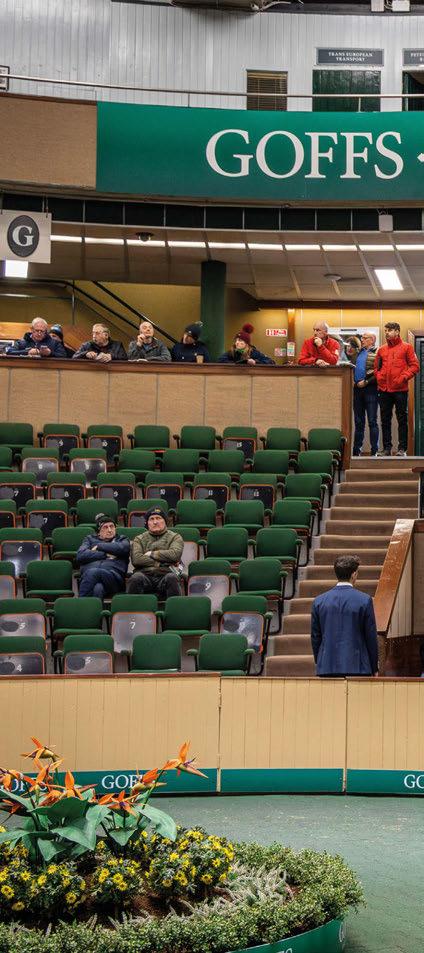
• The prohibition of the transport of foals during the immediate postpartum period.
• Unloading and vet checks at all border crossings.
While this is primarily a matter for EU countries, it is naive to think that Britain won’t be affected given the amount of business it conducts with Ireland, France and Germany among others.
“If these EU proposals are implemented, it would basically bring the breeding of racehorses to a halt,” says Kirsten Rausing, Chair of the International Thoroughbred Breeders’ Federation (ITBF) and Honorary President of the European Federation of Thoroughbred Breeders’ Association (EFTBA). “To some extent I understand

where they are coming from because some of these horses destined for slaughter across the EU are transported in dreadful conditions.”
She adds: “A derogation has been agreed on Thoroughbred racehorses and other sports horses, but they seem to be unwilling to agree a similar exemption for Thoroughbred breeding stock. So by that, the Thoroughbred industry is being equated with the lowest denominator –horses destined for slaughter.”
Paull Khan has been involved in the lengthy and ongoing discussions with Brussels in his role as Secretary-General of the European and Mediterranean Horseracing Federation (EMHF). He also sits on the board of the World Horse Network, and as such has been a key
contributor when it comes to arguing for the importance of a derogation.
“The aims are laudable, in that it seeks to improve animal welfare and ensure laws are based on scientific evidence,” he says. “The specific focus on welfare in transport was aimed primarily at improving the lot of animals being transported to be slaughtered.
“While the review covers several animal species, the Commission did ask the body that gives it scientific advice on such matters – the European Food Safety Authority (EFSA) – to give an opinion on the transport of horses on long journeys to slaughterhouses.
“Under the current legislation, which has served us well for the past two decades, our sector’s horses, be they racehorses or
breeding stock, are defined as ‘registered’ and thereby enjoy derogations from many burdensome administrative requirements. Over the past three years, we at the EMHF have been keeping a close eye on what was happening in Brussels, and made a number of submissions, both in writing and in person, where we argued that those freedoms of movement must be retained in future legislation to allow our economically-important industry to continue to thrive. We did this in conjunction with the EFTBA and called specifically for derogations to include the breeding and sales sectors.
“The Commission’s proposals changed the basis for derogation, from the classification of the horse (as ‘Registered’) to the purpose of the journey.
“The proposals would halt the breeding of racehorses if implemented”
“The good news was that travel for racing or training purposes was given substantial derogations; the bad news was that travel for breeding and sales was not.”
The potential implications of the new regulations are obviously far-reaching.
Like Khan, Des Leadon and Joe Hernon have lobbied hard on behalf of the Thoroughbred industry with Brussels.
Leadon, who bred top Hong Kong performer Dinozzo and Classic-placed Arrest with his wife Mariann Klay at Swordlestown Little Stud in County Kildare, is also the veterinary advisor to the Irish Thoroughbred Breeders Association (ITBA) and Chairman of the veterinary advisory committees of the EFTBA and ITBF.
Hernon is also a manager at Coolmore’s Castlehyde Stud.
Both have been instrumental in highlighting the issue to a wider audience. Leadon, in his role at the ITBA, wrote of the potential ramifications in this magazine last month and spoke again of it at the ITBA Breeding Preparation Seminar ahead of the Goffs February Sale. It is worth revisiting what has been said.
“EFSA published its report in September 2022 and stated that it had found no evidence to differentiate the effects of transport between registered
›› horses and those destined for slaughter,” says Leadon. “EFSA chose ‘to treat them as one’. The EU responded by drafting welfare in transport regulations for all horses, which include inspection protocols at loading and unloading, at border crossings and stipulating journey durations, per movement residency requirements and on temperature ranges in which such movements can take place.
“The absence of a derogation for the breeding industry has multiple ramifications which will have significant adverse consequences.”
He adds: “The seven-day residency requirement is incompatible with the current facilities and practices of Thoroughbred auction sales. Documentary evidence of this fact, supplied by all of Europe’s major sales companies, has been sent to by EFTBA to the EU.
“The proposal to forbid the transport of pregnant mares beyond 80 per cent of gestation will prevent the transfer of mares from private stud farms to foaling units. This proposal failed to take account of the wide range of normal gestation in Thoroughbred mares – which makes it impossible to identify 80 per cent
of gestation. Furthermore, there is no evidence that transport of pregnant mares beyond this arbitrary limit is deleterious. There are literally no reports, scientific or otherwise, of our mares aborting on vehicles or in the immediate aftermath of road journeys. The industry closely monitors and scrutinises abortion – all the more so because of the fear of spread of equine herpes virus (EHV) infections.
“The proposal that young foals should not be transported post-partum would preclude foal-heat coverings. Mares with foals at foot are always transported with enough space for foals to move around the mare and suckle from either side as they choose. They are always provided with a suitable bedding surface to enable them to lie down if and when they choose. We have known for more than four decades, as a result of work of the late Dr Peter Rossdale and his colleagues’ work on neonatology, that Thoroughbred foals have completed their postnatal adaptation by 72 hrs postpartum. Thereafter, they are simply ‘little adults’.
“The proposals for mandatory state veterinarian inspection of all loading and unloading is unworkable. Those for
World Horse Welfare is very much in favour with the idea of frictionless sport horse movement but would like to see digital traceability measures enforced to prevent any misuse. As such, while the charity shares some concerns over the EU transport proposals, it does not back a derogation.
“We are completely aligned with horse sport, we want horse sport to thrive and we’re aligned in that we feel that some of the proposals would be counter-productive for that and horse welfare,” says Jessica Stark, Director of Communications and Public Affairs at World Horse Welfare. “We don’t agree on measuring external temperatures for example, or the residency requirements. There’s a lot that we have in common [with the lobbyists] and we have been working with the European Horse Network on that, which is great.
“The big question is the issue of the derogation. It’s important to state that we’re not singling out racing or breeding on this; we just don’t believe in derogations because we know that people use them as loopholes that can make the law less enforceable.
“We think that the existing transport regulations can be improved and we’re excited to have an opportunity to look at that. But we’d like to see it bring in basic standards that can work for the sector and that can actually improve welfare for those horses that might not be so protected.”
That’s where digital traceability and how it can potentially strengthen the industry comes in.
“We fully support the principle of frictionless movement across borders for race and sports horses who are verifiably and individually traceable in real time,” says Stark. “That would include the legitimate and verifiable movement of breeding horses. We really think there’s an opportunity for the sport to self regulate, where it says ‘we want to have frictionless movement and have a system in place where we can monitor, enforce and make sure that nobody uses our sport as a cover to do the wrong thing’.
“We want sport to be able to move horses easily and if that system, whereby horses could be traced in real time, was in place, then we would fully support it. What we don’t want is people using sport and breeding as a cover to transport horses in poor conditions.”

compulsory unloading at all state border crossings do not take account of the facts that this creates biohazards and risks injury.”
Various organisations within the industry have been aware of the looming issue since the EFSA published its report in September 2022 and lobbying has taken place to that effect. In that, they are not fully backed by World Horse Welfare; while the charity agrees that several of the proposals would be counter-productive, its feels that a derogation is not the way forward (see panel).
There has been numerous correspondence with the EU Commission, including a letter written by Hernon to which the Commission answered with a series of questions – some of them almost impossible to answer.
“Question one was ‘what are the routes and distances travelled by breeding horses?’” says Leadon. “EFTBA responded that as many of the racing centres of Europe are synonymous with its breeding centres, the routes and distances travelled were essentially the same and that racing had been given a derogation, but that breeding had not.
“Question two asked for the numbers of breeding-related movements. EFTBA responded by stating that if one takes the global population of European Thoroughbred mares to be around 35,000 mares and the global fertility figure of 55 per cent is accepted, then the average conception requires two journeys to and from the stallion, giving a global figure of 140,000 such movements. If the EU auction sales entries totals are then added to this figure, it rises to some 160,000 to 170,000 breeding-related movements. This figure is in line with the European race entry figure.
“Question three asked for details of the vehicles and personnel used for breeding-
related movements. EFTBA responded by stating that in essence the same vehicles and type of personnel are used for the transport of breeding stock as for racing.
“Question four sought information on guidelines for the transport of breeding stock. EFTBA has worked hard with the ITBF and the International Federation of Horseracing Authorities (IFHA) joint working group to produce a Welfare in Transport Guidelines for the breeding sector as Section 8 of a joint ITBF/EFTBA/ IFHA document. These are based on the transport guidelines issued by both the IFHA and the Federation Equestre Internationale (FEI).”
Hernon adds: “We’re not anti this law in any way. We just know we don’t deserve to have our horses categorised alongside slaughter horses.
“They’re not familiar with the way we transport our horses. We all operate with a vested interest in value and our horses are transported to the highest standards. In fact some of the rules on the table are more anti-welfare than pro-welfare, like having horses unloaded at border crossing with no loading ramps for example.
“For us as an industry, the next step has to be improving traceability and to start operating with digital passports. The sooner that happens the better.”
He adds: “The French, who will also be affected, have also been proactive. About 700 mares come from France to Ireland per year and about another 200 to 300 go to England.”
Proceedings are at a critical juncture. The proposals have left the EU Commission and are now being considered by the EU Parliament and Council. From there matters head to the EU Parliament. There is some urgency to this in that the Polish presidency of the EU ends in July, when it is taken up by Denmark. Those involved would rather see this resolved before then. “We have good will under the Polish presidency and that comes to an end in July,” says Hernon.
“There is a growing swell of support but actually getting it through to the people who make the decisions is proving difficult. Phil Hogan, the Irish ex-European commissioner, has been very helpful. He’s helped put us in front of the right people – we went to Brussels and we were put in front of the heads of the DirectorateGeneral for Health and Food Safety [DG SANTE; responsible for the monitoring and implementation of European Union policies and laws on health and food safety].”
“We have been fortunate to have had the benefit of the experience of our political advisor, Cathy McGlynn,” says Khan. “At each stage, we have worked in
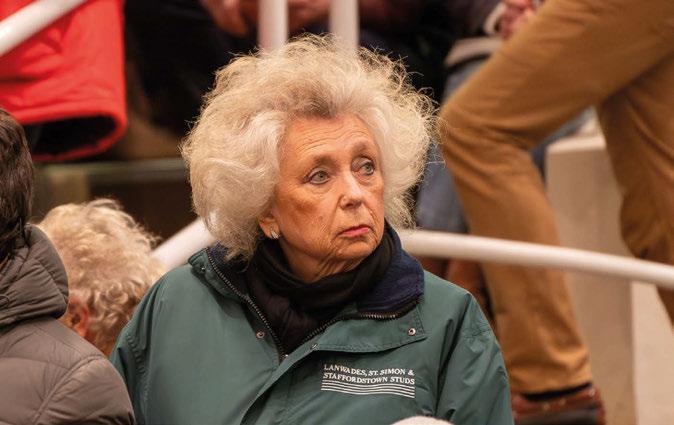
conjunction with our sister organisations, such as the EFTBA, recognising that the more we present a united front, the stronger our voice will be.”
The Thoroughbred industry has long resisted the use of artificial insemination (AI) due to a myriad of reasons. However, to those looking in on the business, it could well be viewed as an answer to the question of transporting mares for natural cover, especially as it is already utilised within the sports horse world.
Indeed, there is a line within a EU Parliamentary briefing document stating that a plan should be made to create a fund to facilitate the transition from transport for natural mating of breeding stock and replace it with transfer of semen and embryos.
“That line is extremely alarming,” says Rausing. “The EU itself, some functionaries within the EU and some representatives of other equestrian disciplines are suggesting that ‘we could solve all this with AI’. The problem is not that easily solved.
“AI is banned in the Thoroughbred industry worldwide – it’s a worldwide matter, not just in Europe. You cannot make any singular rules for AI; such rules also apply to all other artificial reproductive means such as embryo transfer, sexing of sperm, genetic manipulation of various kinds and other forms of artificial reproductive methods not yet identified. It opens the door for all kinds of issues.”
Leadon adds: “It would have very serious consequences in an industry with a declining stallion base, potentially increasing inbreeding.”
The EU has 27 member states and it has to be remembered that few of them
entertain an interest in racehorse breeding. For some, it could even constitute something of a ‘rich man’s club’.
Speaking at last month’s ITBA Breeding Preparation Seminar, Leadon described the issue as “a very real and imminent threat with a narrow window of opportunity”. But there remains hope that it will be resolved.
“It’s a real and imminent threat with a narrow window of opportunity”
“The horse is but a small part of the bigger picture, and it is only through concerted lobbying that our voice will be heard in the cacophony of calls for changes,” says Khan. “But we must be optimistic. We have a good case: the current proposals would in fact be to the detriment of our horses’ welfare; they are illogical in that they are discriminatory against a well-regulated sub-population of horses which travel in identical conditions to the racehorses which have been given derogations.
“Undoubtedly, there will be occasional examples of breeding stock being travelled inappropriately – the answer is in enforcement of the law, rather than in creating new laws whose negative impact, both in welfare terms and economically, would be disastrous and completely disproportionate.”



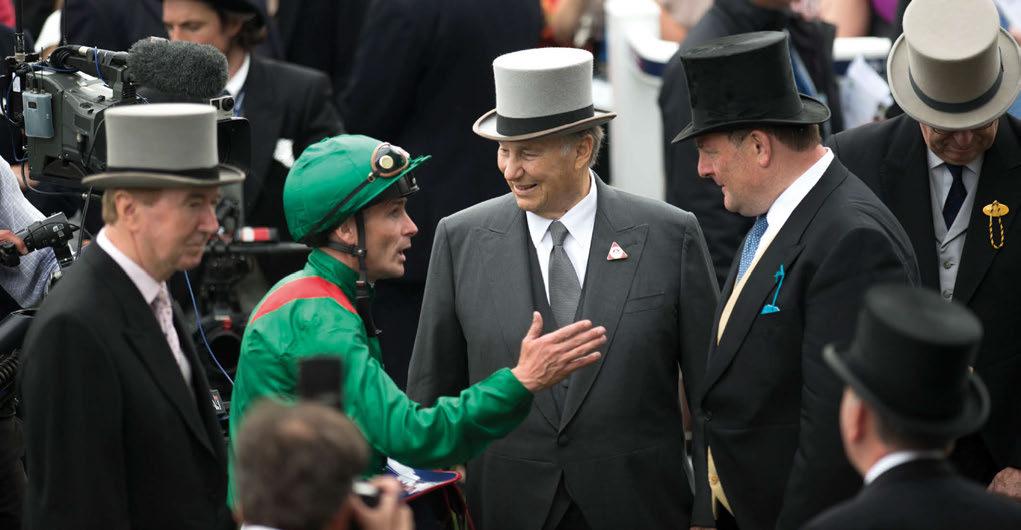
As the sport mourned the death of HH Aga Khan IV last month, those who worked under him might have taken some solace in the arrival of an important new foal, a filly out of his last Irish Classic winner Tahiyra. There will be expectations attached to the Justify youngster, not just on the track but in her potential role as a conduit of the Tremogia female line that was added with the acquisition of the Francois Dupre stock during the late 1970s.
As such, the wheel keeps turning. No one would have been more conscious of that than the Aga Khan himself. Upon the unexpected death of his father Prince Aly Khan in May 1960, he was faced with the decision as to whether to maintain the family’s racing stable or wind it down. It had been established four decades before by his grandfather, and with immediate success to the extent that the third Aga Khan passed away having amassed no fewer than 13 champion owner titles.
Luckily for racing, the new Aga Khan chose to keep the enterprise going, immersed himself in its intricacies and in return came to preside over one of
the sport’s most successful operations.
“When you look back at what His Highness achieved and the good horses he bred, I think it’s quite outstanding,” says Pat Downes, the long-serving manager of the operation’s Irish studs. “He said himself growing up that he had very little exposure to bloodstock, so the activity never really came on his radar. And when his father died, he did take time to think whether he could continue on.
“It’s typical of the man that when he made the decision, he very quickly brought himself up to speed, helped by working with some very good people.”
Downes and Georges Rimaud, who was director of the French division for 25 years prior to his retirement last November, were key members of the loyal and tight-knit team that served the stud during the later decades of the Aga Khan’s tenure. Between them, they helped oversee the development of Sea The Stars, Siyouni and Zarak into leading sires and the management of a broodmare band whose power has been showcased to such great effect over the past three seasons by the Classic winners Vadeni, Ezeliya,
Rouhiya and Tahiyra.
The benchmark of excellence, however, remains Zarkava, whose unbeaten career with Alain de RoyerDupre took in wins in the Arc, Prix de Diane, Poule d’Essai des Pouliches, Prix Vermeille and Prix Marcel Boussac. And now as the dam of Zarak, she’s starting to become a major presence across the breed as a whole.
“I do think that particular story sums up the Aga Khan operation perfectly,” says Downes. “Zarkava can be traced all the way back to Mumtaz Mahal, purchased by his grandfather HH Aga Khan III, and there was Petite Etoile in between – that really is exactly what we’re about. Every good horse gave him immense pleasure but I’ve no doubt that the Zarkava story gave him a little bit more satisfaction, especially given the fact that it was so strongly linked with what his grandfather started.”
Zarkava is probably best remembered for her bloodless victory in the 2008 Arc but her brilliance and quirks were encapsulated by the Prix Vermeille, in which she gave up several lengths at the start only to cut down
her rivals and win going away. Multiple Group 1 winner Dar Re Mi was made to look pedestrian in second. A year before in the Prix Marcel Boussac, she had jumped a shadow just after the post, a sure sign of a horse with enough in reserve to toy with her rivals.
“Zarkava was amazing, an incredible filly,” says Downes. “I still think about seeing her growing and developing at Sheshoon Stud, and wishing I could see what it was about with her – and I absolutely saw nothing other than she was a neat racy filly who was not the most correct.
“She was a bit quirky. She got left in the Prix Vermeille – she really did light a Hamlet cigar that day – and then in the Arc, Christophe Soumillon almost went out the side door because she ducked towards the rail coming out of the stalls.
“But my goodness what a talented filly and we’re very fortunate that she’s produced a lot of daughters for us to keep working with. And of course Zarak is now looking like he’s an important stallion. He’s such a beautifully bred horse that you’d hope he would become a strong influence, and that’s what we’re seeing at the moment.”
Similarly, Dalakhani is a horse who ranks highly in the stud’s pantheon of greats. Winner of the Prix du Jockey Club and Arc, he was only beaten once when turned over by fellow Aga Khan colt Alamshar in the Irish Derby.
“Dalakhani came in Darshaan’s last crop and I think that made it particularly special for everyone,” says Downes. “It was a big couple of days for His Highness when he won the Prix du Jockey Club and Arc. We thought he might have gone through his career unbeaten but we managed to beat him with another of ours in the Irish Derby! Alamshar had run a very good race at Epsom [when third in the Derby] and His Highness said beforehand that the Curragh is John Oxx’s local track and the Derby is a very important race. He was not going to say ‘we have another colt for that race’ and not to run.
“The result might still have surprised him but we can all live with surprises like that. Alamshar got a very canny ride from Johnny Murtagh, who knew the Curragh very well, and of course he went on to win the King George. He was a very good colt on his day.”
Dalakhani and Alamshar represented different threads of the operation, Dalakhani being a blend of two Boussac-line horses in Darshaan and Daltawa and Alamshar, the
best sired by Key Of Luck, another celebrated member of the Mumtaz Mahal clan. Such fusions of various lines, mainly stemming from the old Aga Khan families and those incorporated through the acquisitions of the Boussac, Dupre, Holliday and Lagardere stock, have long been the bedrock of the stud’s success.
“He really did enjoy it,” says Downes. “He loved talking about the different families and loved the navigation of the mating process every year. We were very fortunate to have him guiding us. He was certainly a great help to myself and Georges, and to Zahra. He had an
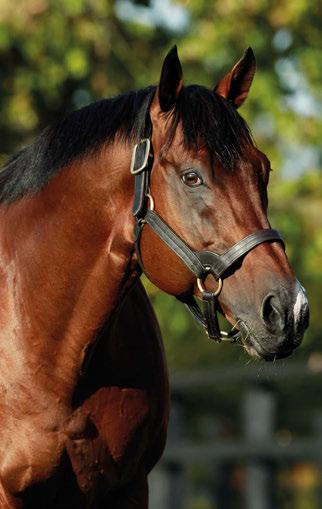
amazing recall as to the families and where they came from.
“I remember one day that we were stuck with one particular mare on whether to sell her or not. We spent a morning in Aiglemont discussing it, this one mare. We had to go racing at Longchamp and ran out of time, but when we left the races, we went across the road to ‘Le Yearling’ for a coffee with His Highness and we took it up again, this one mare. We certainly can take our time with decisions and I remember we all found it entertaining that this one mare took up a whole day.
“He said to us, as a guide, to protect the broodmares at all costs. We try to do that but it’s also a fine line as we can’t let it get too big. Everyone can see that we sell a lot of mares every year and that’s driven by the numbers. It’s quite an aggressive policy and it
Nancy Sexton Bloodstock Editor
does lead to the stud sometimes selling some females that weren’t the pick when we went through them in rounds one or two. But if we say we must get to a number – we’re pretty comfortable at 160 – then there can be a bit of pain involved in getting to that. Having said that, it’s also a great opportunity for people to get into these families.”
The Aga Khan Studs rose to one of its numerical peaks with the acquisition of the Lagardere horses in 2005.
Lagardere had bred numerous good horses in the preceding years, many of them by his own sire Linamix, and the stock has since proven to be just as productive for the Aga Khan, providing him with a French champion sire in Siyouni and Classic winners such as Vadeni, Sarafina and Valyra.
“The Lagardere stock have been tremendous,” says Downes. “We cut out quite a bit quickly from it, which we felt we needed to do, but it’s worked out well.”
He adds: “Siyouni was a little bit of a departure for us in that he wasn’t quite what you’d call a typical Aga Khan horse to retire to stud – he’d obviously won his Group 1 as a two-year-old but hadn’t won at three. We had an interesting discussion with His Highness when we put that one on the table, and to be fair to him, he said ‘let’s give it a go’. And it’s worked out very well for us and for a lot of other people.”
Amid the current sadness there is at least the promise that 2025 could well bring more Group 1 rewards. King Edward VII Stakes winner Calandagan, who was recently named the ITBA’S three-year-old male of 2024, remains in training with Francis-Henri Graffard at Aiglemont, which also houses the exciting juvenile filly Zarigana, fittingly a granddaughter of Zarkava, and Longchamp debut winner Azimpour. In Ireland, the Dermot Weld-trained Hazdann created a good impression when winning his maiden at the Curragh last summer and is on course to be tried at a higher level.
“We were all very clear on what His Highness wanted to achieve,” says Downes. “You’ll have days that work and some days that don’t, but we all have a very clear picture of where we want to go with it. We were very fortunate to have had some very good days with him, and from a personal point of view, I was extremely fortunate to have had so many years working for him.
“He was a great man and he has left a wonderful legacy.”
Evans
Visitors to this well-established mixed sale were entertained by the smallest catalogue since 2015, but with the embellishment of some celebrity racehorses.
The annual stallion parade has become a regular feature, but this year it was joined by a gala of retrained racehorses. Rarely can a sales ring have witnessed two Gold Cup winners, but on this occasion the stallion Stradivarius, winner of the Ascot version, was joined by the retrained gelding Native River, who won gold at Cheltenham.
Two sessions later and the business of selling horses had been as popular as the parades, with rises in all the key columns. Sixteen fewer lots walked the ring yet 19 more horses were sold, lifting the clearance rate to 85 per cent, a rise of 12 points. Turnover of just under 4 million guineas was up 38 per cent, the average of 18,034gns was an increase of 26 per cent while the median climbed 52 per cent to 11,000gns.
A significant factor in these improved results was Italian bloodstock agent Alessandro Marconi, who arrived in Newmarket with Middle Eastern clients’ money in his pocket and a long list of purchases in mind. He nailed 29
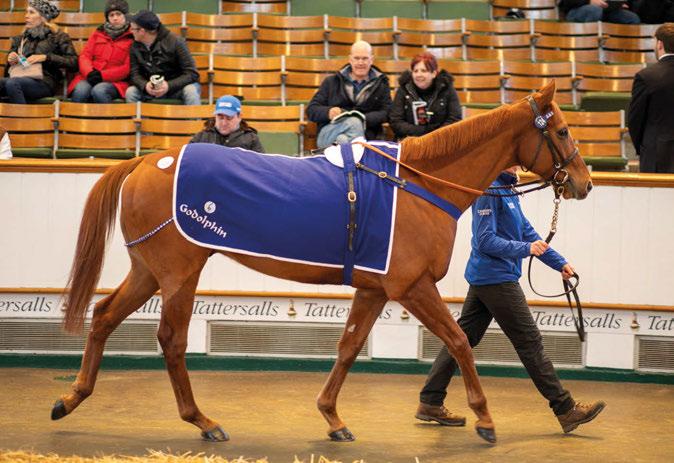
of them, adding 833,500gns to the sale’s turnover, the equivalent of 21 per cent.
Marconi is no stranger to big-race success, a highlight from last year being the Poule d’Essai des Poulains victory of Metropolitan who he bought as a yearling on behalf of Italian owner Scuderia Scolari.
For his latest auction ring encounter

Marconi was acting for Libyan interests who he said were expanding in Europe and the Middle East.
Dipping into the fertile hunting ground that is Godolphin – an operation whose draft accounted for 55 per cent of the first day’s turnover – Marconi bought three-year-old fillies Scarlet Princess for 130,000gns and Helen Keller for 90,000gns.
He also raided the Juddmonte consignment and gained the colt Modernise for 90,000gns, while on day two his 100,000gns bid lifted the
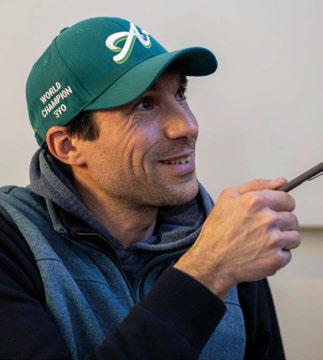
session’s top lot in the shape of Baridi, a three-year-old colt who had won a mile maiden at Lingfield for Stuart Williams’ yard.
Summarising his reason for targeting the February Sale, Marconi said: “I do believe this is the only sale that is able to give you an entry at an affordable level to every side of the industry.”
The sale-topper also emerged from Godolphin in the form of the Andre Fabre-trained Galashiels, who was knocked down to agent Colm Sharkey for 220,000gns. A six-year-old gelding who has raced exclusively on the Flat and makes that kind of money is only
Galashiels 5 g Australia - Glenmayne
3
Baridi 3 c Sergei Prokofiev - Secret Hint
Modernise 3 c Frankel - Modern Look
Helen Keller 3 f Night Of Thunder - Discourse
This two-day sale opened on a note of quiet reflection 24 hours after HH The Aga Khan, a legend of racing and breeding and a major shareholder in Goffs, had died.
It ended on a worrying note as news filtered in that racing had been abandoned at Thurles due to a shortage of medical cover following an injury to jockey Michael O’Sullivan. The unthinkable grew in probability over the coming days until the sad news of his death at the age of 24 was released. Every racing fan in Ireland, and far wider afield, will have felt the shock.
Despite the loss of two men at different ends of their involvement in the world of horseracing – and the vacuum they leave and which their families must handle – the sport and industry rolls on. No one can imagine the Aga Khan or Michael O’Sullivan would want anything else.
Goffs Group CEO Heny Beeby referred to both men in his end of sale statement, saying: “Whilst the business of the day can be all consuming, we have been at least partly distracted by events at Thurles this afternoon.
Michael O’Sullivan is a friend to many of the team here and he is in our prayers.
“Finally, we repeat our sincere condolences to the family of His Highness The Aga Khan who will be
heading to one racing jurisdiction, and sure enough Sharkey was operating for Melbourne’s Ciaron Maher. With two Listed-race victories over 12 furlongs, Galashiels has the profile to run well in Australia, and the fact that his 12 turf races (plus two on Chantilly’s allweather track) had all taken place on ground with the words ‘soft’ or ‘heavy’ somewhere in the title was not offputting to the shrewd Maher.
Galashiels apart, trade at the top end was dominated by young horses.
Twelve months earlier the mare Taaqareed had headed trade at 200,000gns when selling to
Childwickbury Stud, but on this occasion the most valuable breeder proved to be seven-year-old Publicist, a daughter of Dark Angel with a Modern Games cover and a valuation of 52,000gns. Consigned by Houghton Bloodstock, she was sold to Wiltshire’s Norman Court Stud.
Statistics
Sold: 220 (73% clearance)
Aggregate: 3,949,500gns (+38%)
Average: 18,034gns (+26%)
Median: 11,000gns (+51%)
Alessandro Marconi
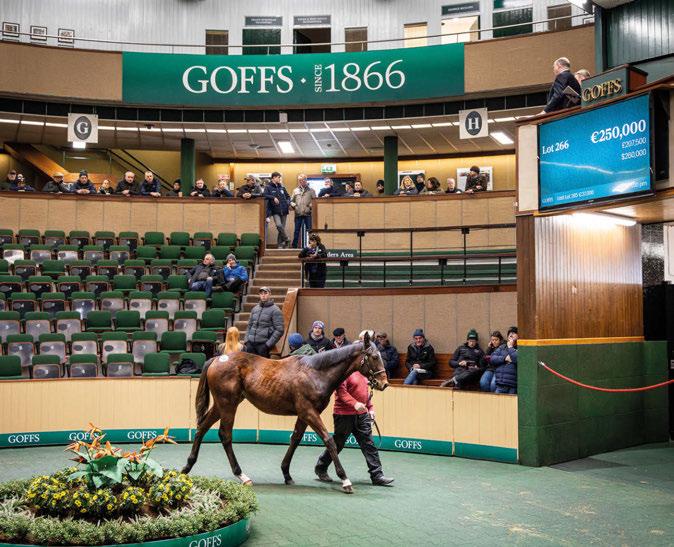
mourned by so many, not least by all of us at Goffs. Not only was he our largest shareholder for many years, but he was also a source of much sage advice, wholehearted support and enormous encouragement to us, especially in tougher times when his personal
backing was so vital to the company.”
Seven horses set to be offered by Aga Khan Studs at this sale were withdrawn and offered in a Goffs online sale one week later where they achieved a 100 per cent clearance rate, added €338,500 to the company’s
annual turnover, and were headed by a top price of €150,000 for the onceraced Kingman three-year-old filly Sulaiyma from the Sinndar family. The O’Callaghan family of Tally-Ho Stud made the successful bid.
Trade at the live auction a week earlier ended with plus signs against the columns of note including an improved clearance rate, which gained two points at 67 per cent. Fifty fewer lots were offered, yet turnover rose 25 per cent to just over €3.8m, the average shot up 40 per cent at €18,026 and there was another 25 per cent gain in the median which concluded on a mark of €10,000, figures similar to those achieved in Newmarket the previous week.
Young Flat-bred yearlings proved the key draw in Ireland, and another giant entity within the bloodstock world made headlines when selling the top two lots.
Eva Maria Bucher-Haefner’s Moyglare Stud Farm in County Kildare gained €250,000 for a Blue Point colt and €165,000 for a son of Study Of Man. The Blue Point was sold to the Tally-Ho Stud team of Tony and Roger O’Callaghan, while the Study Of Man was bought by agent Matt Coleman on behalf of a client in England.
Fiona Craig of Moyglare Stud Farm said the colts had been “too loose” and “not quite big enough” to sell as foals in November, but was glad they had been given time and “stood out” at this auction.
Lanwades Stud’s Study Of Man emerged last year as a young sire to note and has a growing army of fans – his oldest crop are now four-year-olds – while another new boy on the block, Space Blues, has gained good reviews before his first offspring reach the track. The clincher for the nine-year-old Kildangan Stud sire is about to unfurl when his first two-year-olds appear, but ebullient racehorse owner Clive Washbourn was in no mood to wait and see how they fare and when one of the sire’s yearling daughters came to market, he was ready with a €150,000

• The Saint Des Saints mare Sainte Baronne appeared twice in recent Goffs’ catalogues following the exchange of two of her offspring.
Nothing particularly unusual about that, with her five-year-old Johnny’s Jury – a gelded son of Jukebox Jury – changing hands in January for £75,000 at Doncaster having finished third in a maiden hurdle at Ffos Las, while her yearling colt by Space Blues realised €60,000 at Goffs’ Ireland HQ.
Even a layman could see those are quite different stallions to cover a mare, with Jukebox Jury being a jump stallion and a tough stayer who won the Irish St Leger, while Space Blues was a Breeders’ Cup winner who excelled at six furlongs to a mile. He is very much being geared at Flat-bred mares and there is every reason to hope he will have success with his first two-year-olds this year.
So what was he doing covering Sainte Baronne, who is also the dam of topclass hurdler Appreciate It and the useful chaser Danny Kirwan?
Vanessa Teehan-Rouzier of Charel Park Stud explained the unusual mating with Space Blues by saying a member of the syndicate which owns 21-year-old Sainte Baronne is a pedigree buff who believed in the choice. He had come up trumps with the matings which produced Appreciate It and Danny Kirwan, and the syndicate clearly have faith in his opinion for they then doubled their risk/ reward strategy by sending the mare back to Space Blues for a second cover and an expected foal this spring.
Whatever the outcome, the syndicate have given those of us who love a quirky mating another choice example to follow – be it on the Flat or over jumps.

On behalf of ‘The Investors’, Matt Coleman signed at €165,000 for a Study Of Man colt
Opening the batting for European bloodstock auctions in 2025, this sale proved akin to a Geoff Boycott innings rather than an exciting thrash from current England captain Ben Stokes.
Big hits were few, and the one that counted could not be included in a set of figures which showed reductions across the board. Of 170 offered lots, 97 found a buyer at a clearance rate of 57 per cent, four points down on the previous year, while turnover ducked below £1 million for the first time since 2013. The average price of £9,739 was down a third while the median lost 43 per cent at £4,000.
Goffs UK was a little unfortunate to miss the million turnover, for the sale’s top lot, seven-year-old novice chaser Peaky Boy, changed hands for a six-figure sum which would have carried turnover into seven-figure territory. Consigned by Nicky Henderson’s stable for owner Oli Harris, Peaky Boy was led out unsold when bidding halted in the ring at £195,000, although a private sale was subsequently achieved when trainers Jonjo and AJ O’Neill secured the son of
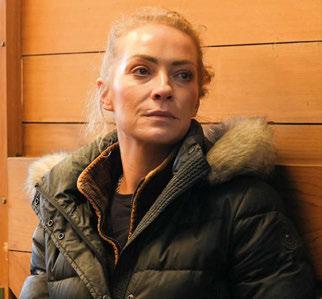
bid that sealed the deal.
John Hyland of Oghill House Stud was at the ring to handle the transaction and then transport the filly back to his County Kildare pastures for the next stage of her career. The result was another windfall for Derek and Diana Iceton’s Tara Stud, which was put on the market in September following its owners’ decision to downsize the agricultural side of their business.
Selling the 595-acre Tara site will leave the Icetons with 350 acres on which to continue in bloodstock, probably under the name of Skryne Castle.
A Ballybin Stud-offered yearling colt
by Churchill made €92,000 to a bid from Ballyphilip Stud’s Paul McCartan, who headed interest from Glenvale Stud’s Flash Conroy, but the last-named had earlier signed for a €90,000 son of Camelot put through the ring by The Castlebridge Consignment on behalf of breeder RJB Bloodstock Ltd.
Sold: 214 (67% clearance)
Aggregate: €3,857,500 (+25%)
Average: €18,026 (+40%)
Median: €10,000 (+25%)

Kayf Tara for an undisclosed sum on behalf of their Gloucestershire yard’s sponsor, Martin Tedham and Wasdell Properties.
Private sales are usually included in a bloodstock auction’s figures and the agreed sum displayed, but on this occasion the buyers wished to keep the figure a secret while giving permission to Goffs UK Managing Director Tim Kent to reveal it was north of £100,000. Little more than three weeks after changing hands, Peaky Boy made his first start for the O’Neills in Ascot’s Grade 2 Reynoldstown Novices’ Chase, but came home a distant last of three finishers.
Conversely, another horse in the catalogue who changed hands privately, Kelijoe, a winning four-yearold hurdler from the French stable of owner Nicolas Paysan, was unsold at £48,000, but his private sale for
£42,000 was identified and included in the day’s figures.
Sales at Doncaster have benefited from some juicy dispersals over the years, and while this year’s January catalogue was short of a major clearout, it did benefit from a nine-lot draft from Paul and Ellmarie Holden’s Coolmeen Farms operation, plus an immaculately presented group of four horses from Henderson’s Seven Barrows yard offered on behalf of Harris.
The Coolmeen collective involved nine horses of which seven sold for receipts totalling £231,000. Johnny’s Jury, a four-year-old son of rising sire Jukebox Jury, proved the most valuable and he ‘headed’ trade when knocked down to Tom Malone on behalf of trainer Jamie Snowden.
Other than Peaky Boy the pick on price of Henderson’s quartet was
››
six-year-old Break My Soul who joined the stable of County Meath-based Ian Donoghue, a name to note having gained a full licence just two years ago. Donoghue’s Donny purchase made a very promising start for her new connections when in mid-February she finished a close second to the exciting Kitzbuhel in the Grade 3 Red Mills Trial Hurdle at Gowran Park.
The 11-year-old mare Misty Whisky proved the sales most valuable breeder when selling – with a Golden Horn foal in utero – to Ashfield Stud’s Denis Cusack for £60,000, while the toppriced young yearling proved to be Cobhall Court Stud’s Kapgarde colt, who was sold to agent Jerry McGrath for £30,000. Within a week it was announced that Haras de la Hetraie had retired Kapgarde at the age of 26, but his tremendous legacy contains plenty of active ammunition, not least in the shape of his Champion or Mares’ Hurdle fancy Brighterdaysahead.
Statistics
Sold: 97 (57% clearance)
Aggregate: £944,600 (-20%)
Average: £9,739 (-33%)
Median: £4,000 (-43%)

There will have been little profit for breeder Scarlett Knipe in the sale of the old stallion’s yearling, but at least he was one of the 49 horses of his age group who found a buyer – another 31 failed to do so, and Kent sympathised with their vendors in his closing statement.
He said: “While we were hopeful of
sustained demand for this category, there is no denying that trade was selective and it was tough for some breeders. While we can all celebrate the high prices, we recognise the challenging nature of the National Hunt market away from the headlines and how tough it can be if you don’t have exactly what the market wants.”
January Sale
After a subdued edition in 2024, trade at this auction, held after racing on Festival Trials Day at Cheltenham, showed something like the form we have come to expect at the venue.
The figures did not quite surf alongside those achieved in 2022 and 2023, but a 90 per cent rise in turnover to just over £1.6m, a 27 per cent improvement in the average price to £69,458 and a doubling in the median value to £62,500 were figures that will have been welcomed by Tattersalls and the loyal vendors – the majority from across the Irish Sea – who enter horses at the home of jump racing.
The results tend to confirm the
theory that 12 months’ ago trade was impacted by a one-off sale held at Tattersalls Ireland nine days later and involving a dispersal of quality horses owned by Andy and Gemma Brown.
One year later, the number of offered lots at this auction had grown from 22 to 30 from which three Irish point-topointers generated six-figure sums. They were headed by Starzand, a €21,000 store purchase by Wexford’s James Doyle at the 2023 Tattersalls Ireland Derby Sale, but whose value was bound to soar following an impressive win at Dromahane in County Cork in late December.
The five-year-old’s new home is near Minehead in Somerset following a £230,000 bid by former champion
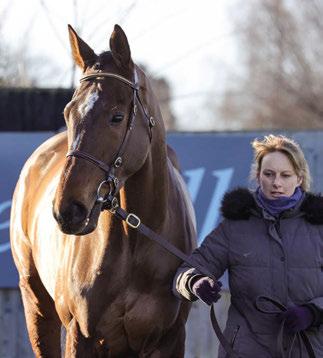

jockey Richard Johnson, who was acting for the combination of owner Dave Lewis – whose horses run in the name of Gwent Holdings – and trainers Philip Hobbs and Johnson White. Tom Malone rarely leaves a Cheltenham sale without buying a horse, and he duly put his signature to five-year-old Kilwaughter, a son of Milan consigned by Stuart Crawford having won a Down Royal bumper on Boxing Day. Led from the ring unsold at £145,000, Kilwaughter was the subject of a private sale to Malone for
• Despite the challenges of becoming an established racehorse trainer there is no shortage of eager young talents willing to try their luck.
County Limerick’s Colm Ryan joined their number and leapt several rungs up the ladder when his second runner with a trainer’s licence, Karate Kid, won a bumper during the important Leopardstown Christmas meeting. Horses trained by Gordon Elliott and Willie Mullins finished behind, and the winner was sold on at Tattersalls Cheltenham’s January Sale for £100,000.
Given that Ryan also bought Karate Kid as a store, it would be no surprise if owners pricked up their ears and marked him out as a man who could both source and train horses for them in future. Yet Ryan is keen to stay well away from the training spotlight. In a Racing Post interview with James Thomas, he revealed: “With regard to training horses publicly, say training 30 or 40 handicappers, that’s not something I’m interested in as there’s no money in it.”
Ryan’s aim with a licence is to use it to train young horses with a view to selling them on, as he did for owner John Hayes when trading Karate Kid. Given the well-documented omnipotence of a handful of Irish trainers, selling them horses, rather than running against them, seems a smart move.
£120,000, while another bumper winner, Karate Kid, was sold out of Colm Ryan’s stable to Tessa Greatrex on behalf of Jim and Claire Bryce for £100,000.
Karate Kid, a £13,000 purchase 18 months earlier at Goffs UK’s Spring Sale, had become Ryan’s first winner with a licence when scoring at
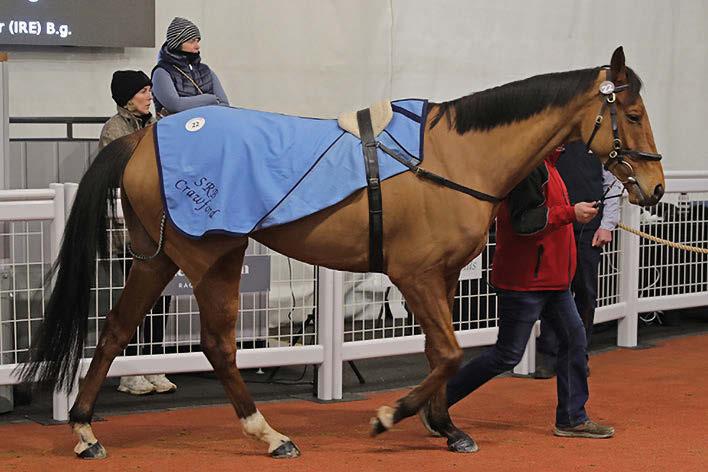
Kilwaughter: debut Down Royal bumper winner was originally led out unsold at £145,000
Tattersalls Cheltenham January Sale
Leopardstown’s Christmas meeting. Horses offered by British vendors proved disappointingly and curiously hard to sell, with a couple of exceptions.
Top amateur rider Gina Andrews consigned five-year-old Panjandrum –who her brother Jack had ridden to victory at a meeting in Worcestershire in late December – and saw him sell to Gordon Elliott for £95,000.
Panjandrum, a son of the talented racemare Mickie, was offered on behalf of his breeders, Anthea Gibson-Fleming and Selwood Bloodstock’s James Read. There was also a good result for the stable of Ewan Whillans, which consigned Newcastle bumper winner Bespoke Tailor. Bought 18 months earlier for just €6,000 as a store at Tattersalls Ireland’s July Sale, he reaped a sum of £90,000 when reoffered and knocked down to agent Marcus Collie and trainer Oliver Signy.
Statistics
Sold: 24 (80% clearance)
Aggregate: £1,667,000 (+90%)
Average: £69,458 (+27%)
Median: £62,500 (+102%)
With a new title and the injection of some Flat-bred stock, this sale opened another year of trading at Tattersalls Ireland’s County Meath headquarters.
Rebranding the event and calling it ‘the Winter Sale’ was a smart move that gives it a clear identity from auctions named after the month in which they take place, but in most cases trade follows trends, and the name change could not alter the reality that the current market for young jumping horses and breeding stock is lukewarm.
As a result, trade at this one-day auction involving 160 offered horses produced minor falls in the average


price and clearance rate, while turnover dropped below €1m for the first time since 2013, albeit the catalogue was the smallest this millennium.
The average price fell five per cent to €10,630, the median price of €7,500 was up seven per cent, but a 53 per cent clearance rate was a disappointing outcome for vendors. The few Flat-bred horses made little impact or failed to sell.
When known as the February NH Sale, this auction had thrown up some very useful performers and that will be the hope again. Maybe a yearling son of Walk In The Park who headed trade at €50,000 will join his many paternal siblings who have proven high-class on the track – and being out of a half-sister
to Envoi Allen is in his favour. Consigned by The Beeches Stud, he was knocked down to Gerry Aherne, a man who buys more Walk In The Parks than most and who said his purchase could sell as a store or go straight into racing. Walk In The Park became the sale’s leading sire, his six representatives changing hands for an average of €30,833.
Anthony Cahill bought a Blue Bresil yearling out of a full-sister to Cheltenham Gold Cup winner Lord Windermere for €40,000, a figure which the buyer hopes to top when he resells at store stage, while Richard Rohan’s purchases included an Affinisea full-sister to five-year-old Hollygrove Cha Cha, who little more than two weeks later gave the page another lift when winning a Grade 2 mares’ hurdle at Sandown for the Jamie Snowden stable.
Sold: 84 (53% clearance)
€893,650 (-14%)
€10,639 (-5%) Median: €7,500 (+7%)
- Windermere Sky
F Affinisea - Hollygrove Rumba
C Walk In The Park - Pushkar
F Blue Bresil - Regal Empress
Arqana February Mixed Sale
Reduced in size to a one-day sale, this auction in Deauville contained the usual cornucopia of horses with which Arqana does so well.
Three lots sold for six-figure sums, the clearance rate gained five points at 82 per cent and there was a one per cent rise in the average price to just under €12,000. Turnover was down eight per cent at just
over €2.7m, but 28 fewer horses walked the ring, while the median was down eight per cent at €5,000.
Trade was headed by a yearling filly who sold for €110,000 to Nicolas de Chambure of Haras d’Etreham. He knew he would have little problem finding a European stallion to cover his purchase when that time comes for she is a daughter of Australia’s Extreme Choice
who stands at Newgate Stud Farm. As its website is proud to emphasise, Extreme Choice is only the second horse to sire winners of top two-year-old race the Golden Slipper (2021, Stay Inside) and the Melbourne Cup (2024, Knight’s Choice).
Six-year-old Caravaggio mare
Signorina Merisi, a stakes winner in the US, made €105,000 when selling to Francoise Beres of Haras de la Croix Sonnet, while

Philipp Stauffenberg’s €100,000 offer secured the four-year-old Starspangledbanner filly Fang Mich, a winning half-sister to sire Fantastic Moon. Stauffenberg needed no introduction to
Statistics
Sold: 230 (79% clearance)
€2,705,000 (-8%)
€11,962 (+1%)
€5,000 (-9%)
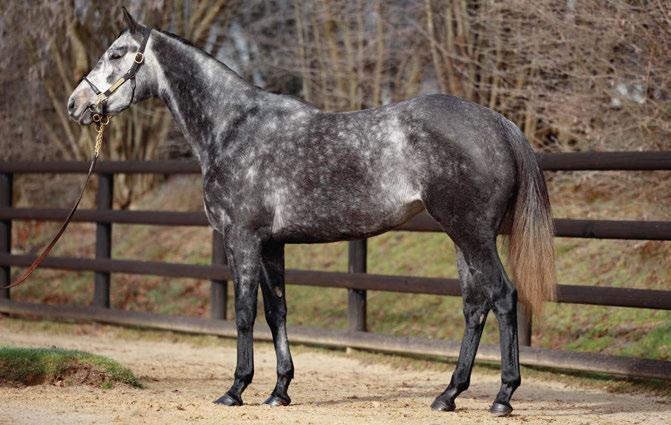
Fang Mich, for he bred her and was keen to regain her for his broodmare fold.
Best price for a colt was the €85,000 achieved by Sherkane, a four-year-old with a pair of recent wins at Pau in his form line over 2,400 metres. His next stop
will be in Libya, a country which has known more than its share of upheaval in the past 20 years, but which once again has a developing racing programme according to buyer Khaled Salami, who signed for a total of five horses.



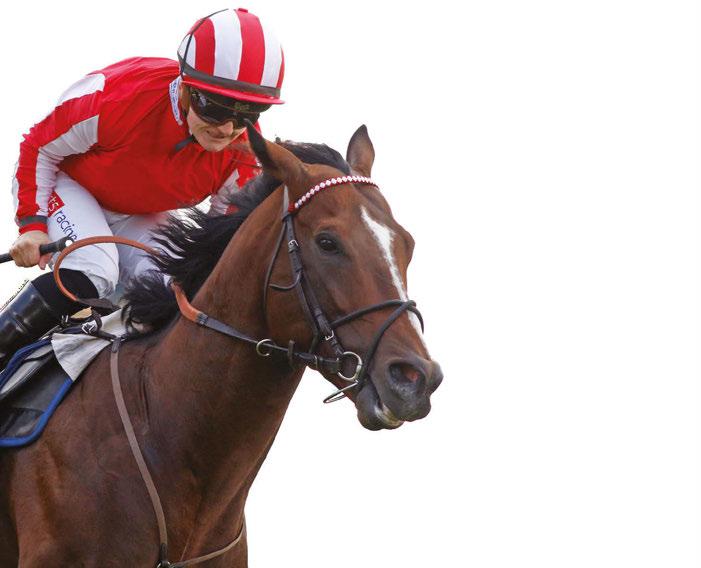
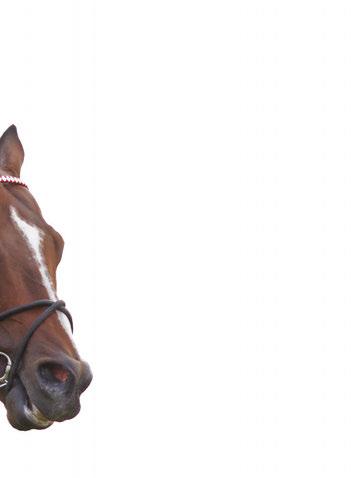
The yearling market was never more polarised than in 2024. The top ten per cent average rose by 28 per cent to £423,130, principally due to the aggressive investment by Kia Joorabchian and partners. But the bottom ten per cent average dipped by 25.5 per cent.
In between those two metrics the remaining eight ten per cent segments showed us how tough things really were for vendors. The second-top ten per cent segment improved by only two percentage points, and the remaining seven all posted falls to the tune of 2.9, 5.9, 8.3, 11.2, 14.4, 17.5 and 21.7 respectively.
Moreover, the proportion of yearlings making at least their advertised fee plus an upkeep charge of £20,000 fee fell to 39 per cent last year, the first time in four years that particular metric had dipped below 40 per cent.
Given all of the above facts, it is bewildering that stallion studs have been so bullish with their stallion fees in the past few years. Whilst it is true that many sires in the £30,000-plus range posted strong averages last year due to the record demand at the top of the market, only a combined 58 per cent of yearlings from this cohort actually made enough to cover their conception fee plus a hypothetical £20,000 in keep charges.
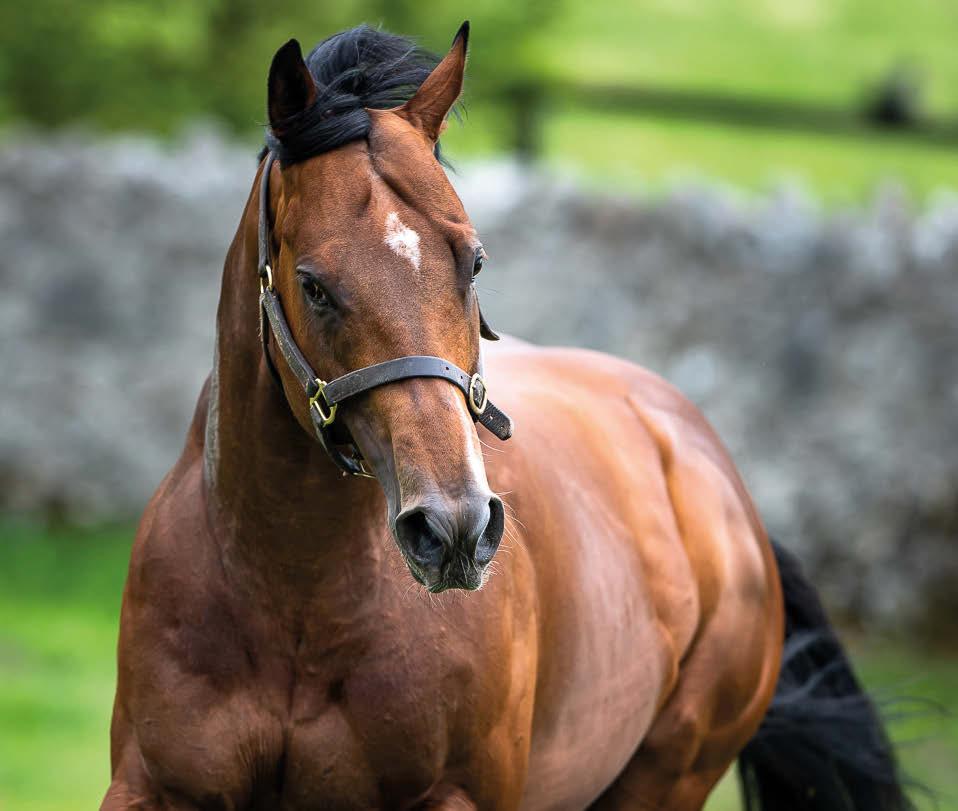
There are two factors at play here. One, while the number of 30k-plus stallions has not changed much over the past ten years – the number is actually down in recent years – their average fee has
increased. And two, the average book size has also increased over the same period. This means that significantly more money has been invested in this market sector in the past ten years.
In 2013, the sector attracted £162 million, while last year’s yearling crop were the result of a £304m investment, an increase of 88 per cent. The upshot is that we have a booming market for expensive nominations, but it is one that the yearling market increasingly struggles to keep pace with. As a matter of interest, the yearlings of 2025 are from a 30k-plus market that netted £367m, a further rise of 21 per cent, and next year’s come from a market size of £381m, which represents another four per cent increase.
From a stallion operation perspective, the annual mare returns are traditionally dominated by Coolmore and Darley, which stood 21 and 22 stallions and attracted 2,593 and 2,339 mares, giving them an average of 123 and 106 respectively. Although there is a gap between the pair, this has pretty much always existed, reflecting among other things the fact that most mares reside in Ireland. What is notable about these two large organisations is that there has been a reduction in the number of
employed over the years from highs of 34 for Darley and 31 for Coolmore back in 2017. Consequently, the average number of mares covered has increased for each outfit, the 123 per stallion at Coolmore in both 2023 and 2024 being its highest in the past ten years, while the 106 average for Darley has not been matched in the same period.
Behind the big two, Tally-Ho Stud’s seven stallions averaged 132 mares apiece, although that is down from 147 in 2023 and 159 in 2022 for the same number of stallions. After that we have the first two British farms with Whitsbury Manor Stud delivering its highest ever number of mares and highest average at 138 from its four stallions.
Unsurprisingly, in terms of quality mares per stallion, Juddmonte has always led the way. Its average of 68 elite mares – those that are stakes producers or stakes horses if they have no racing-age progeny – is understandably well clear of any other organisation with two or more stallions. This tally is also Juddmonte’s joint-best score since Frankel went to stud back in 2013. Ballylinch Stud, also with five stallions, is the next best by elite mares with 45, followed by the two big supermarkets of Coolmore (39) and Darley (35).
No prizes for guessing that Frankel’s 2024 book contained the highest number of elite mares at 146, 76 per cent of his total. The only other stallion scoring over 70 per cent elite mares was Dubawi on 74 whose book of mares was cut back to just over 100 last year.
Coolmore’s Wootton Bassett weighed in with a second-best 128 elite mares in his fourth year in Tipperary. This gives the son of Iffraaj an average of 134 from the last four sets of mares and we have already witnessed what the first Coolmore book accomplished last year as their two-year-olds featured a world record number of stakes winners, including four Group 1 scorers.
Only three more sires reached or passed the 100-mark. Lope De Vega’s tally of 108 elite mares is no surprise, while Gilltown Stud’s Sea The Stars covered 103. We could argue that the last of this group, Tally-Ho Stud’s Mehmas, was underpriced at €50,000 as he attracted 100 elite mares among his total of 241. This is the third consecutive year that he has passed the 100 mark, and he joins Dark Angel and No Nay Never as the only speed sires to top 100 elite mares in the past ten years.
Since 2013, only two first-season sires have topped 100 elite mares in their inaugural year – Frankel’s 101 in 2013
marginally ahead of St Mark’s Basilica’s 100 in 2022. None of the 2024 intake of new sires got anywhere close to these totals, the best being Frankel’s son Chaldean with 75, one more than
“Frankel’s 2024 book contained the highest number of elite mares at 146”
Tally-Ho’s Good Guess (74) who covered 241 mares in total – second only to his stud companion Starman’s first-season record of 259 mares two years earlier. Darley’s Native Trail (55 elite mares) and
Dullingham Park Stud’s Shaquille (50) also had productive first seasons as did several others, including Modern Games (44) and Little Big Bear (41).
The record for a second-season sire stands at 112 elite mares, covered by Frankel in 2014, and ten years on it is Baaeed who has headed that particular cohort in 2024 with 63 elite mares, followed by Blackbeard’s 37. Shadwell’s Baaeed also topped his class a year earlier with a debut book that featured 95 elite mares.
The nominations market is where it all begins, and it essentially decides the fate of many stallions. It is also the first opportunity to gauge how the yearling market might go two years later. Looking further ahead, an early metric from the £30,000-plus stallions at stud this year that will inevitably have a major say on how the yearling sales play out in 2027 is that the advertised average price of a nomination is £109,000, compared to the £91,000 of the group just reviewed.
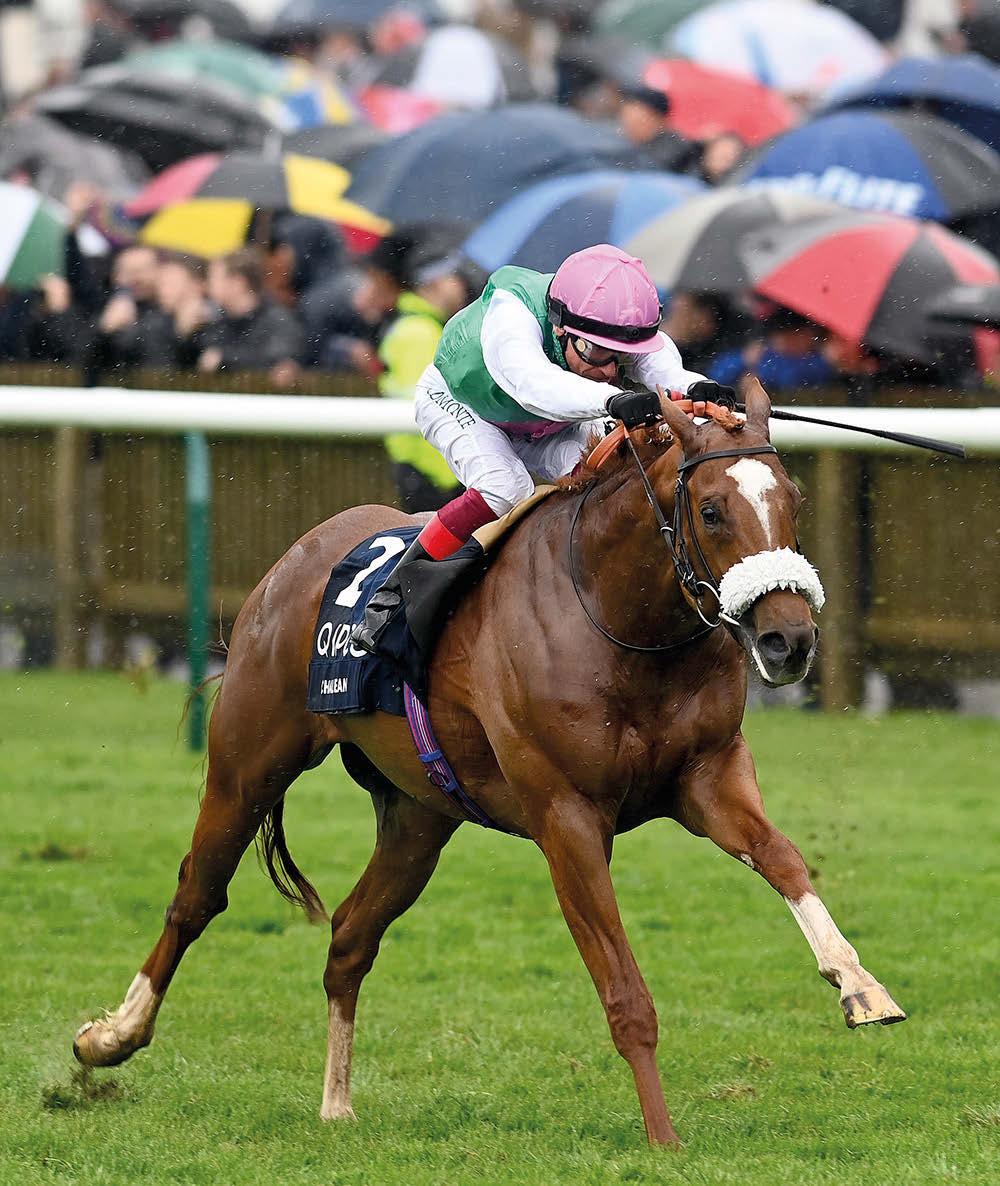
There was always the sense that the Aga Khan viewed himself as more of a custodian towards his bloodstock holdings. It hadn’t been the plan for him to inherit the stock developed by his grandfather HH Aga Khan III. That instead was to be the domain of his father Prince Aly Khan, whose flamboyant personality and understanding of the horse went hand in hand with the enjoyment of horseracing. Yet that of course all changed when Aly Khan was killed in a car crash in May 1960, leaving the stock in limbo.
Speaking in the Aga Khan Studs’ centenary film ‘A Game Of Chess With Nature’, the Aga Khan IV talks of that time as a 23-year-old, of having very little understanding of the inside workings of the sport and of the guidance from the people who helped fast-track his knowledge.
“Grandpa was very interested in pedigrees and what they could do to develop exceptional racehorses,” he explained. “He knew the pedigrees and he studied them. My father was not a pedigree man at all, he was a field man who was interested in how you developed a yearling to become a two-year-old and how you developed the two-year-old to optimise its racing career. So two totally different approaches.”
He went on to say: “I didn’t expect to be an owner. My father died three years after he became the owner so the whole operation was an accident in my life. When I came on board, I was a kid in a school. I was humble, I listened, I didn’t always understand. I found myself working with men and women who were my grandfather’s age and then they had a school kid turn up who hardly knew which end kicked. They were incredibly patient. It was a long learning curve.”
Trainer Francois Mathet, farm managers Major Cyril Hall and Robert Muller and bloodstock advisor Germaine Vuillier were among those whose insight was utilised during those early years. More recently, a tight-knit and longserving team has been at the helm of the operations in Ireland and France led by Pat Downes and Georges Rimaud. During that time, the ethos has remained the same, primarily the accumulation of

Mumtaz Mahal: still exerts a major influence over 100 years on from her birth
knowledge pertaining to the broodmare band. It is that factor which has allowed the studs to thrive and goes some way to explaining how it has produced several exceptional results with a number of lesser stallions.
The young Aga Khan came to rapidly understand the business and the intricacies of his grandfather’s bloodlines, many of them built on an initial outlay of 24,250gns by George Lambton on eight yearlings in 1922 that came to include the excellent fillies Cos, Teresina and Mumtaz Mahal as well as the dams of Classic winners Bahram, Theft and Dastur.
The flying grey filly Petite Etoile, a descendant of Mumtaz Mahal whose Classic career coincided with the death of Aly Khan, undoubtedly provided an early awareness into the power of those old lines.
However, as time came to pass, the Aga Khan also reinvigorated that stock with the introduction of outside families, notably those belonging to Marcel Boussac, Francois Dupre, Brook Holliday and Jean-Luc Lagardere. In every instance, the rewards were almost immediate and long-lasting. That point was underlined further last year by the stud’s Group 1 performers Ezeliya, Rouhiya and Calandagan, between them the descendants of old Boussac and
Lagardere families, and Group 2 heroine Hanaliya, another example of the productivity of the original Holliday line of Hazy Idea.
As for the stud’s successful young stallion Zarak, whose 2024 season yielded a first Classic winner in Metropolitan, he descends directly from Mumtaz Mahal via Zahra, the only filly produced by Petite Etoile.
There were 161 mares listed in the Aga Khan Studs Stud Book in 2024, the bulk of them from old Boussac families. Boussac’s horses carried all before them during much of the first half of the 20th century but the stock, plenty of it intensely inbred, became tired in later years and when the Aga Khan purchased it in its entirety from the bankrupt textile tycoon in the late 1970s, it required its share of culling as well as management.
The lines duly flourished, however. Included in the package was Licata, who was carrying the Arc heroine Akiyda, and Delsy, an Abdos member of the Tourzima family who foaled Darshaan not long afterwards. The Shirley Heights colt led home Sadler’s Wells and Rainbow Quest in a memorable renewal of the 1984 Prix du Jockey Club before becoming a sire of importance at Gilltown Stud in Ireland. Not long after, Delsy foaled the Top Ville filly Darara, the Prix Vermeille winner
whose line remains very relevant today thanks to Too Darn Hot, a son of her Group 1-winning daughter Dar Re Mi.
The line stemming from Stoyana also yielded the Derby and Arc hero Sinndar while that belonging to Listed winner Denia supplied Daltawa, whose sons Daylami and Dalakhani won the Poule d’Essai des Poulains and Prix du Jockey Club among 11 Group 1 races between them. Dalakhani, whose star-studded career closed with a victory in the 2003 Arc, later retired to take the place of his sire Darshaan at Gilltown, where a successful stud career included Classic winners Moonstone and Reliable Man.
Perhaps the greatest gift was Ebaziya. A fusion of two Boussac-influenced horses as a Darshaan descendant of Tourzima, Ebaziya foaled four Group 1 winners over a remarkable range of distances – the top two-year-old Edabiya, Irish Oaks heroine Ebadiyla and the Gold Cup winners Enzeli and Estimate.
Naturally, the Delsy, Daltawa, Ebaziya and Stoyana lines remain well represented within the operation as does that belonging to other important Boussac lines such as Darazina, the ancestress of Classic heroines Darjina and Daryaba, Eunomia, whose descendant Ervedya won the Poule d’Essai des Pouliches and is now the dam of young Aga Khan stallion Erevann, and Rilasa, whose line came to the fore again last year through another Poule d’Essai des Pouliches heroine Rouhiya.
Immediate Dupre rewards
The late 1970s was a period of major expansion. Alongside the Boussac horses, stock belonging to Francois
Dupre, a breeder who had enjoyed immense success with Francois Mathet at the same time as the Aga Khan, also joined the fold.
Lurking within the package was a yearling, Top Ville, who would go on to win the 1979 Prix du Jockey Club, while the mares included Val Divine, then carrying the 1981 Champion Stakes winner Vayrann.
Four years later, Mouktar, out of the Dupre mare Molitva, won the Prix du Jockey Club. It was an early illustration of
“The Lagardere horses have played a major role in the stud’s fortunes”
how various lines were beginning to blend, with Mouktar being a son of the Aga Khan’s Poule d’Essai des Poulains winner Nishapour, a son of Zeddaan inbred to Mumtaz Mahal. Similar was to unfold not long after in the 1987 Jockey Club winner Natroun, a grandson of Val Divine by the Boussac-influenced sire Akarad.
The Dupre stock also played its part in the Aga Khan’s record-breaking seven winners of the Prix de Diane, supplying two of them in Vereva and Sarafina. More recently it also sat behind the 2023 Irish 1,000 Guineas heroine Tahiyra.
A smaller group of mares added from
Brook Holliday’s Cleaboy Stud in the late 1980s yielded access to the Hazy Idea family and with it the line that would grant the Aga Khan with his 2016 Derby winner Harzand.
The final major ‘lock, stock and barrel’ purchase made during the late Aga Khan’s tenure was that belonging to Jean-Luc Lagardere in 2005. The acquisition added 222 horses, many of them greys possessing some kind of association to Lagardere’s lynchpin stallion Linamix, himself also part of the deal. Lagardere was an ‘out of the box’ thinker who single-handedly made Linamix into a French champion sire, often through mares sourced in North America.
The fruits of adding such an operation arrived quickly, notably during Arc weekend in 2009 when the green and red colours struck in five Group 1 races; three of them, Varenar (winner of the Prix de la Foret), Siyouni (Prix Jean-Luc Lagardere) and Rosanara (Prix Marcel Boussac) hailed from Lagardere stock.
The Lagardere horses have continued to play a major role in the stud’s fortunes since then, notably as the source of four Prix Saint-Alary winners in Sagawara, Siyarafina, Vazira and Vadawina as well as Prix de Diane heroine Valyra, champion stayer Vazirabad and Prix du Jockey Club and Eclipse Stakes victor Vadeni.
The other Group 1 winners from that golden Arc weekend of 2009, Alandi (Prix du Cadran) and Shalanaya (Prix de l’Opera), harked back to a different era as descendants of Mumtaz Mahal. It was a further illustration of the contribution made by that particular family

Shalanaya especially as a representative of the Sharmeen branch also responsible for Shergar.
It’s remarkable to think that those lines sourced over 100 years ago are still playing such a fundamental role. Mumtaz Mahal was part of that first collection of yearlings acquired in 1922 when bought for 9,100gns by George Lambton. Such was her speed, which carried the daughter of The Tetrarch to wins in the Queen Mary, Champagne and Nunthorpe Stakes, that she became a celebrity in her own right during her racing career. However, it’s the immense legacy that she left at stud for which she is now revered. One daughter, Mumtaz Begum, foaled Nasrullah. Another, Mah Mahal, became the third dam of Petite Etoile. At stud, Petite Etoile produced just three foals and only one filly, Zahra. Despite that slender thread, this branch of the line is today thriving, notably due to Zahra’s descendant Zarkava, the unbeaten Poule d’Essai des Pouliches, Prix de Diane and Arc heroine. The daughter of Zamindar was arguably the Aga Khan’s most important runner and is now becoming a major presence within the breed as the dam of Zarak.
Going back to those early Lambton purchases, 1924 Goodwood Cup winner Teresina (bought for 7,700gns) also became the ancestress of the Aga Khan’s champion miler Sendawar. And therein lies a snapshot of the power of these lines since Sendawar was by far the best son of the nondescript Priolo just as other Group 1 winners such as Alamshar, Daylami and Sarafina were among the best produced by Key Of Luck, Doyoun and Refuse To Bend.
There was the odd auction purchase, some of them important, led by Blushing Groom. Out of a mare, Runaway Bride, bred and sold by the Aga Khan, the Red God colt more than vindicated his 12,000gns foal price by becoming the French champion juvenile of 1976 and Poule d’Essai des Poulains winner of 1977.
Dumka, the 1974 Poule d’Essai des Pouliches winner, was added at the end of her Classic campaign at Tattersalls and went on to produce the 2,000 Guineas winner Doyoun, while Miss Medley foaled the 1984 Poule d’Essai des Pouliches winner Masarika in the years following her acquisition. The Sinndar filly Four Sins was a rare yearling purchase and went on to win the Blandford Stakes and run fourth in the Oaks; she was later sold to Japan. Such dips into the market followed that of Aly Khan, whose 770gns purchase
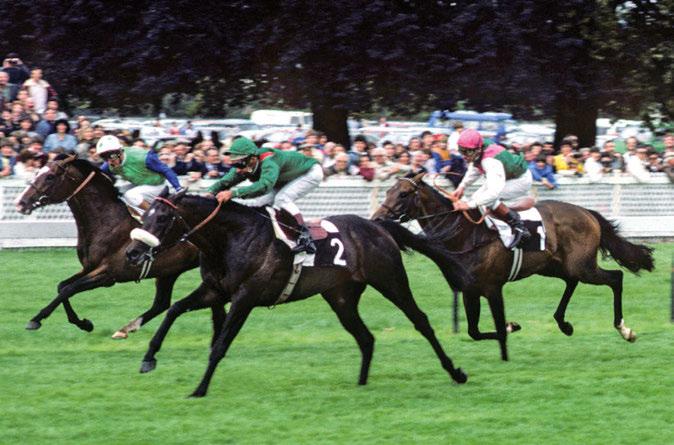
of Pale Ale as a 13-year-old mare in 1949 granted the operation access to a line that would later provide Derby winner Shahrastani.
Only 18 months ago, the Aga Khan Studs added three mares out of the Niarchos family’s reduction at Goffs. The trio, La Fiamma, Malicieuse and Raja Ampat, represent the Niarchos’s cornerstone families of Pasadoble and Coup De Folie and it will be interesting to see how they complement the existing bloodlines in their new home.
An awareness to capitalise on international bloodlines was also encapsulated by the stud’s partnership with Arrowfield Stud in Australia. That alliance granted access to various leading Australian stallions and in turn yielded multiple Group 1 winner The Autumn Sun, now a leading young stallion for Arrowfield. Similarly, Deep Impact and Heart’s Cry were utilised in Japan.
You get the sense that everything has long been done with an eye on maintaining the broodmare band to its high standard. Given the nature of the bloodstock cycle, culling is required on an annual basis to keep numbers in check. That can be to the advantage of others, though, with examples including Sean Coughlan, who picked up Kasora, subsequently the dam of High Chaparral, at Goffs in 1996, and Watership Down Stud, whose foundation mare Darara was purchased for Ir470,000gns in 1994. More recently, Leopoldo Fernandez Pujals bred Big Rock out of his Aga Khan purchase Hardiyna.
In turn, the stallion rosters have always been of a select nature. Not every good colt was retained – Blushing Groom and
Shahrastani headed to Kentucky, where Blushing Groom became a leading sire, and Alamshar was sold to Japan. Yet for a good proportion of the Aga Khan’s tenure, there was a sire of significance installed at either Gilltown Stud or Haras de Bonneval, whether it be Darshaan, Kalamoun or the current incumbents Sea The Stars, Siyouni and Zarak.
Today’s roster is enviably strong. Sea The Stars, campaigned by the Tsui family, and Siyouni are both well established among Europe’s elite and nor is the younger Zarak far behind, with a sixth place on last year’s leading French sires’ list achieved with crops bred off fees of €12,000. As it is, his 12 per cent stakes winners to runners marks him down as one of Europe’s leading lights. Again, there is a snapshot of that melting pot, Siyouni being a rapid reward for the Lagardere investment and Zarak the product of multiple generations of breeding from Mumtaz Mahal.
The Aga Khan says in the centenary film that he approached the project of maintaining his father’s stable with some trepidation, hopeful that it did not succumb to the danger of “going down the drain, slowly but surely”. Over 60 years on and the operation could arguably not be on a stronger footing, its success rooted in the ability of those within it to understand the animal amid the unpredictability of breeding.
“Nature always teaches you when you’re wrong,” he commented in the film. “You’re playing chess with nature. You move this way, nature takes you that way. That’s part of the fun of the activity, the unpredictability. But you try to understand it and work with it.”

THE ONLY R.EQUI-SPECIFIC

Words: Laura Steley
There is no definitive age when stallions and broodmares should retire from stud duties, or when signs of ageing will start to impact their lives. Age can be measured in various ways. Chronological age can often be misleading, much like with humans; some horses will show signs of ageing much sooner than others. This can be due to many factors, such as previous lifestyle/career, day-to-day management, environment, veterinary issues, and genetics.
Physiological age combines both clinical and biological markers to reflect age-related changes – as our understanding develops, this will become a more and more useful tool. Demographic age is defined as the point at which there is 25% survivorship at and above that specific age. A study from over two decades ago indicated the demographic age of horses in the UK (not solely thoroughbreds) was 15 years old (Mellor Et al. 1999), though this is likely to be higher now.
My research suggests that the typical thoroughbred life expectancy is around 25 years. The oldest living thoroughbred, in the USA at least, is thought to be a former racehorse called New Years Eve, at the grand age of 38! The proportion of aged horses, certainly in developed countries, has been increasing. This is partly due to improved veterinary care and nutrition as well as changes in human perception and expectation.
One thing the breeding and racing industry can feel proud of is its dedication and tenacity regarding the research and care which goes into sustaining our loyal friends throughout their lives. Often and understandably so, we tend to focus on how we can best care for our broodmares and stallions whilst performing their pivotal roles within stud farms. However, once these individuals are ready to pass the baton on to their younger counterparts and enter a more relaxed and humbler lifestyle, what should we be doing to keep them healthy and fulfilled for as long as possible?
John Rice, Head of the Stallion Division at Cheveley Park Stud, manages retired stallions Kyllachy (27) and Dutch Art (21) as well as current sires Ulysses and Vandeek. Rather impressively, John has looked after Kyllachy for 22 years, from the very start of his stud career in 2003 to when he retired from stallion duties in 2019 through to the present day. Rice explains: “Kyllachy is a very kind and intelligent horse. He is a good doer, so I do need to watch his weight.
“He goes out in the paddock every day, which is located directly across from his stable. I keep him well rugged to ensure he uses no excess energy trying to keep himself warm through the colder periods. Due to his
“The loss of muscle mass is related to a decline in physical activity”
temperament, he adjusted easily to his retired lifestyle. Although he isn’t covering mares anymore, I treat him just the same. He will come in every night all year round and have a full brush over in the afternoon. I was also lucky enough to have looked after Kyllachy’s highly influential sire Pivotal, right up until he died at the age of 28 in 2021.”
During my visit to the stallion unit at Cheveley Park Stud, I noted that the retired and active stallions are all kept in close proximity, with absolutely no issues arising during the covering season. This is testament to John’s natural horseman mentality but also possibly a sign that when a stallion reaches the end of his career, he is ready and accepting of it. Dutch Art and Kyllachy both carried optimal condition, with good muscle definition, and they were clearly very content.
Rice continues: “Dutch Art served his
last mares in 2023 and is taken care of just the same as Kyllachy. He goes out to the paddock after breakfast every morning and comes in every afternoon for a brush before being done up for the evening. Both receive ad-lib haylage and two high-fibre concentrate feeds a day.
“In my opinion, the most important considerations when looking after aged thoroughbred stallions would be taking care of their feet and teeth, keeping them warm, and sticking to a routine. The bond you build with these animals is incomparable and they owe us nothing”.
There will come a point where an aged horse’s nutritional requirements will change – this will become apparent as the multiple signs of ageing take hold. This said, an older horse with good body condition and normal dentition can usually continue on the same feed. Louise Scott, Registered Nutritionist at Dodson & Horrell, comments: “As horses get older and retire from their careers at stud, their bodies will go through physiological changes as they age. Whilst many of the key nutritional fundamentals stay the same, there are some additional considerations when deciding what diet will suit them best as they continue into their twilight years.”
Body condition is a topic of great importance with far reaching positive and negative effects for an individual. Scott advises: “Maintaining a healthy body condition score is crucial for promoting longevity in horses. For older horses that struggle to maintain their condition, additional calories may be needed to prevent weight loss. A good conditioning feed – with a digestible energy (DE) of 12MJ or above and protein content >14% – indicates that it is designed to support condition. Adding oil in the diet is also a good way to boost calories.”
There are different explanations for weight loss in older horses. As horses age, their digestive system becomes less efficient, which can cause them to lose muscle mass and condition. The loss of muscle mass (sarcopenia) is also related to a reduction in physical activity. It is important to investigate for
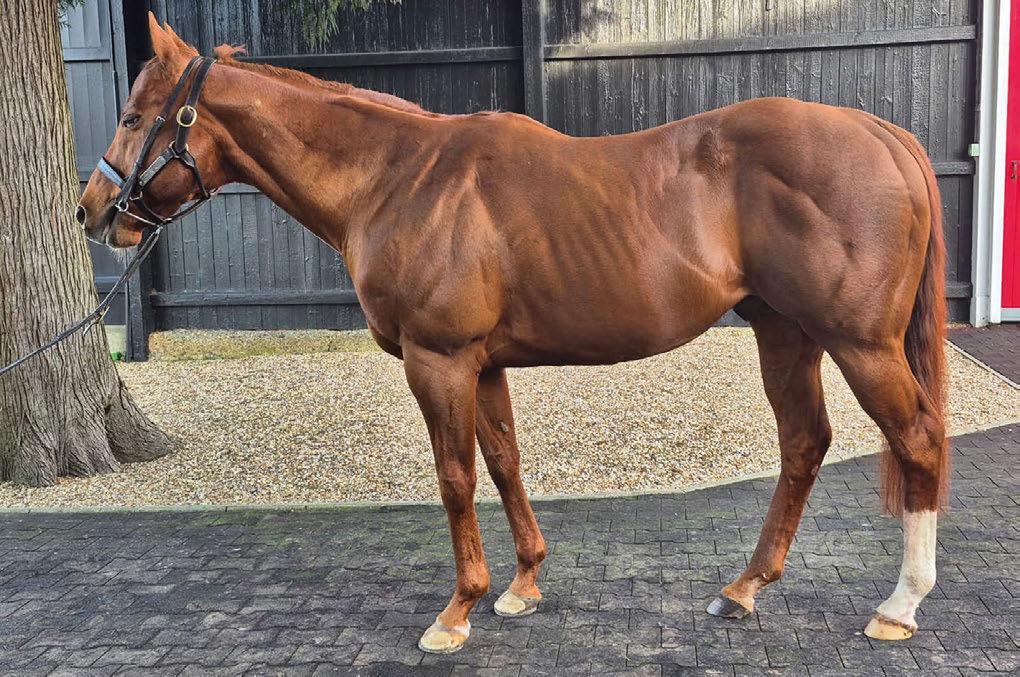

any underlying issues with the help of a veterinarian and check their dentition thoroughly. If deemed healthy, the focus should be to provide quality ad-lib forage with an appropriate senior feed to increase calorie intake. Consistent intake of forage will not only keep the digestive tract working efficiently, but it will also aid thermoregulation in colder temperatures.
The risk of laminitis increases with age, so it is best to avoid feeding mixes that are high in starch or sugar, as this can cause an exaggerated inulin response. It is recommended to plan ahead by increasing body condition prior to the winter months – it’s always better for a poor doer to be slightly overweight, creating a buffer for the inevitable weight loss. Targeted senior feeds should contain high-quality protein sources, such as soya or alfalfa, to support muscle maintenance. The full spectrum of vitamins and minerals alongside antioxidants are integral to
any horse’s diet. The combination of these will help to ensure immune health, muscle function and metabolic activity as well as hoof and coat quality.
Scott continues: “Immune status typically starts to decline as horses get older, causing them to be more susceptible to disease. Antioxidants help support the immune system by mopping up the free radicals which cause damage within cells. Vitamin C, vitamin E and some plant extracts are sources of antioxidants and can be added to the diet to support the immune system.”
Due to the decline in immune function, it is not uncommon for vaccinations to be less effective in older horses. Additives such as a pre and probiotics and herbs can assist in digestive function, utilisation and palatability, which can become an issue the older a horse becomes. Even though it is a normal assumption that old age and weight loss go hand in hand, that isn’t the case for all. Obesity can be just as detrimental, amplifying common issues such as joint stiffness, inflammation and body temperature regulation. Scott adds: “For older horses that are good doers, choosing a quality
stud balancer will ensure that nutritional requirements are met without providing excess calories.”
The digestive system is a complex structure and with age its efficiency can become hindered. Scott says: “This is due to a natural deterioration in the intestinal lining as horses age, making it less effective at absorbing nutrients. This particularly affects protein digestion and can lead to muscle wastage in older horses if not enough quality protein is supplied through the diet. Quality protein refers to the amino acid profile of the protein. High quality protein sources with good levels of the key amino acids – lysine, methionine and threonine – such as soya, should be favoured for older horses to help prevent muscle breakdown.”
That said, it is not uncommon for an older horse to require the same amount of nutrients and energy as a younger ‘working horse’, even though it can feel counter intuitive. Scott continues: “In addition to the changes happening in the intestine, the microbes that ferment fibre in the hindgut may also become less efficient as horses age. To help promote a healthy hindgut microbiome, ››
›› ensure that enough fibre is available and offering a variety of different fibre sources in the diet will also help.”
Previous research suggests that the microbial population of the hindgut does not change from a community’s perspective, though bacterial diversity does decrease with age. Scott adds: “Probiotics and prebiotics can also be added to the diet to support hindgut health. Many feeds such as feed balancers include probiotics and prebiotics in the formulation, as do specialist digestive support supplements.”
Older horses may have difficulty regulating their body temperature and like people, may be more sensitive to heat and cold as they age. With this in mind, extra consideration should be paid to supplying additional shade and cold hosing during particularly hot spells. Older horses aged 20 years and above are known to require more calories to keep warm compared to middle-aged horses living out during the colder weather. Therefore, during the winter months, rugs and/or thicker rugs might be required with adequate shelter from wind and rain if living out.
Insulin dysregulation goes hand in hand with ageing, thus the risk of laminitis and Pituitary Pars Intermedia Dysfunction (PPID) or Cushing’s disease increases. The points discussed within this article will all help manage horses suffering with these diseases. The key considerations are providing a diet low in starch and sugar (varying degrees of grazing restriction) and controlling body condition. Individuals suffering with PPID can be more susceptible to weather variations, loss of appetite and


Regular turnout remains important for veteran horses including retired mares and stallions
worm burdens due to a compromised immune system.
Dentition cannot be overlooked and it becomes increasingly important as a horse ages. Scott explains: “For veteran horses, as with all horses, fibre should form the base of the diet. Usually, fibre would be supplied through good-quality pasture or conserved forage. However, as horses age, their dentition may deteriorate, making it more difficult for them to graze or chew long fibre sources such as hay and haylage.”
The extensive range of HumberPalmers fertilisers are especially suited to equine pastures.
• Gradual nutrient release
• Balances pasture growth
• Improves soil health and fertility
• Boost equine health and nutrition
For further information and advice please contact: Gavin Young on 07824 664216 Email: sales@pbkent.co.uk www.humberpalmers.co.uk
Commonly-seen signs of failing dentition are quidding, bad breath, pocketing of food in cheeks, weight loss, inappetence, choke and colic. Scott continues: “When a horse can’t consume enough fibre, it will usually result in weight loss and will have a negative impact on digestive health. For horses that are not able to chew long fibre sources, it may be necessary to use forage replacements such as high-fibre cubes or mashes, which will be easier to chew and digest than hay or haylage.” Routine dental assessments and work is a non-negotiable in proper horse care – usually annual visits will suffice, but veteran horses may well require more regular attention.
Turnout, whether that is daily or all year round, is a crucial part of veteran horse management. The old saying ‘use it or lose it’ rings true for all living beings and thoroughbreds are no exception. In the wild, older horses would eventually be left behind, either due to their inability to keep up with the herd or by being subjected to alienation via younger herd members. A careful eye should be kept on the group dynamic and adjustments made accordingly. Making sure there is more than one area with hay and water available can help ensure the elderly members are not forced out. Sometimes older horses take longer to eat, so the provision of a separate feeding area can ensure they receive their given feed and do not miss out.
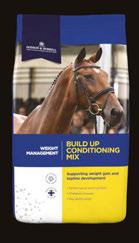


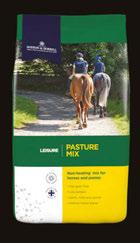





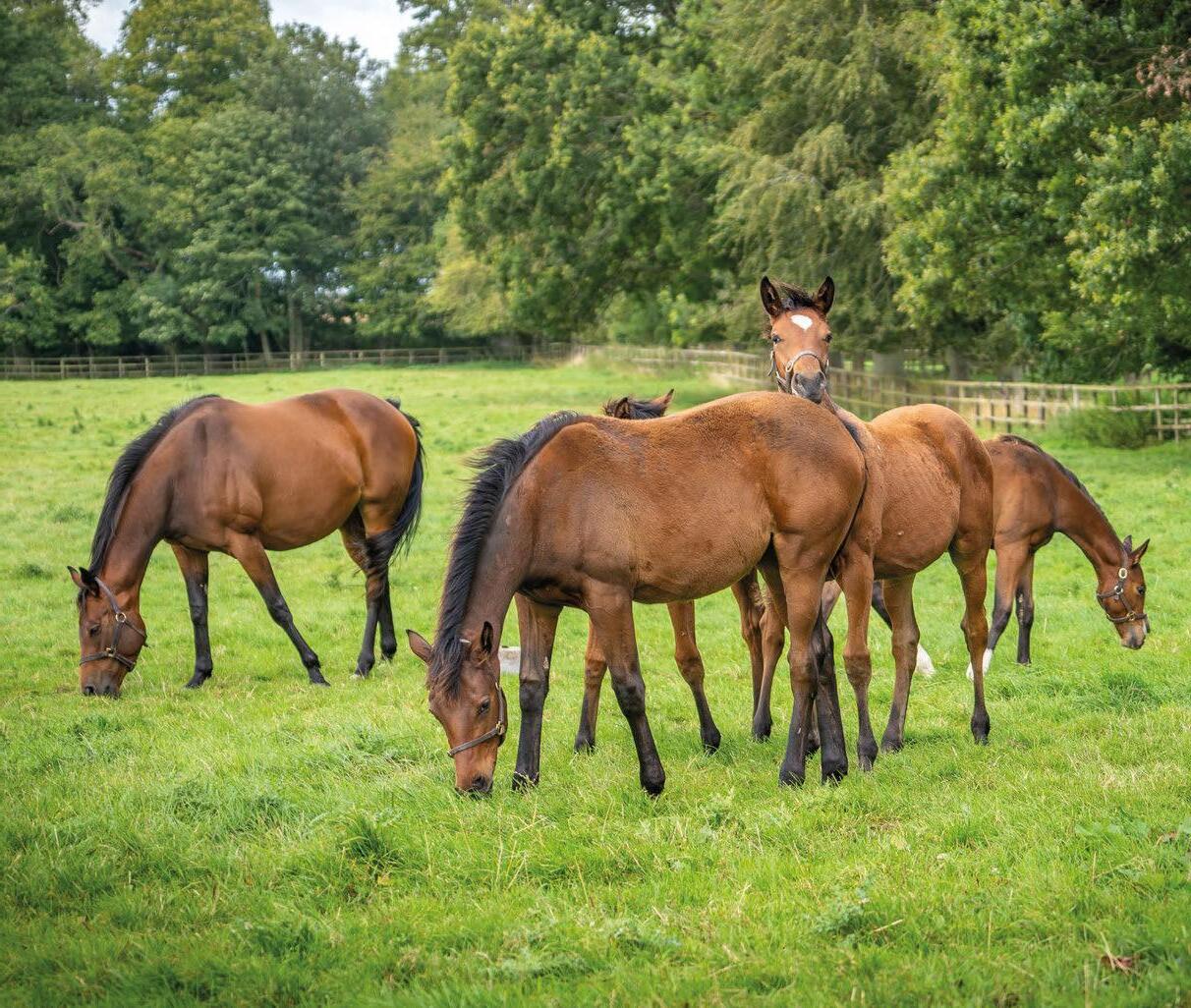


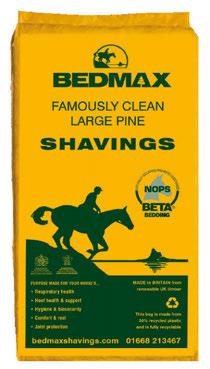



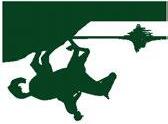
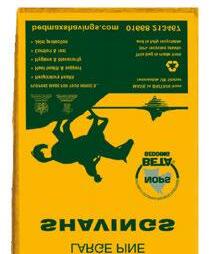
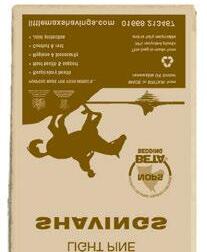


You will hardly be surprised when we say yes, good bedding can play a part in helping horses in training perform to their full potential.

That’s why we began producing Bedmax shavings at Greymare Farm in Northumberland 25 years ago, to offer trainers a bedding with the lowest possible levels of breathable dust, and to help you beat all the other key health risks that can affect horses that spend long periods in the confines of their stables.
Things have changed considerably in racing and here at Bedmax over the years, but our mission remains the same: to provide a top quality bedding that helps you get the very best out of all your horses.
Bedmax shavings today offer the lowest independently measured levels of breathable dust, and we continue to make our shavings predominantly from pine timber to offer customers the unique, naturally antibacterial protection that other softwoods don’t provide.
Bedmax has held a Royal Warrant since 2008 and is proud to continue to hold a Royal Warrant from His Majesty The King.

In 2021, we became the first bedding manufacturer to achieve BETA NOPS Bedding accreditation, which assures you that every stage of the production of our shavings is proactively managed to avoid contamination by any Naturally Occurring Prohibited Substance (NOPS) that might cause a failed doping test.
We supply our purpose made shavings to breeders and trainers all over the world
To find out more please call our International Sales Manager
Brent Adamson on +44 (0) 7774 178925
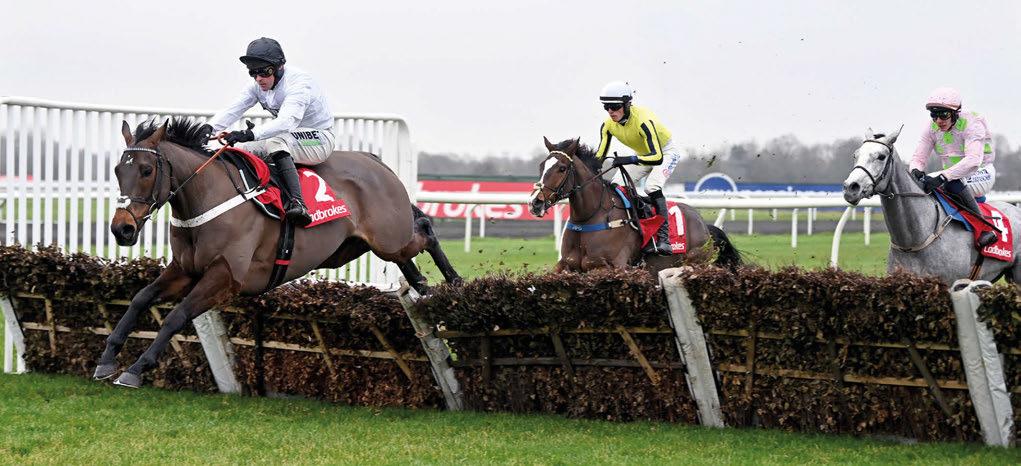
Arecord 46 racecourses have achieved the Gold Standard Award for 2024, up from 31 in 2023.
These results showcase significant strides in racecourse standards, with an average accreditation score of 85% and an average owner feedback rating of 4.4 out of 5. The growing engagement from owners is evident, with eight racecourses collecting over 100 pieces of feedback and with Kempton Park receiving an impressive 210 responses.
Since 2006, the ROA Gold Standard has recognised racecourse excellence for owners, with the Accreditation Scheme, introduced in 2019 and assessed by AA Hotel & Hospitality Services, ensuring consistent benchmarking. The record number of Gold Standard Awards for 2024 highlights racecourse improvements in pre-raceday communications, owner facilities on raceday, and post-raceday engagement.
To ensure we continue driving racecourse standards around the owner experience forward, some changes to the assessment process will be made for 2025. The assessment will be streamlined from 62 to 38 core questions, with greater emphasis on the factors most valued by owners, such
as seating availability, food quality, and the experience following a race where owners have a runner.
Additionally, the threshold for achieving the ROA Gold Standard will be raised, requiring racecourses to achieve at least 85% in their overall assessment, maintain an average owner feedback score of 4 or higher, and collect a minimum of 40 pieces of owner feedback annually.
Louise Norman, Chief Executive of the ROA, said: “The ROA is delighted to recognise a record number of Gold Standard racecourse awards for 2024. This is a testament to the commitment of racecourses in ensuring owners enjoy a premium experience at the races, and we extend our congratulations.
“Excellence is an ever-moving target and by refining the criteria for 2025, we will ensure it remains a mark of distinction, driving further innovation and improvement for the benefit of racehorse owners in recognition of the consistent and loyal support they provide.
“We look forward to working on behalf of owners to continue raising the bar and providing the highest-quality experience”.
Simon Numphud, Managing Director of AA Media, said: “Our assessments
on behalf of the ROA highlighted an excellent performance overall, which is recognised with a record number of Gold Standard racecourse awards in 2024.
“As the ROA recognises, now is the time to truly refine the criteria for 2025 to further drive excellence across the board.”
The racecourses receiving the Gold Standard Awards this year are Aintree, Ascot, Ayr, Bangor-on-Dee, Bath, Brighton, Carlisle, Catterick, Cheltenham, Chepstow, Chester, Doncaster, Epsom Downs, Ffos Las, Fontwell Park, Goodwood, Hamilton Park, Haydock Park, Hereford, Huntingdon, Kempton Park, Leicester, Lingfield Park, Market Rasen, Musselburgh, Newbury, Newcastle, Newmarket (July course), Newmarket (Rowley Mile course), Nottingham, Perth, Redcar, Ripon, Sandown Park, Sedgefield, Southwell, Stratford, Thirsk, Uttoxeter, Wetherby, Wincanton, Windsor, Wolverhampton, Worcester, Yarmouth and York.
We sincerely thank all ROA members who contributed their feedback in 2024 – please visit roa.co.uk/feedback to get involved for 2025.
A full league table of the Gold Standard Awards appears on page 83.
Last year saw a milestone for the ROA’s Owner Sponsorship Scheme as it reached its 20th anniversary. That’s 20 years of enabling ROA members to register for and reclaim their VAT, which currently averages at £4,700 per horse per year. As we sponsor up to 2,000 horses a year, that is a significant sum of money returned to owners in that time.
We are delighted that the Tote have invested in this muchappreciated benefit of membership since 2020 and will continue to do so through 2025. With three regular logo options displayed on owners’ silks (Tote, Tote Placepot and tote.co.uk) they are a familiar sight up and down the country and are supplemented by the World Pool logos at key festivals throughout the Flat season.
In 2024 the logos were carried just under 7,000 times, with over 40% of those runners obtaining a top-four placing. It wasn’t just about quantity, though, quality was involved too, including Mill Stream storming to glory in the July Cup, Minella Drama scooping the Old Roan Chase and who could forget Nickle Back’s flying victory in the Scilly Isles Novices’ Chase? Honourable mentions are also warranted for Group/Grade 1-placed Libberty Hunter and Lookaway at the Aintree Grand National Festival and Emily Upjohn at both the Derby and Ebor festivals.
The World Pool logos replaced the standard Tote logos at seven

key festivals during last year’s Flat season, with their 65 runners including winners at Epsom Derby Day, Royal Ascot, Glorious Goodwood and the Ebor festival. We will update members shortly with the World Pool dates for 2025.
If you require sponsorship for any
of your horses, please contact us at sponsorship@roa.co.uk or 01183 385680. If you have yet to register to reclaim your VAT or wish to switch to a team that help, make this process seamless, please contact our VAT Solution team at vat@roa.co.uk or 01183 385685.
At the ROA, we’re committed to listening to what matters most to you – both as an owner and as a member. That’s why we’ll soon be inviting all ROA and Racegoers Club members to share their views on what you want from ROA membership and how we can better represent you, the owner, at an industry level.
All registered owners who are not currently ROA members will also be invited to complete the survey. Keep an eye on your email inbox
in the upcoming weeks for an invitation to take part in our online survey. Your feedback will play a vital role in shaping the future of ROA membership, our benefits and services, whilst ensuring we’re advocating for your interests across the industry.
If you do not have an email address but would like to take part in the survey, please contact us on 01183 385 680 and we can go through the survey over the phone at a time
convenient to you.
There will also be an opportunity to give us more information through phone interviews. There will be the option to opt in to take part with these at the end of the survey.
We want to hear from you, and we value every opinion. This is your opportunity to have your say and make a difference to ROA membership and help us shape the future of how we represent owners in British racing.
We have teamed up with Venatour to provide both ROA and Racegoers Club members with bespoke horseracing tours to get into the heart of the racing action and enhance their membership experience.
The new partnership has unveiled an exciting line-up of exclusive racing tours and high-end racing experiences for 2025, as well as a personal discount on all Venatour overseas tours for members. From yard visits to a trip to Daylesford Stud, there is something for everyone.
Venatour overseas offering include racing tours across the globe with the Dubai World Cup, Breeders Cup, Arc De Triomphe, Punchestown Festival, Melbourne Cup, Hong Kong and the Pardubice. Our exclusive link up is now also providing bespoke trips closer to home with the chance to visit Daylesford Stud and Farm Shop, a trip to the Morgan Motor Company followed by racing at Cheltenham, and hospitality at Doncaster’s St Leger Festival.
Members can see the events schedule, pick up the discount code for overseas trips and book at www.roa.co.uk/events.
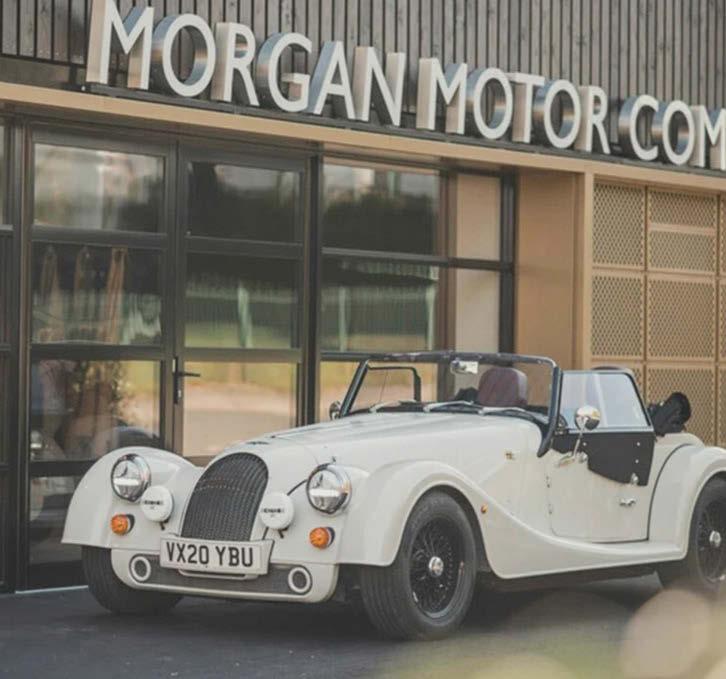
The independently-chaired Horseracing Industry People Board (HIPB) has published its workforce strategy, aiming to secure a brighter future for everyone working in British racing and breeding.
Covering an initial three-year period, ‘Our People, Racing’s Future’ sets out a vision for ensuring racing is an attractive, rewarding and fulfilling industry in which to work, where people feel supported to build a career and achieve their potential.
The strategy addresses some of the most pressing challenges facing the industry while looking longer-term at how racing can evolve to meet the changing needs and expectations of a modern working environment, from recruitment and training to employment standards and wellbeing.
This is the first time an industrywide plan has been agreed with a singular focus on racing’s workforce,

whilst recognising the vast amount of positive activity already underway in the people space, particularly established pathways that prepare people for a career in racing and access to specialist recruitment, development and wellbeing support services.
Racehorse breeder and owner Maria Bourke, who is also Managing director of Let’s Get Healthy, an award-winning consultancy and training company which provides transformation of colleague and customer experience, said of the strategy: “It is great that British racing is using data, expertise and insight to ensure that focus is placed on the care and development of those working in our sport.
“The strategy is a brilliant start; we are behind other sports and need the whole industry to put our racing staff at the heart of every decision

made. As an owner and breeder, my priority is the welfare of my horses and I urge everyone to support any initiatives that put staff development and wellbeing at the forefront of all activity and decisions. Improvements will, without a doubt, lead to improvements for the stars of our sport – the horses!”
For more information on the strategy visit roa.co.uk/workforce.

As part of the ARC £1,000,000 All-Weather Bonus, the Horse of the Month prize for January is to be shared by ten horses.
Brazilian Rose, Cloch Nua, Master Of My Fate, Tadreeb, Joolianoss, Init Together, High Court Judge, Back Tomorrow, Ash Wednesday and William Dewhirst all share first place at the top of the leaderboard for the month on 15 points. Connections of each horse will receive £7,000 each. This is the first time a monthly prize has been shared by this many horses. Now in its third season, the ARC £1,000,000 All-Weather Bonus began on Tuesday, October 222 and will culminate on Good Friday, April 18.
Points are awarded for finishing in first place down to fifth, and the horse with the most overall points at the end of the season will receive a bonus of £100,000 and be crowned Horse of The Year. Points are accrued in a horse’s first three runs in any monthly period at Lingfield Park, Newcastle, Southwell and Wolverhampton.
Further Horse of the Month prizes will be awarded for February and March/April.
Punchestown Festival offer
Our friends at Punchestown racecourse have extended an invitation to all ROA members to race for free on the opening day of the 2025 Punchestown Festival on Tuesday, April 29.
ROA members can enjoy complimentary admission for an action-packed afternoon at the home of Irish jump racing with no less than three Grade 1 contests including the William Hill Champion Chase.
To take advantage of this offer, complete the application form in the members area of the website. Your details will be passed to Punchestown who will then send on an eTicket.
Raceday Curtailment Scheme
Fakenham will not be making any payments to owners following the abandonment of the final race on Sunday, February 19 so the ROA Raceday Curtailment Scheme will kick in. Horses that are owned over 50% by ROA members and were due to participate in the concluding bumper will qualify for a £100 payment. This payment will help reduce travel costs that owners will have incurred on the day. ROA staff have been in touch to collect bank details in order to make payment. Read more at roa.co.uk/rcs.
ROCS renewed
The Racehorse Owners Compensation Scheme (ROCS) has been renewed for 2025 with renowned bloodstock insurance broker Lycetts. The cover, available at an additional fee, provides access to financial compensation for the owner of a racehorse that is injured, either temporarily or permanently, covering the costs of treating the horse at a top veterinary clinic and the value of the horse if it dies. To find out more about the scheme and view the new brochure for 2025 visit roa.co.uk/rocs.
Delay to Racing Digital Racing Digital, the new online platform that will gradually replace the current Racing Administration
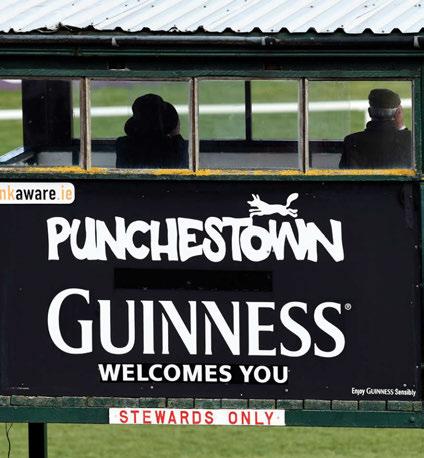
site used to make entries and declarations and manage all aspects of ownership, has been delayed. The first stage of this programme is now due for launch in the first half of 2025. It will see anyone with horses in training start using the Racing Digital Hub for key activities such as registering as an owner, managing ownerships, horses and sponsorships, and registering for VAT in a more streamlined way.
Leicester changes
Leicester will no longer be using the PASS system for owners with runners on the day or for members wishing to use the Racecourse Badge Scheme for Owners. The new procedure for each is as follows:
• OWNERS WITH RUNNERS: The course will contact your trainer with details of how to apply. Should you wish to contact the course directly please email Diana Wilder at racing@leicesterracecourse.com.
• RACECOURSE BADGE SCHEME FOR OWNERS: Please complete the form on the RBSO page of the members area to pre-book your badges. Requests should be made by midday on the working day before the meeting you wish to attend.
Whether or not trainers should be paid for giving interviews live on TV is a divisive question, yet there is no doubting their value to racing fans. For Rupert Swallow, the zeal shown by one member of the training fraternity proved the catalyst for his jump into individual ownership.
Swallow, a venture capitalist who spent over 30 years in the insurance industry, had only been involved in syndicates, notably Phil Cunningham’s Rebel Racing, prior to the 2021 Cheltenham Festival, which was closed to spectators due to the pandemic.
That year’s Hunters’ Chase (previously known as the Foxhunter Chase) was won by Porlock Bay, trained by Will Biddick, whose eloquence on television in the aftermath of victory encouraged Swallow to get in touch.
“Jump racing was always my passion,” explains Swallow, talking via Zoom from his home office in front of Ed Byrne’s stunning black and white photograph of brilliant chaser Pendil, dual winner of the King George VI Chase, who was owned by his mother, Cynthia.
“When my company, Capsicum Re, was sold in 2020, one of the things I really wanted to do was see if I could get more involved in National Hunt racing. That didn’t take on any substantial structure until I watched the Covid Cheltenham.
“I saw Will on TV and he displayed this incredible enthusiasm for winning. I looked him up and wrote to him, explaining that I wanted to get involved in the jumps game and would like to meet him.
“Will didn’t contact me for a week or two – likely he was busy enjoying his success! – but I did hear from him eventually and we’ve since become fast friends.”
With Biddick on board along with bloodstock agent Ed Bailey and lawyer Andrew Holderness, plus Swallow’s wife Dee, The Pendil Partnership was born.
Keen to utilise the experience of his co-owners, Swallow set out to learn all he could about buying jumps prospects before embarking on his ownership adventure with 14-times champion jumps trainer Paul Nicholls.
He says: “Will’s main business is
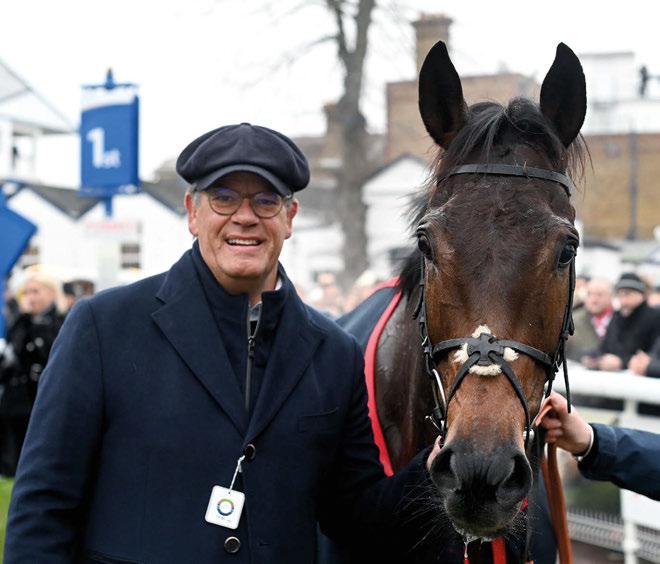
breaking horses – he breaks a lot of Paul’s store horses and trains his own point-topoint horses using Ditcheat’s facilities, so that’s the connection with Paul.
“Anyone who’s made a few quid could probably turn up at Paul’s any time and buy themselves a decent horse, but the way I looked at it was when I arrived it didn’t matter whose yard it was, I wanted to be regarded as someone who’d spent time learning the business.
“Rather than rocking up and saying, ‘Here’s a quarter of a million quid, can I buy a horse please?’, I decided to source store horses and look at it as a sort of undergraduate course, a university degree in jump racing.
“I started by learning how to look at a horse, its conformation, how it walks, trying to identify good horses when they are unbroken stores – Will and Ed helped on that side. I also wanted to understand the dam and sire lines.”
Swallow’s first trip to the Goffs Land Rover Sale was in 2021 – he sold his McLaren sports car pre-auction

to boost his budget, swapping one type of horsepower for another – and came back with Il Pino and Regatta De Blanc, purchased for a combined sum of €107,000. Both started off in the point-to-point sphere, their owner keen to “validate” his purchases before racing under Rules, with each winning at the first time of asking.
Having seen at first hand the competitive nature of the store market, Swallow vowed to return with gusto the following year and duly did so, spending €120,000 on a daughter of Flemensfirth.
“It was a lot more than we budgeted for,” Swallow recalls. “But if you really want to buy the horse you want, you need the firepower.
“She was an absolute standout, an amazing mover – she had star quality from the start.”
Jubilee Alpha has indeed shown star quality on the track, following a debut bumper success at Wincanton with a fine second in the Grade 2 mares’ bumper at Aintree’s Grand National meeting last April.
After an eye-catching third on her hurdling debut at Newbury in November, Jubilee Alpha recorded an easy victory in a Listed contest at Taunton before travelling to Windsor – her owner’s local track – for a novices’ hurdle at the Berkshire Winter Million meeting. She justified favouritism in decisive fashion to set up a tilt at the Grade 2 Dawn Run Novices’ Hurdle at the Cheltenham Festival this month.
It’s been a remarkable start for The Pendil Partnership, with multiple winners and a live Festival contender in their ranks, yet Swallow – who has subsequently bought two more horses at the sales – points out that life is rarely straightforward when it comes to owning racehorses.
He says: “The ownership experience is encapsulated in these five horses. One store horse we bought won’t ever race –even a wind op couldn’t solve his issues. One horse has done a tendon and is out for the year. Another horse has various problems with poor feet and ulcers. In the middle of all that is Jubilee Alpha, our diamond.
“My expectations are tempered by the fact I know what a cauldron it will be at the Festival. But I still wake up in the middle of the night thinking this could actually happen.
“Regatta De Blanc won at Cheltenham’s hunter chase evening meeting last year, so Dee and I have led a
“Jubilee Alpha was an absolute standout – she had star quality from the start”
horse through that famous channel into the winner’s enclosure, but it would be totally different to have that experience at the Festival.”
With his financial nous and experience of investing in start-ups, Swallow saw an opportunity to create a business out of his love of horses through micro-ownership, which also picked up on his passion for mentoring young people.
It led to him leasing two of the partnership’s horses to a syndicate last season. While there was a fair take-up, the final numbers didn’t add up.
“The long and short of it is although we sold around 400 shares, we really needed to sell 4,000 shares to make it financially viable,” Swallow says. “I anticipated that young people would buy their share and use social media to provide the momentum, but it just didn’t happen for us.
“It’s a little hard for me to talk about. Being a venture capitalist, you get used to failure. Quite often you learn a lot more through the failures than through the successes. I believed it was for the benefit of jump racing so was disappointed it didn’t work out. Will I try again? Never say never.”
Thankfully, Jubilee Alpha has enjoyed more successes than failures in her short career and her ownership group will be hoping their star mare enjoys more luck at
Prestbury Park than the horse after whom their partnership is named.
Trained by Fred Winter, Pendil – who resided on the famed ‘Millionaires’ Row’ at Uplands stable in Lambourn alongside fellow stars Bula and Crisp – won the 1972 Arkle Challenge Trophy but suffered bad luck in the Gold Cup for the next two years under Richard Pitman.
In 1973 he looked to have the race at his mercy – “this fence between Pendil and victory” declared Peter O’Sullevan in commentary – only to be mugged by The Dikler late on, while a year later he was brought down three out by faller High Ken when still travelling well.
Is there unfinished business for the Swallow family at Cheltenham? Perhaps.
“It’s part of my mother’s folklore,” Swallow says. “Pitman admits he got it wrong in ’73 going to the front as early as he did, while the next year he positioned himself behind a well-known faller and was brought down.
“My mother had received an IRA death threat on the horse just before the race so when he came down, she thought he had been shot! It’s quite a gnarly background.
“I was very young when he was winning so I don’t remember it but jump racing has always been a bubbling theme in my life.
“Mum still loves her racing – she’s in her mid-80s and quite frail but still sharp as a tack.”
Win, lose or draw at the Festival, Swallow is relishing the ride with Jubilee Alpha and may even breed from her when the time is right. At present, he’s simply enjoying life as a racehorse owner.
“I hadn’t anticipated the friendships and relationships we’ve built around ownership,” Swallow says. “I’ve been amazed at how friendly all the connections are that you meet – it’s been heart-warming.
“I was also unprepared for the emotional connection with the horses themselves and the experiences they were giving us. After the first couple of winners, I was completely overwhelmed!”
He adds: “There are lots of trials and tribulations to being a racehorse owner, but I don’t feel any of those are created by the system – they’re just learning points in the journey.”
The Dublin Racing Festival (DRF) continues to grow in popularity and is becoming a must-visit for British racing fans. My first trip was in 2022, having watched from afar the previous year. Covid meant that the DRF had to take place behind closed doors and watching it on TV just made me want to be there. The seed was sown, as it must have been for so many other Brits. Leopardstown reported that over 30% of ticket sales for the 2025 DRF were to customers with British addresses.
Our original party from 2022 has doubled in size, from three to six, and 2025 had a special feel to it. Dublin was also hosting thousands of English rugby fans for the opening fixture of the Six Nations, so the city was buzzing even more than usual. But instead of the rugby being in competition with the racing, it complemented the DRF, with the match kicking off after the racing had finished.
The Irish know how to put on a party and this was a fun weekend. We were treated to a moment of history with Galopin Des Champs triumphant for the third successive year in the Irish Gold Cup. The reception he received from the crowd was magnificent. He is finally getting the recognition he deserves and Leopardstown would be well advised to get the builders in to check the bolts holding down the roof, as they could lose it if he comes back next year and wins a fourth Irish Gold Cup!
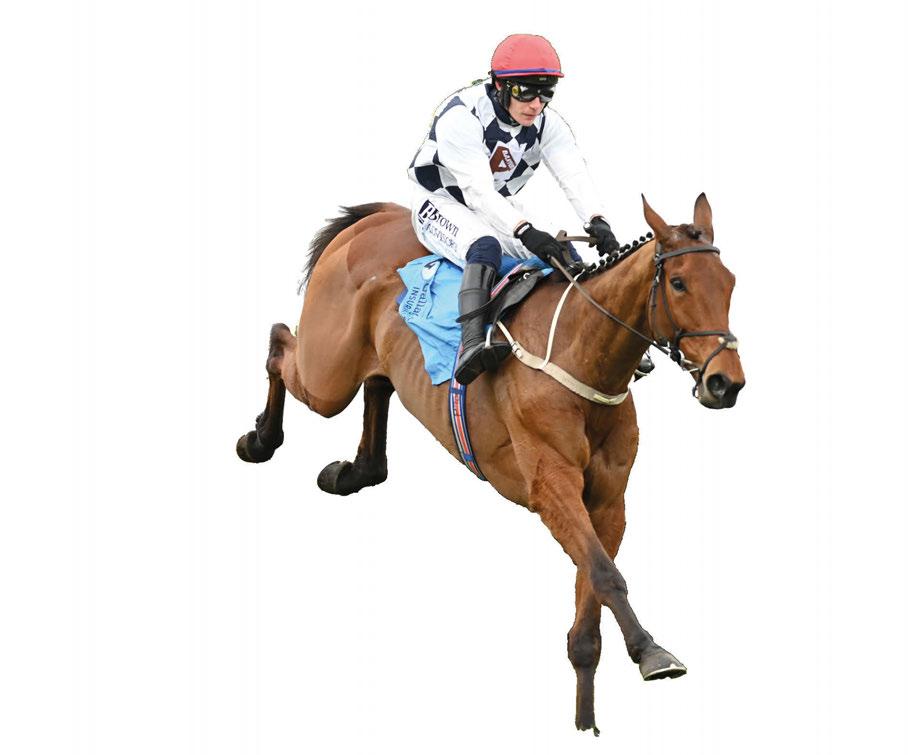
One of the things that Leopardstown gets right is it encourages punters to stay after the racing has finished. There was live music as well as the rugby on almost every TV or big screen you could see. There were no lengthy queues at the bar – and they take cash. The crowd dispersal was managed so efficiently that there was no queue to get on the courtesy shuttle bus.
The Sunday saw the emergence of a potential superstar in Kopek Des Bordes. I’m particularly looking forward to seeing him at Cheltenham, as well as Ballyburn, Final Demand, Galopin Des Champs and a whole host of others. Last year saw 11 Cheltenham Festival winners victorious after having their previous start at the DRF, but only
Ballyburn: impressive performance at the Dublin Racing Festival
wish that everyone stopped comparing subsequent years with the 2022 attendance, as we all know that was a blip.
Let’s hope the changes made for this year’s Festival are successful in producing more competitive races and Cheltenham can arrest the decline
Thursday, April 3
Racing Welfare Aintree Lunch
Friday, April 18
Peter O’Sullevan Lambourn Open Day
Friday, April 18
Racing Welfare Middleham Open Day
name, I scoured the race card for Kederwash. I was somewhat confused until I looked up at the big screen and saw Katie Walsh with a beaming smile after steering Relegate to victory. From that day onwards, Katie has always been known as ‘Kederwash’ in the Wells household.
Tuesday, April 29
Free entry to day one of the Punchestown Festival
Tuesday, May 6
Racing Welfare Woburn Golf Day
Friday, May 16
Discover Newmarket Tour with racing
June 21-27
Racing Staff Week

At the ROA, we’re committed to listening to what matters most to Owners.
Which is why we will shortly be inviting all Owners, ROA members and Racegoers Club members to share their views on ownership with us, with our Ownership survey.
Your feedback will play a vital role in shaping the future of ROA membership, our benefits and services, whilst ensuring we’re advocating for your interests across the industry.
Look out for the invitation to complete the survey in your inbox shortly.

This month’s auction lot available exclusively to ROA members in partnership with Racing Welfare is a hospitality package for four people on Friday, August 22 at York racecourse during the Sky Bet Ebor Festival, followed by an overnight stay at a luxury hotel in York.
On the day of the Coolmore Nunthorpe, the winning bidder will enjoy one of the finest experiences in racing from the comfort of the Voltigeur Restaurant. Designed to combine the luxury of a restaurant with the spectacle of racing, you can enjoy a sumptuous lunch and afternoon tea from a gourmet buffet and carvery in comfort and style, with
Racing Welfare gave an expectant young family facing physical health and financial dilemmas the breathing space they needed to survive, after an injury threatened to see a talented work rider left out of the saddle for good.
Dan Burns, 39, a self-employed work rider from Lambourn, sustained a debilitating knee injury while playing rugby, resulting in damage to his anterior cruciate ligament and meniscus cartilage. Unable to walk, let alone ride, Dan, who is highly experienced and has worked in the racing industry for more than two decades, was unable to work, and being self-employed it meant he didn’t have an income to support himself and his family.
At the time of his injury in 2023, his wife Bridie was expecting their first baby, and at what should have been the happiest time of their lives they were left worrying about how they were going to survive financially and get Dan better and back into work.
Dan said: “I got injured and six weeks later our daughter was born. I couldn’t really do much for myself, so my wife
dedicated Knavesmire grandstand seating just a few feet away.
Complete your day with an overnight stay with two rooms at boutique hotel, No. 1 York, by GuestHouse. Set in the heart of the city, No.1 York is a Grade II Listed Regency townhouse full of heritage detailing, quirks and endless style. The package includes a bottle of sparkling wine in each room and breakfast on the morning of August 23.
Head to www.bidtogive.co.uk to place your bid before 5pm on Friday, March 28. All funds raised will go towards Racing Welfare’s crucial work in supporting all of racing’s people.

had to look after me as well as our newborn daughter – I felt awful about the situation. I saw a surgeon and was put on the emergency list for surgery, and he only gave me a 20% chance of riding again because of the extent of my injuries. It was really touch and go.
“After the surgery I needed intense rehabilitation, and this is where Racing Welfare stepped in. I can’t praise them highly enough. Kerry, a welfare officer, was so helpful and quick at getting things sorted. As well as arranging and funding physiotherapy, I was also awarded a financial grant to cover our rent for two months – it gave us the breathing space we really needed.
“I’m normally quite a strong person mentally, but I did struggle to cope when

I was injured, in pain and out of work. My little girl and wife definitely helped me through it – along with the support from Racing Welfare.
Out of work for over a year due to the extent of his injuries, Dan initially was accessing rehabilitation and physiotherapy support on a twice-daily basis, organised and funded by Racing Welfare and delivered at Oaksey House in Lambourn. Dan is now back in the saddle and riding for a number of trainers and consignors including Owen Burrows and Malcolm Bastard.
Dan continued: “Racing Welfare saved our future, and meant I had the time and support I needed to get back to work. I ride as many lots as I can and juggle my workload with my wife’s, so we’re able to care for our daughter and both earn too. I’m back to full fitness now and doing a job I love thanks to Racing Welfare.”
Aimed at helping racing’s people from recruitment to retirement, to thrive in day-to-day life and through a range of life’s challenges, Racing Welfare is a charity dedicated to enhancing and supporting the wellbeing of the workforce of British horseracing. To find out more about our services or how you could help make a real difference to people like Dan and his young family, visit www.racingwelfare.co.uk.
Owners
£11.8 MILLION
We’ve paid out £18 MILLION since launch in 2020
Breeders
£3.8 MILLION
Trainers
£1.3 MILLION
The tables set out the average prize-money per fixture staged by each racecourse in 2024, covering the three main components of prizemoney: racecourse contribution, Levy Board (HBLB) funding, and owners’ entry fees. Abandoned fixtures are not included in the table, but the abandonment of a valuable fixture could have a negative impact on a racecourse’s performance. The tables rank racecourses by their own average contribution per fixture, with the adjacent column showing how this 2024 average compares to that racecourse’s contribution during 2023.
JCR Jockey Club Racecourses
ARC Arena Racing Company
I Independently owned racecourse
* includes £1.1m in BHA Development Fund spend
** includes British Champions Day
The ROA Racecourse Accreditation Scheme was launched in 2019 as an independent review of owners’ raceday experiences, using a defined set of criteria and assessed by AA Hospitality Services, which also provides constructive feedback.
The scheme has continued to evolve as part of the process and in 2022 an owners’ feedback section was introduced, allowing owners to share their thoughts on their raceday experiences. Racecourses achieving an AA mark of 80 or above and an owners’ feedback score of 4 or above are awarded the Gold Standard to signify exemplary performance.
Since its introduction we have seen significant and positive steps being taken by the racecourses to ensure that the owner experience is treated with paramount importance. We are delighted to see that the average AA score has increased to 85%, and in 2024 a total of 46 racecourses have achieved the ROA Gold Standard, up from 31 in 2023.
Our goal, in collaboration with racecourses, is to improve and enhance the raceday experience for owners. The ROA and racecourses recognise that going racing with a runner is the pinnacle of ownership, and we want to ensure that it is a memorable experience that exceeds expectations.


The Thoroughbred Group is the collective organisation representing the Racehorse Owners Association, the Thoroughbred Breeders’ Association, the National Trainers Federation, the Professional Jockeys Association and the National Association of Racing Staff. The group is formally recognised under the sport’s governance structure.
The Thoroughbred Group is a 2022 rebrand of the Horsemen’s Group, which was established in 2006. The group has continued since that inception but operated without any central resource between the years of 2015 and 2023.
The Thoroughbred Group now has an independent Chair in Julian RichmondWatson, and in March 2023 appointed Jack Connor as Racing and Analytics Executive.
More information on the Thoroughbred Group and its membership can be found at www.thoroughbredgroup.org.uk.
What are the aims of the Thoroughbred Group?
The Thoroughbred Group has several aims and objectives as set out in its Members’ Agreement, which was redrafted in 2023:
• Negotiating and entering into commercial partnerships with racecourses.
• Identifying, proposing or brokering
areas of common ground between members so as to strengthen their collective bargaining power where thought appropriate.
• Providing central resource to the members in matters of strategic support, project management, data analytics, and any other activity thought to be beneficial to the members.
• Where appropriate, offering collective representation for the members at industry forums.
• Acting in a manner which aims to promote the long-term health of British horseracing and the thoroughbred breed more generally.
What are the group’s current priorities?
The main focus of the Thoroughbred Group continues to be the brokering of commercial partnerships with racecourses. Commercial partnerships seek to establish a mechanism that ensures that a fair proportion of racing’s income flows back to owners and participants via prize-money, and embed a structure that incentivises greater competition between racecourses. Whilst there are some similarities with the lapsed pre-Covid prize-money agreements, the new proposal is more ambitious in its scope and incorporates all income streams, not just media rights.
The relative complexity of the proposal means that there is quite a
lot of detail to work through, however, talks with racecourses are progressing well. The intention is that commercial partnerships can be put in place such that racecourses are incentivised to stretch their prize- money investment from the beginning of 2026. More information on the structure of the proposal, and why Thoroughbred Group members think partnerships are integral to the future of the sport, can be found at www.thoroughbredgroup.org.uk/ commercial-partnerships.
Other priorities for the group centre around two key projects that the industry is currently undertaking. The Thoroughbred Group is central to the management of Project Pace, which is seeking to establish whether a repositioning of British racing’s elite Flat product can provide a step-change in racing’s revenues and potentially unlock external investment opportunities, for the benefit of the whole sport.
The Thoroughbred Group is also represented on the steering committee for Project Beacon, which is the largest piece of consumer research ever carried out by the sport. Engagement drivers and barriers will be assessed across the four key areas of watching, betting, attending and ownership, with the ROA taking a leading role in the latter. The project will define how the sport can better appeal to both new and existing fans across all age groups.
The business of bloodstock can be as complex as the sport itself. From income tax and VAT to capital gains and inheritance planning, getting it right means working with specialists who understand the industry.
At Streets Bloodstock we provide specialist tax and accounting services tailored to thoroughbred breeders, racehorse owners, and bloodstock investors.
Whether you need help with:
Structuring your bloodstock business – trade vs. hobby, partnerships and companies
Treatment of VAT – Racehorse Owners VAT Scheme, reclaiming VAT on breeding
Navigating capital gains and inheritance tax – preserving wealth and succession planning
Managing international sales and cross-border tax – reclaiming VAT on UK imports
We are here to help…
With specialist experience in the bloodstock industry, we ensure your tax and nancial matters are as well-managed as your horses.
Lushington House






One of the current challenges for our industry is recruitment and retention of skilled stud employees, writes Joe Grimwade, TBA Industry Retention Consultant. Bloodstock breeding is not alone but that is part of the problem – there is a lot of competition to attract the next generation of the workforce.
Salary levels, whilst important, are only a part of an attractive employment package and there is a lot to shout about in the career prospects and employment terms that we can provide. The old reputation for long hours and low pay no longer applies, but there is work to be done to ensure that potential recruits recognise the opportunities that we can offer.
Equally, we must accept that demands beyond a five-day/40-hour week will, increasingly, limit our appeal, but this also offers an opening for employers who can adapt their working practices.
The TBA, working with Howden Insurance Brokers, have come up with an option for employers to provide financial support to employees who are unable to work because of injury. The Stud Employee Accident Benefit Scheme (or SEABS) provides salary protection for absence that results from a qualifying injury for up to two years, as well as capital payments for death or permanent disability. Most accidents qualify (and the scheme is not restricted to accidents at work), but riding and specific dangerous activities are excluded.
Salary protection pays up to £400 per week (less SSP while applicable) to the employer on the basis that the employee’s
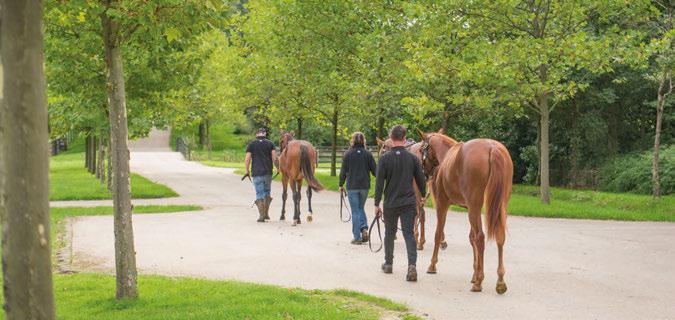
salary will be at least £400 per week or their current pay level if lower (subject to normal payroll deductions). For employers who already offer enhanced SSP, the scheme will help to cover their costs; for those who do not, the scheme enables them to offer enhanced SSP with very limited financial exposure. Payments for death and permanent disability are significant at up to £77,250 and £154,500 respectively.
The cost to the employer is £96 per employee per year – well under £2 per week – and offers amazing value when compared to comparable schemes.
Operation of the scheme will be through a portal attached to the TBA website; the employer must be a TBA member, and the employees must be stud employees in the UK with contracts of employment (including administrative and maintenance staff); all horse-facing staff must be included.
As the 2025 foaling season is now in full swing, breeders are reminded that they must notify the General Stud Book (GSB at Weatherbys) of the birth of all British-bred thoroughbreds within 30 days of the foaling (day one being the date of birth), to ensure they are eligible to race. Notification is free of charge and should be completed via the GSB online portal: www. weatherbysgsb.co.uk.
The 30-day foal notification is an important component of the industry’s
equine welfare strategy, providing transparency on the whereabouts of youngstock prior to entering licensed training premises and demonstrating the sector’s commitment to fullest possible traceability of thoroughbreds at all life stages.
Please be aware that 30-day foal notification is a different administrative process to foal registration, however, both may be submitted using the GSB online portal and can be carried out consecutively
Each participating employer can register up to three administrators who will have exclusive access to their list of employees on the portal and who will be responsible for creating and updating that list.
Employee details are kept only for the administration of the scheme. The TBA will issue quarterly invoices – initially for the listed employees in advance and thereafter with the addition of adjustments for departures and arrivals in the intervening period.
Our target should be no less than offering the best working practices and career opportunities in the UK equine sector. SEABS has the potential to further enhance our employment package offer and, with other initiatives in the pipeline, it is becoming a very realistic ambition.
If you employ stud staff in the UK and would like more information as soon as it is available, please email seabs@thetba.co.uk.
(but the 30-day foal notification must be done before the foal registration can be initiated).
If the 30-day foal notification has not been completed within the permissible timeframe or there are challenges to completing the process, breeders are advised to contact the traceability helpdesk at the BHA at their earliest convenience, either via email at traceability@ britishhorseracing.com or on 020 7152 0180.

At the end of January, the TBA and other industry bodies were delighted to meet with members of the All-Party Parliamentary Group (APPG) for Racing and Bloodstock, to showcase how British breeding supports both national and local economies and highlight how the sector drives inward investment, supports employment in rural communities, and has a significant positive impact on the environment.
Visiting Newmarket on January 30, members of the APPG visited Clarehaven Stables, the British Racing School, the National Stud and Tattersalls, where they received presentations and enjoyed lunch on the first day of the February Sale.
The group, which included MPs Nick Timothy, Dan Carden and Jack Rankin, as well as Baroness Harding, Lord Herbert and Baroness MacIntosh, were given presentations by Tattersalls' Finance Director Caroline Scott, along with the TBA’s Chief Executive Claire Sheppard and Kevin Needham, Chair of the Racehorse Transporters Association.
The visit to Newmarket was organised jointly by the BHA and TBA, with both organisations represented during the day. Sheppard highlighted the increasing costs and difficulties facing small breeders in Britain along with the declining number of horses being bred and the impact that is having on the rest
of the industry.
With thoroughbred stud farms in 215 parliamentary constituencies and/or farms who have produced thoroughbred foals across the country in the last two years, the breadth of the breeding industry sector is substantial.
It is vital that parliamentarians understand the challenges that British breeders are currently facing, and it is hoped that the discussions have fostered stronger relationships and increased understanding to help enable the TBA, BHA, and Tattersalls to call on a broader base of MP support when advocating for the industry’s needs with the government.
With the new breeding season underway, the TBA website (thetba.co.uk) is the place to go for all your guidance documents and downloadable templates.
We also provide nomination agreements for both October 1st and Live Foal terms, for a fee, on an individual basis.
Whether you are looking for a vaccination calculator, foal sharing guidance notes, or a lease agreement,
simply log in to the website and head straight to the Advice and Information page.
The website is regularly updated with industry changes, from border crossing requirements to changes in medication regulations.
The Employer Support section houses downloadable employment law fact sheets covering topics such as dealing with disciplinary situations, employing young people and
contracts of employment.
These guides are here to help members; however, they are no substitute for legal advice, for which a free consultation with our professional advisor is included in your annual membership fee.
If you cannot find what you are looking for or need further information, please email info@thetba.co.uk or call the office on 01638 661321.

The weather in January was not kind, playing havoc with race meetings in Britain, but on Trials Day at Cheltenham, Constitution Hill backed up his winning seasonal return over the festive period with an easy win in the International Hurdle. The Sally Noott-bred eight-year-old’s only mistake came at the last hurdle, where luckily he found a leg to maintain his unbeaten record under Rules.
Earlier on the card and Golden Horn’s son East India Dock was impressive when taking the JCB Triumph Trial Juvenile Hurdle, his second Grade 2 of the season. The Stetchworth & Middle Park Studs homebred relished his first outing on the new course at Prestbury Park having won on the old course in November.
A week earlier at Windsor and the Richard and Lizzie Kelvin-Hughes-bred Gidleigh Park jumped well and made all to take the Grade 2 Lightning Novices’ Chase.
New Year’s Day kicked off with quality action on either side of the Irish Sea. At Cheltenham, the John Westonbred Springwell Boy, a son of Kayf Tara,
was simply too good for established rivals in the Grade 3 handicap chase over an intermediate trip. Meanwhile, at Tramore, the Rowland Crellin-bred Embassy Gardens made a successful season return in the Grade 3 New Year’s Day Chase.
Jumping at Cagnes-sur-Mer came to a crescendo on the first weekend of the year when one of the track’s annual highlights, the Grand Prix de la Ville de Nice, is staged. The Grade 3 contest was won in fine style by the Katarina Jacobson-bred Nyiri, a son of former Shade Oak Stud resident Scorpion. The six-year-old was retaining his crown.
Newbury staged an interesting card in the middle of the month where the feature was the Listed Charlie Nugent Memorial Mares’ Chase, won by Don’t Rightly Know. The Julian Selby homebred has been brought through the ranks in steady fashion by Polly Gundry and this season it is bearing fruit.
The Middle East provides warmth in the winter months and the Dubai Carnival continues apace. The Rabbah Bloodstock-bred Choisya captured the Group 2 Cape Verdi Stakes whilst
a week later the Shadwell Estate Company-bred Marbaan, a son of Oasis Dream, won the Group 2 Al Fahidi Fort.
The same day and the Godolphinbred Walk Of Stars, a son of Dubawi, took the Group 1 Al Maktoum Challenge Round 1, making all, to add to his Listed win at the track the previous month. The following week and fellow Godolphin-bred First Conquest, a son of Teofilo, won the Group 3 Dubai Millennium Stakes.
Another Group 3 winner was the Haras de Bourgeauville-bred Keffaaf, winner of the Al Khail Trophy.
In Bahrain, the St Albans Bloodstockbred Phantom Flight has been making a splash for Victorious Racing and George Scott. The six-year-old won the Al Adiyat Cup on January 17 before following up in the Listed HRH The Crown Prince’s Cup on the final day of the month.
The Peter Ridgers-bred Harry Angel gelding Uncle won the Listed King Faisal Cup in Riyadh.
At Cagnes-sur-Mer, Hooking captured the Listed Grand Prix Riviera Cote d’Azur.
Results up to and including January 31.
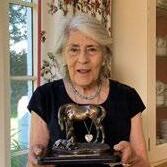
Market Rasen’s midJanuary fixture proved to be an excellent afternoon for breeder Jane Micklethwait (pictured). The novice handicap chase witnessed a first win for the homebred My Portia, a daughter of the Terimon mare Talk The Talk. Despite testing trainer Laura Morgan’s patience with her unruly behaviour in the early days, My Portia, comfortably settled in running to win by four lengths.
The seven-year-old is from an illustrious family, that of Dublin Flyer. Jane and her late husband Richard were encouraged to purchase My Portia’s grandam Free Travel, a winning Royalty half-sister to the Mackeson Gold Cup and Peterborough Chase hero, on the advice of trainer Captain Tim Forster. She would go on to produce the Grade 2-placed Over Sixty (Overbury) and the Grade 2 River Don Novices’ Hurdle winner Diamant Noir (Sir Harry Lewis) – grandam of the Grade 2 scorer and multiple Grade 1-placed Ronald Pump –amongst three winners. Sold as a youngster, Talk The Talk was bought back as a broodmare after making one racecourse start.
Later in the afternoon and the re-arranged Veterans' Chase Final was captured by a rejuvenated Copperhead, who made all and jumped for fun through the threemile contest. The son of Sulamani was a high-class novice, winning a Grade 2. Winless for four years, he returned to the winner's enclosure at Plumpton in May and his veterans' chase victory was his fourth of the season.
“Copperhead was ‘winless’ following a serious injury in the Sun Alliance at Cheltenham after winning the Reynoldstown and it took him a very long time to recover," Jane explained.
"His owner and trainer showed quite incredible patience and trust in him during this time, and it was really wonderful that he has done so well this year.”
TBA members are encouraged to head to either the BHA or TBA website to read more about the Horseracing Industry People Board (HIPB) Workforce Strategy, which was published last month. The TBA has been involved in its development with thorough consultation through a range of breeders and stud farms to ensure the needs of the breeding sector are considered as part of the overall strategy.
How will the strategy benefit the breeding sector?
The strategy is aligned to and complements the TBA’s existing and planned activity in this area already which is co-funded by HBLB with the support of the Racing Foundation on some initiatives and includes:
• Education and learning through online learning platform TB-Ed
• Employer support through TBA initiatives and advice, including employment law support, good employment practice forums, Business Essentials Programme on TB-Ed, CPD opportunities at courses, seminars and conferences
• Stud Employee Accident Benefit Scheme (or SEABS)
• Support for entry level training delivery through the National Stud
Wednesday, March 5
Cheltenham Festival Preview, Zoom
Join us for a bloodstock-focussed preview of the following week’s Cheltenham Festival on Zoom, which will be hosted by Jess Stafford. Sign up by visiting the TBA website.
Monday, May 19
NH Awards Evening, Hilton Garden Inn, Doncaster – TICKETS ON SALE SOON
Celebrate the best of British-breds from the 24/25 NH season, which is held on the evening of the first day of trade at this year’s Goffs Spring Store Sale.
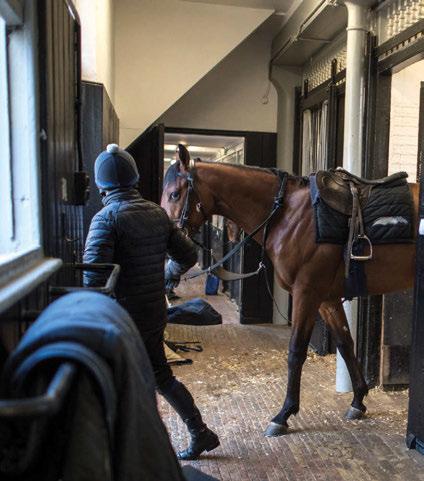
Recruitment and retention of stable and stud staff is a big issue for the sport
What planned activity can we expect to see in 2025 which benefits the breeding sector?
• Mentoring for stud personnel
• A recruitment campaign that will target those potential returners to the industry
• Stud employee data collection to improve our knowledge of the sector specifically
• Development of an employer quality standard scheme to commence in 2026
• Increased support around drug and alcohol use and testing services
Wednesday, July 9
Flat Awards Evening, Chippenham Park, nr Newmarket
The success of all Flat breeders from the 2024 season is celebrated in the stunning surroundings of Chippenham Park on the evening before Newmarket’s July Festival kicks off.
For more information regarding events, as well as to see when regional events have been fixed, either contact the office or check out the regular e-bulletin emails.
JULIAN SELBY
The kind of mare that might make you a TBA Breeder of the Month contender tend to have either been developed over generations or shrewdly picked up at the sales.
Julian Selby’s route to finding Thebelloftheball, dam of January’s winner Don’t Rightly Know through her victory in the Listed Charlie Nugent Memorial Mares’ Chase at Newbury, was a little different.
“Thebelloftheball was bred by Bill Bromley, Chris Down trained her and I used to drive the lorry for him, although I’m really a farmer,” Selby explains.
“It was just one of those funny things. I saw her run quite a lot of times and had always liked her. When I discovered they were going to sell her, I made them an offer and bred from her. I didn’t pay very much; you lose enough money without spending £30,000 on a mare!”
Selby, who supplies specialised chicken to Marks & Spencer from his farm near Tiverton in Devon, gave up his driving sideline after a few years but has always had a love of horses and racing, both under Rules and point-to-points, raising his young stock from shortly after they have been foaled.
“I had some great friends who were keen to get rid of a mare, so I swapped with them for two Charolais heifer calves,” Selby recalls of an early experiment in breeding.
“We ran her point-to-pointing. Back in the days of The Sporting Life she was one of their ten to follow for the season but she never quite delivered.
“I did breed from her, I was a total amateur and she ended up being covered by a stallion called Gargoor, who most people will have forgotten.
“Gargoor produced a horse for me called Can’t Be Scrabble, who won point-to-points but his one big claim to fame was he beat [smart chaser] Ollie Magern round Stratford, getting a stone off him. So he wasn’t totally useless!”
Selby has a great admiration for David Futter of Yorton Farm Stud and tends to follow his advice when it comes to matings nowadays. It has certainly worked with Thebelloftheball, a daughter of Classic Cliche who was a halfsister to the 2014 Grand Sefton Chase winner Poole Master.

Words: Tom Peacock
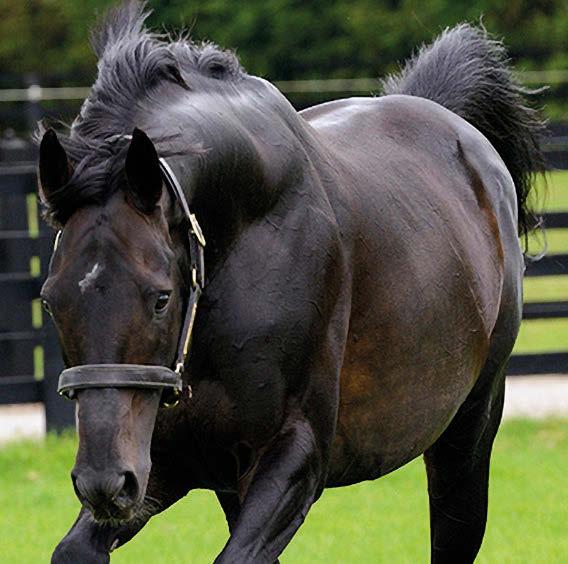
For Don’t Rightly Know, he struck upon Malinas before the high-class German import was moved to Ireland.
Just like her mother, whose only victory came at Exeter, Don’t Rightly Know has had a clear affinity for Haldon Hill and bolted up there over hurdles in 2023 before another strike just before Christmas on her chasing debut. She made it three wins at Exeter in a Listed contest on February 21.
It has been a lengthy process for trainer Polly Gundry to get Don’t Rightly Know to black-type level over fences, given the mare is now ten.
“She won a point-to-point, then we ran her at Stratford the following October, she had a leg, waited a year, was second at Uttoxeter in a mares’ novice hurdle, had heat again, we waited another year,” Selby explains.
“After that, it had been a very dry summer and Polly could never find the ground she was happy with. So she’s really had three years off.”
What was Gundry’s biggest success as a trainer was also Selby’s.
Don’t Rightly Know had already earned some black type when runner-up in a Grade 2 novice hurdle at Haydock but her slick jumping and accomplished front-running performance under Harry Cobden to defeat the top-class mare Apple Away in Berkshire was far more memorable.
“She’s only been out the first three once up until now,” says Selby.
“It gives me a hell of a thrill because I want to breed from her. I’m not sure when. I imagine if not this year, then next.”
Selby shares the odd broodmare at the moment, and the signs are promising for him to refresh his portfolio. While Thebelloftheball’s first two foals showed what he describes as “a hint of ability”, her youngest daughter by Blue Bresil called Only Gossip also won a point-to-point for Edward Walker before moving to Gundry’s care.
“She only had four foals, all fillies, and she only bred every other year,” he says.
“Don’t Rightly Know is probably the best but Polly swears blind that the half-sister is better, she just hasn’t shown it yet. She’s improving and has been third at Wincanton. You keep hoping, don’t you?”
ELDAR ELDAROV

NEW SIRE FOR 2025

CHAMPION 3YO STAYER & DUAL CLASSIC WINNER
DUAL ST LEGER WINNER
Won Gr.1 St Leger Stakes, Doncaster
Won Gr.1 Irish St Leger, Curragh
Won Gr.2 Queen’s Vase, Royal Ascot Won 2yo Maiden on debut by 2l Earnings over £1m Timeform: 122
BY DUBAWI - CHAMPION SIRE & SIRE OF SIRES
From the family of ALPINISTA, ALBORADA, etc. Out of ALL AT SEA (SEA THE STARS), a 1m2f Stakes winning daughter of ALBANOVA.
Fee: £5,000 1st October SLF

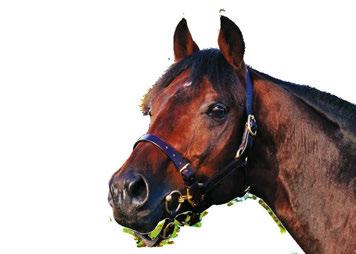
WELL BRED, TOUGH & CONSISTENT STAKES WINNER
WON/PLACED IN 8 STAKES RACES
Including winning the Gr.2 York Stakes, Gr.3 Classic Trial and L Winter Derby Trial (twice).
OUTSTANDING PEDIGREE
Half-brother to 6 Stakes horses including Gr.2 2yo and 3yo THE FOXES and Gr.1 winner MATTERHORN. Only son of AUSTRALIA to stand in GB.
Fee: £3,000 1st October FFR

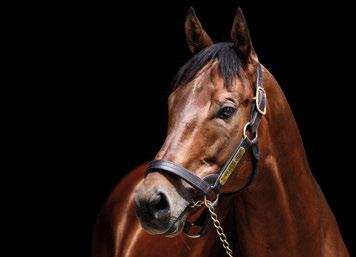
SIRE OF GR.1 WINNERS ON THE FLAT & OVER JUMPS
SIRE OF CHAMPION STAYER TRUESHAN & GR.1 CHASE WINNER GRAN DIOSE
52% winners to runners. Tough, sound and versatile progeny from 2yos and up, fat or jumps.
PATERNAL HALF-BROTHER TO THE LATE JEREMY, A LEADING NH SIRE
Highest earning son of DANEHILL DANCER.
Fee: £4,000 1st October FFR
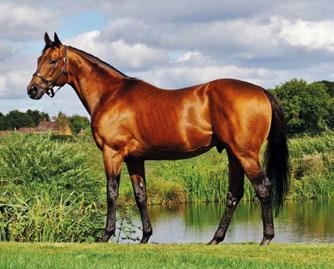


Total print readership exceeds 20,000 per month – Europe’s most widely read monthly horseracing magazine A proven, tried and trusted publication with advertising packages available from just £305 per month
The ITBA was delighted to host its annual National Breeding & Racing Awards at The Heritage, Co Laois on Saturday, January 25.
The achievements of Irish breeders and Irish-bred horses were celebrated in style at the glittering black-tie event. Newly appointed Minister for Agriculture Martin Heydon, along with Nina Carberry MEP and Senator Fiona O’Loughlin, were guests of honour on the night which welcomed over 360 attendees. The event brought together prominent figures from the Irish and international bloodstock industry to celebrate the outstanding success of our winners in both Flat and National Hunt during 2024.
We congratulate all award recipients and thank our generous sponsors for their continued support. Recognised for her industry achievements and contributions, Eimear Mulhern was inducted into the ITBA Hall of Fame, presented by ITBA Chairman Cathy Grassick and Minister for Agriculture Martin Heydon.
Westmeath native John Connaughton was the well-deserved recipient of the Small Breeder Award thanks to the exploits of Group 2 winner Bay City Roller, whose award was presented by Maurice Moloney of
Special Presentation
Brenda Shortt
National Hunt Race Mare Award
Limerick Lace, bred by Mrs Noreen McManus
Novice Chaser of the Year Award
Corbett’s Cross, bred by Ger Murphy
Hurdler of the Year Award
Ballyburn, bred by The Beeches Stud Ltd
Chaser of the Year Award
Hewick, bred by William Quinn
Small Breeder Award
John Connaughton
Coolmore Stud. Honouring the Irish expats, James Keogh of Grovendale Sales was recipient of the Wild Geese Award, presented by fellow American Tony Lacy of Keeneland.
One of racing’s greats, Classicwinning jockey and 13-time Irish champion jockey Michael Kinane, was presented with the Lifetime Achievement Award, presented by Suzanne Eade of Horse Racing Ireland. This year’s Next Generation Award was presented by Ballylinch Stud’s John O’Connor to young breeders Barry Kennedy and Anna Murphy of Rigsdale Stud, breeders of Maria Branwell and Lexington Belle. Also honoured on the night was Brenda Shortt, who received a Special Presentation for her ongoing contribution to the industry over the last 36 years, presented by Joe Hernon.
Robert McCarthy of The Beeches Stud, breeder of multiple Grade 1 winner Ballyburn, accepted the award for Hurdler of the Year, presented by Simon Kerins of Tattersalls Ireland. Mrs Catherine Cashman of Rathbarry Stud presented the Older Horse Award to Henrietta Egan who represented breeders Corduff Stud and TJ Rooney for the accolades of multiple international Group/Grade 1 winner Romantic Warrior.

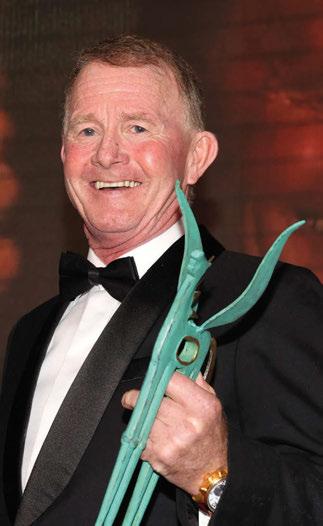
Michael Kinane scooped the Lifetime Achievement Award
2YO Filly of the Year was the unbeaten Lake Victoria, bred by Coolmore and presented by Ludovico Cornuel of Arqana. Ana O’Brien of Whisperview Trading accepted the award for Joint 2YO Colt of the Year Expanded, as well as 3YO Filly of the Year Porta Fortuna. Henry Beeby of Goffs presented the 3YO Male of the Year Award to Princess Zahra of HH The Aga Khan Studs for the exploits of Calandagan.
Next Generation Award
Barry Kennedy and Anna Murphy
Older Horse Award
Romantic Warrior, bred by Corduff Stud and TJ Rooney
2 Year Old Filly of the Year Award
Lake Victoria, bred by Coolmore Stud
Joint 2 Year Old Colts of the Year Award
The Lion In Winter, bred by Sunderland Holding Inc
Expanded, bred by Whisperview Trading Ltd
3 Year Old Filly of the Year Award
Porta Fortuna, bred by Whisperview Trading Ltd
3 Year Old Male of the Year Award
Calandagan, bred by Haras De Son
Altesse L’Aga Khan Scea
Wild Geese Award
James Keogh
Lifetime Achievement Award
Michael Kinane
Hall of Fame
Eimear Mulhern

Graham Dench asks our jury the big questions: Would a series of ‘win and you’re in’ races improve the make-up of the modern Grand National and benefit a broader base of owners and trainers?
Kim Bailey Grand National-winning trainer
“
I think the Grand National is the one race that it would work for. I would be very much in favour because if something isn’t done, the race will have lost its appeal within two years.
It would have to be very selective – no more than half a dozen races – but I think that if you win the Welsh National, the Scottish National, the Irish National or the Midlands National, and let’s say the Peter Marsh or the Grand National Trial at Haydock, you ought to be automatically eligible to run at Aintree.
Ten years or so ago you’d have got in the National on merit anyway if you’d won one of those contests, and it’s only because of the changed nature of the race and the reduced field size that most winners of those races wouldn’t make it now.
Nowadays the fences are so small that people realise that almost anything can jump them, and the prize-money is so good at last that it’s become almost like a Grade 1 chase,
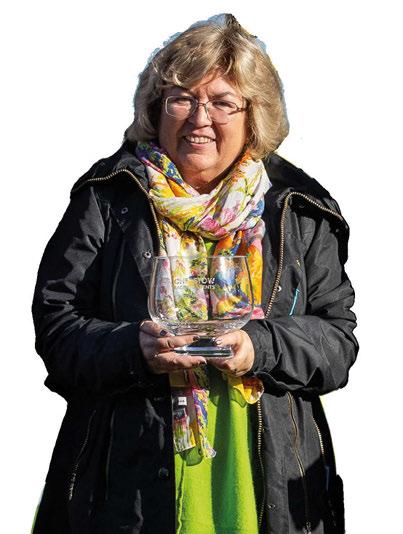
albeit on limited handicap terms, and so liable to be dominated by Gold Cup types from just a couple of stables.
While it’s great that trainers want to aim the best horses in the country at the race, the opportunity needs to be there for proper Grand National types to compete too, even if it means taking a few higher rated horses out of the race.
‘Win and you’re in’ status for Aintree would also be a very attractive carrot for those racecourses putting on the races to be able to offer.
The prime example this year of a horse who should be running but has no chance of getting in is Sara Bradstock’s Mr Vango, who won the Peter Marsh. He’s a proper National type and on soft ground he’d be just the horse for the race. He’d have much wider public appeal too than most of those Gold Cup horses.
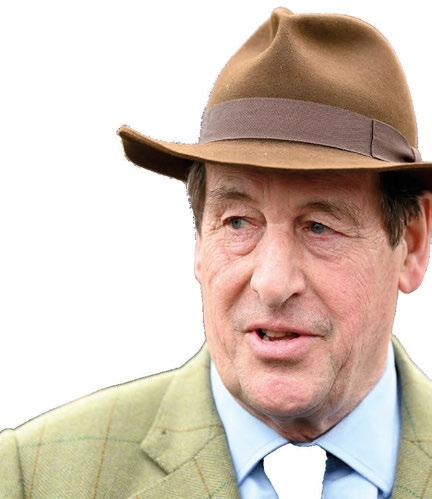
“
I agree that interest in the Grand National and some other big races would benefit from more diversity among the owners and trainers with runners than we are often seeing nowadays, but I don’t think that ‘win and you’re in’ races are the answer.
If I was lucky enough to win a Welsh National with a horse rated 130 or 135 and was guaranteed a place in the Grand National field that way, then I would be very embarrassed about running at Aintree against horses rated 150 or whatever with no realistic chance of winning, and at the same time knowing that we had kept another horse who had
earned his place through his rating out of the race.
I think that in races like the Grand National and all those Grade 1 races, you’ve got to be entitled to be there on your merits.
Some people have suggested placing a limit of maybe five runners on owners and trainers in races like the Grand National as another way of giving a wider range of people a chance to be involved, but it wouldn’t be too difficult to find ways around that and, again, I think if a horse has earned his place in a race through his rating, then he should be allowed to run.
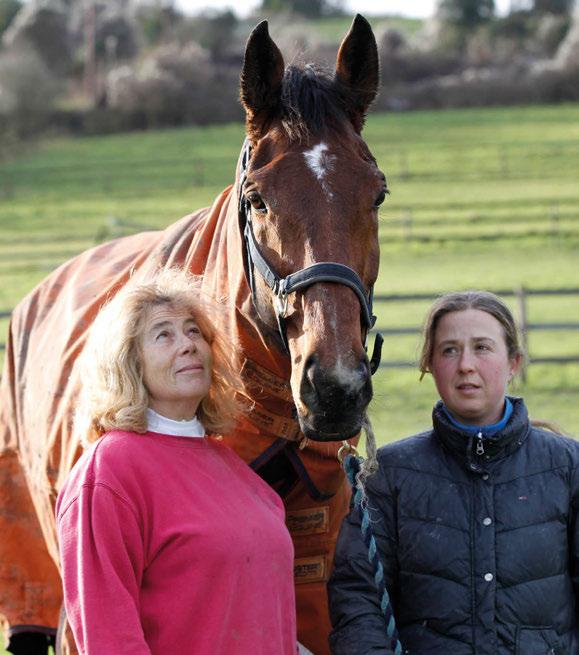
Ray Anderson Green Owner of more than 500 NH winners
It’s a definite yes from me. Nowadays you have to be 145plus to have a chance of getting a run and a series of ‘win and you’re in’ races would add some excitement and give a few more owners and trainers a chance which they no longer have.
It would allow one or two progressive types with slightly lower ratings a chance to get a run, and also some of those old-fashioned staying chasers that the Grand National used to be all about. It would add a bit of interest for the wider owning fraternity, and also I think for the wider public.
In addition, it would make the qualifying races more competitive too – and I’m thinking here of races like the Welsh National, Eider, National Hunt Chase at Cheltenham and Edinburgh National at
“
I think it’s extraordinary that a horse can be the best of the British in last year’s National Hunt Chase at Cheltenham, win the Devon National by 60 lengths, and this season win the London National and the Peter Marsh yet be nowhere near getting into the Grand National. It’s a bit of a mockery of what the Grand National ought to be all about.
We all know Mr Vango (pictured with his trainer) needs soft ground, which they probably won’t get at Aintree, but it does happen now and again and on proper soft ground he’d have a real chance – and a much better one than many of those that are guaranteed a place ahead of him.
If all those horses in the 150s and upwards had form in the last six months to justify those ratings, I wouldn’t mind so much them getting in ahead of Mr Vango, but it seems a bit crazy that he’s done what he’s done and isn’t anywhere near getting in. I think it’s a shame, not just for us but for the race itself that horses with a bit of back form in Gold Cups and so on are getting in ahead of proper Grand National types.
‘Win and you’re in’ races ought to help, but I also think it’s not good for the race that one owner, and maybe one or two trainers, can monopolise it.
I don’t know how it could be done, and it wouldn’t be popular with some, but surely a limit of three or four runners for any one stable or any one owner ought to be more than enough.

Musselburgh, now a 0-150.
My best-ever horse, Sparky Gayle, who won the Cathcart, ran in the Grand National in 2000 and was first past the post, but unfortunately poor Brian Storey had been knocked out of the saddle at the second fence by a horse belonging to my good friend Trevor Hemmings. Even on his peak rating, Sparky Gayle would probably only just scrape into a modern Grand National.
As a Scotsman, my priority was always to try to win the Scottish National, and Merigo won it twice. He also won an Eider Chase, so in many ways he would have been an ideal Grand National type if we’d wanted to go that way, but his best rating of 142 probably wouldn’t get him close to a run at Aintree this year.
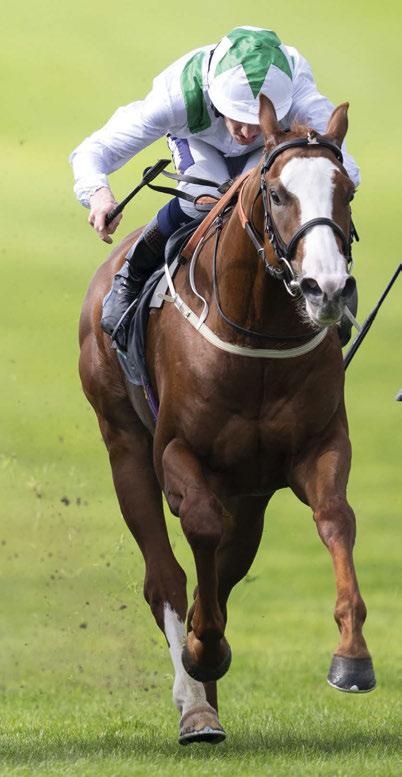
“ ”
“ ”
DUBAI MILE was a very smart colt, with a great mind. A very sound horse with clean wind, he displayed many of the attributes trainers are looking for in a racehorse – ability to handle all ground & found plenty for pressure.
Mark Johnson
“Could not have been braver. racing Post ”
ROARING LION proved with his sole crop of offspring that he could transmit abundant class, stamina and tenacity, and to that list of positive attributes we might now add durability. Those Roaring Lion five-year-olds remaining in training will fit right in with the elite broodmares at Tweenhills upon their retirement, very possibly with even more Pattern race successes on their records, considering their sadly short-lived sire is becoming a byword for robustness and resolution.
Martin stevens

I have a nice Palace Pier colt out of Group 2 and dual Listed winner Unforgetable Filly. He has a great attitude, and I couldn’t be happier with him. He looks a runner and that’s what matters.’
George Boughey
I have two Palace Piers and I’m very happy with them. They are both athletic, forwardgoing horses that are showing me the right signs. It is hard to imagine they won’t be winning races this year.’
Ed Walker
The two Palace Piers I train have settled in well and have great attitudes. They’re very good-moving, straightforward horses. I am looking forward to taking them to the races.’
Francis-Henri Graffard
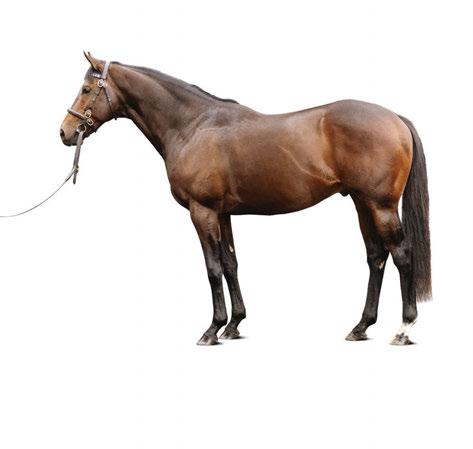

We are lucky enough to have three Palace Pier two-year-olds. They are lovely types who have plenty of quality and are doing everything right.’
Archie Watson
I have one Palace Pier. He is a lovely, scopey colt with a great attitude and I will definitely be looking at the Palace Piers come the breeze-up sales.’
William Knight
Stands at Dalham Hall Stud, UK